More Photo Galleries
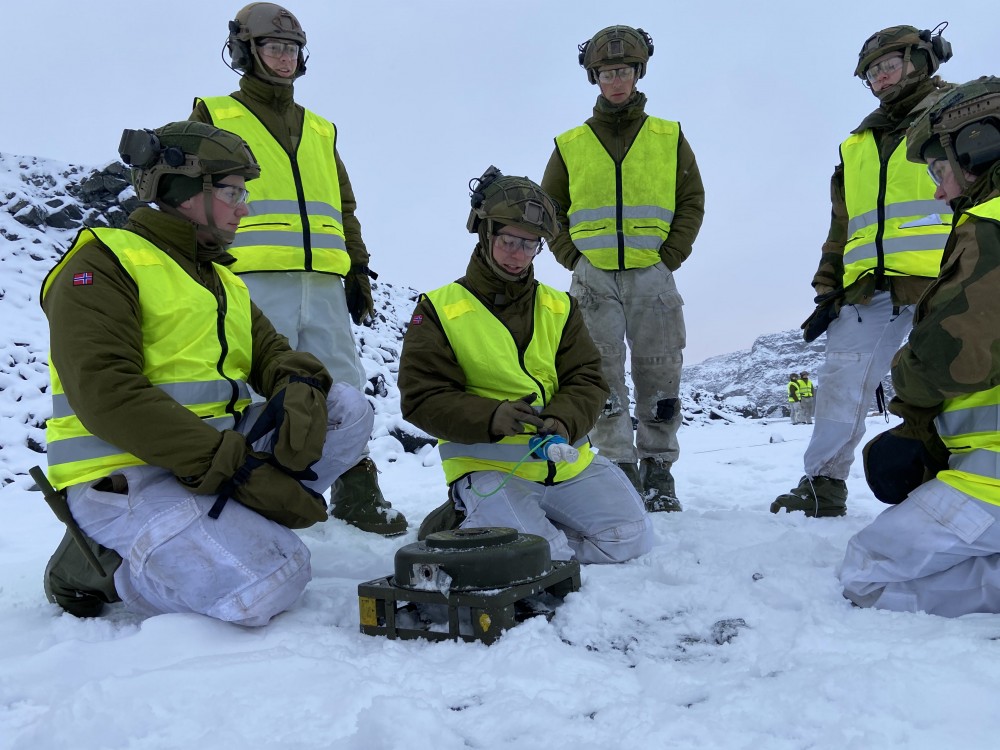 CLICK FOR MORE PHOTOS. The soldiers with the engineering squad make ready one of the anti-tank mines. Photo: Thomas Nilsen
CLICK FOR MORE PHOTOS. The soldiers with the engineering squad make ready one of the anti-tank mines. Photo: Thomas Nilsen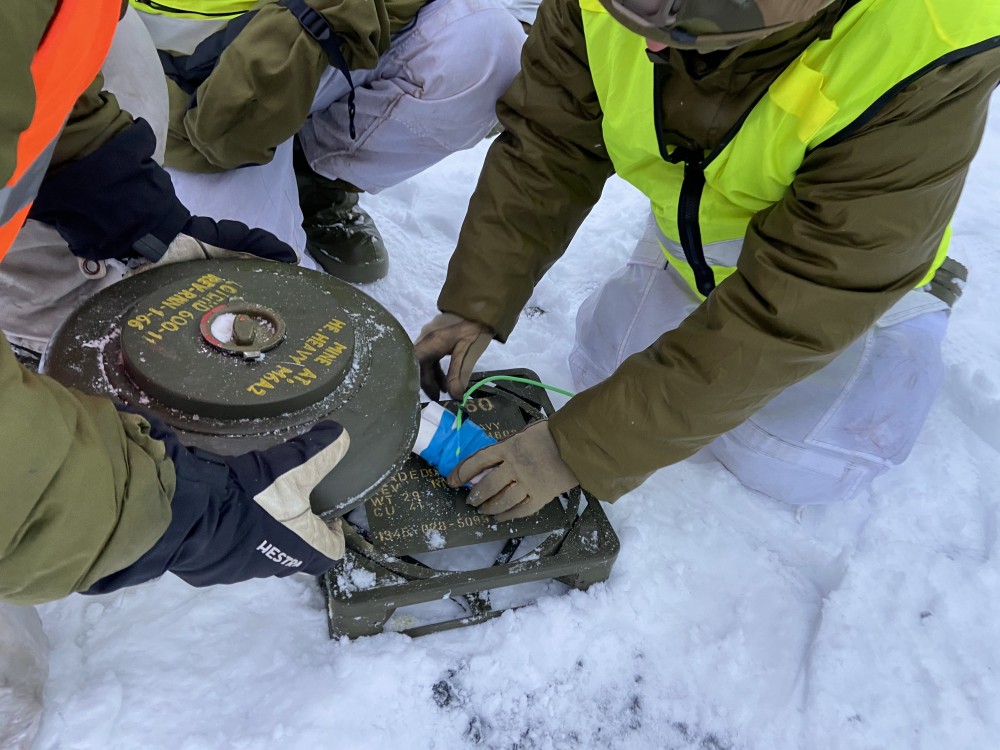 Ultimost careful when handling high-explosives. Photo: Thomas Nilsen
Ultimost careful when handling high-explosives. Photo: Thomas Nilsen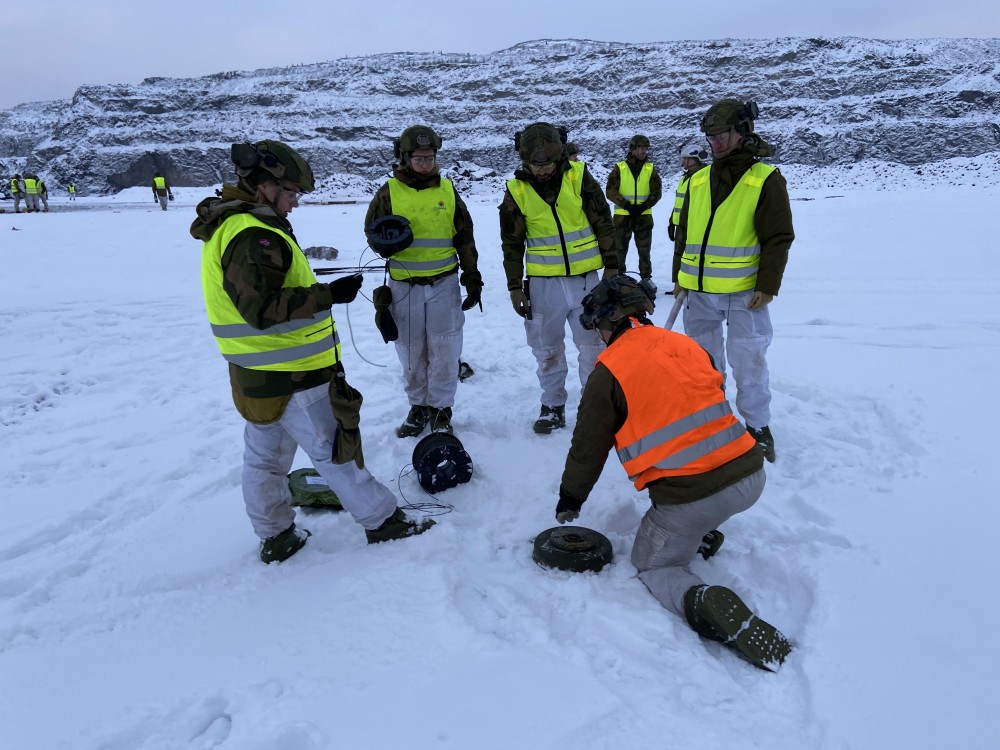 The training ground for detonating explosives is down deep in a closed open-pit iron-ore mine near Kirkenes. Photo: Thomas Nilsen
The training ground for detonating explosives is down deep in a closed open-pit iron-ore mine near Kirkenes. Photo: Thomas Nilsen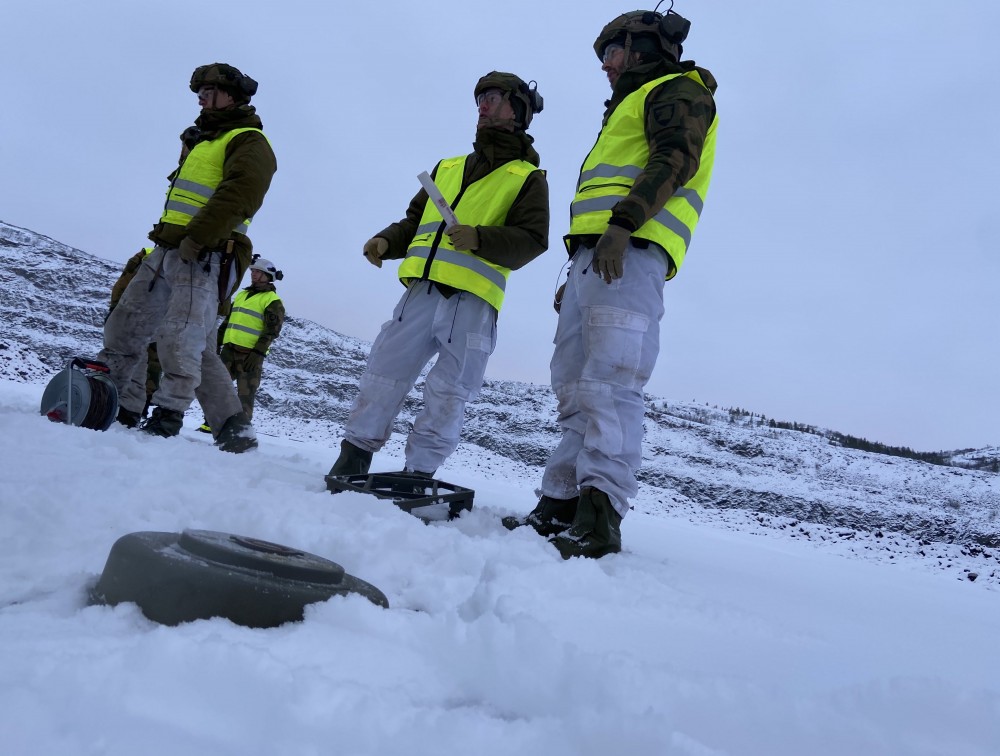 Anti-tank mine on the ground is made ready. Photo: Thomas Nilsen
Anti-tank mine on the ground is made ready. Photo: Thomas Nilsen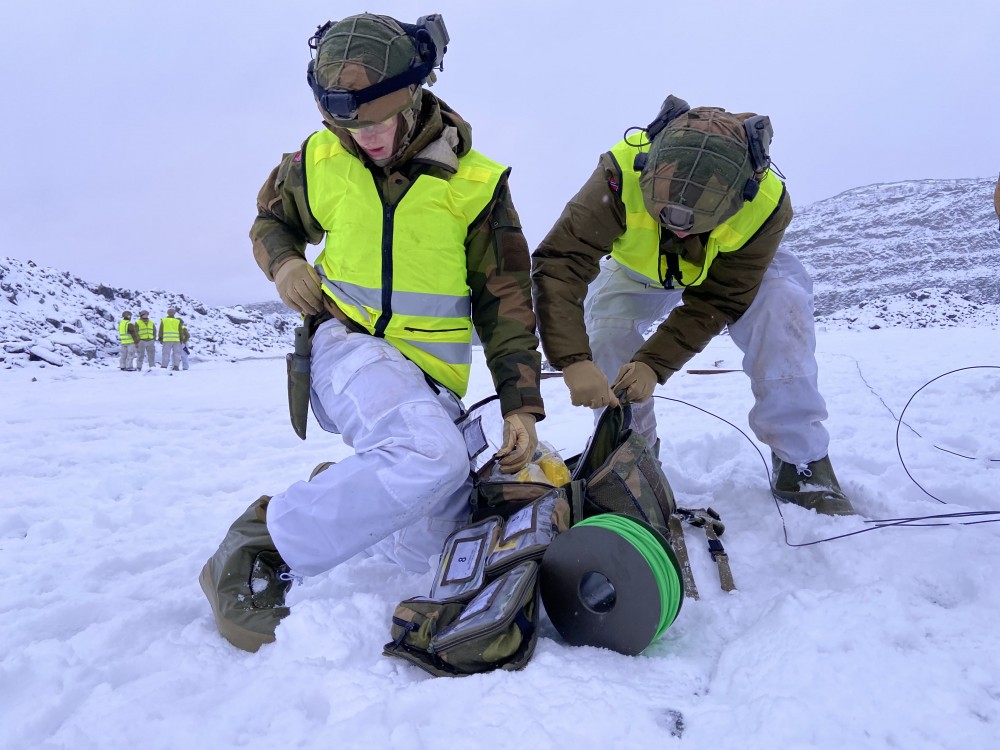 All gear has to be double-checked. Safety is everything when dealing with explosives and weapons. Photo: Thomas Nilsen
All gear has to be double-checked. Safety is everything when dealing with explosives and weapons. Photo: Thomas Nilsen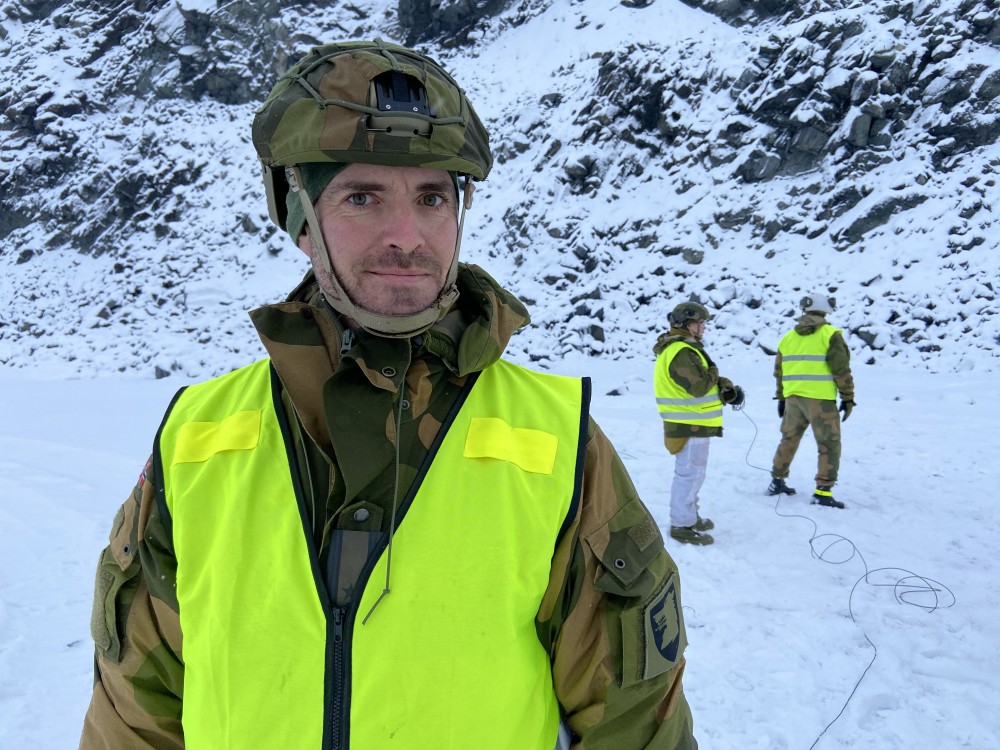 Chief of the Garrison of Sør-Varanger, Lieutenant Colonel Michael Rozmara. Photo: Thomas Nilsen
Chief of the Garrison of Sør-Varanger, Lieutenant Colonel Michael Rozmara. Photo: Thomas Nilsen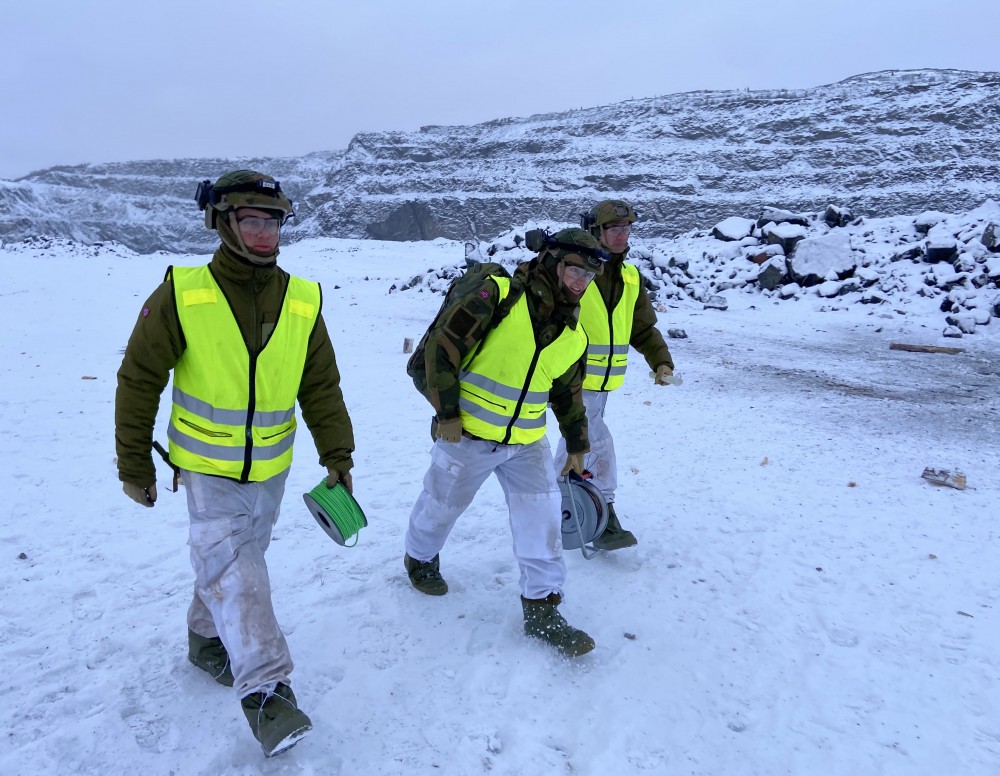 Walking to a safe distance before blowing up the anti-tank mine. Photo: Thomas Nilsen
Walking to a safe distance before blowing up the anti-tank mine. Photo: Thomas Nilsen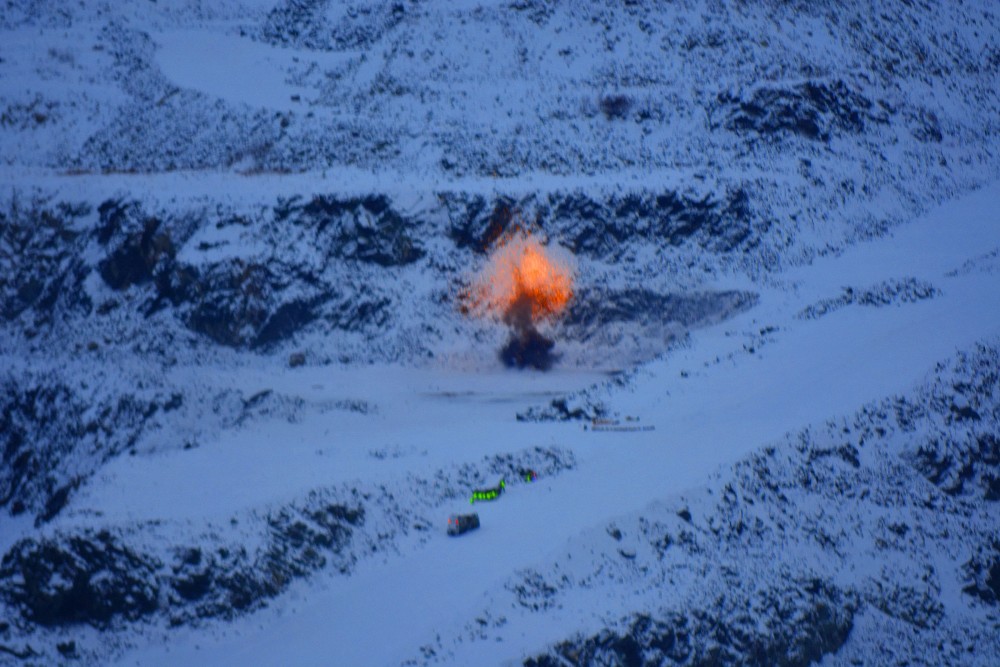 The blast as seen through the lens of Barents Observer's camera at a distance of a kilometer. Photo: Thomas Nilsen
The blast as seen through the lens of Barents Observer's camera at a distance of a kilometer. Photo: Thomas Nilsen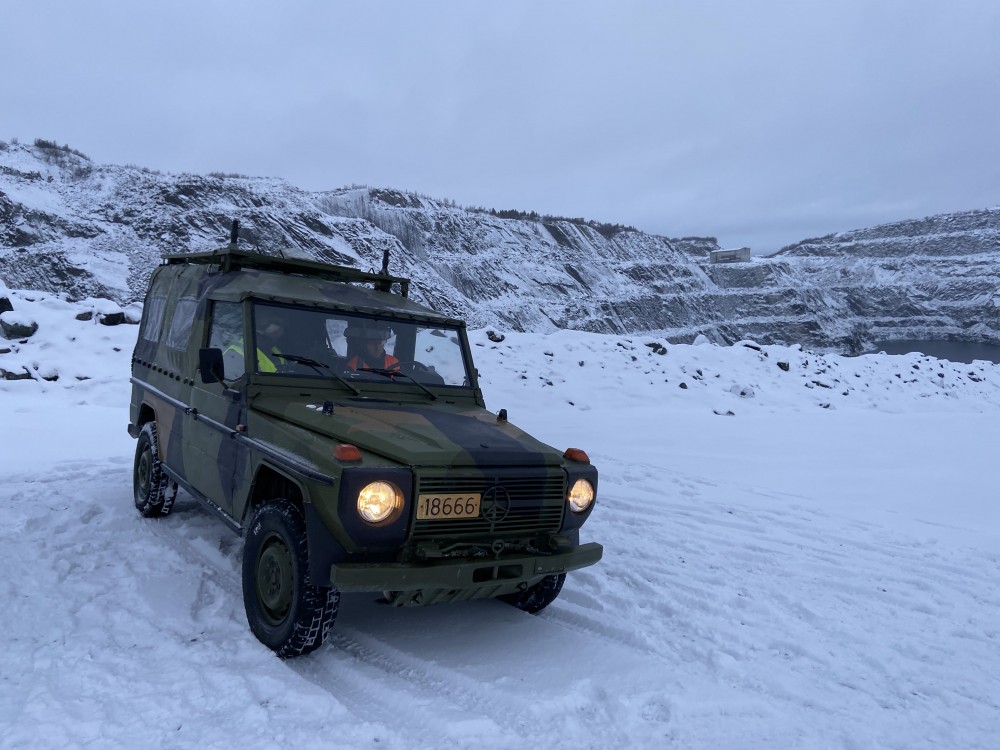 Military vehicle in the open-pit mine. Photo: Thomas Nilsen
Military vehicle in the open-pit mine. Photo: Thomas Nilsen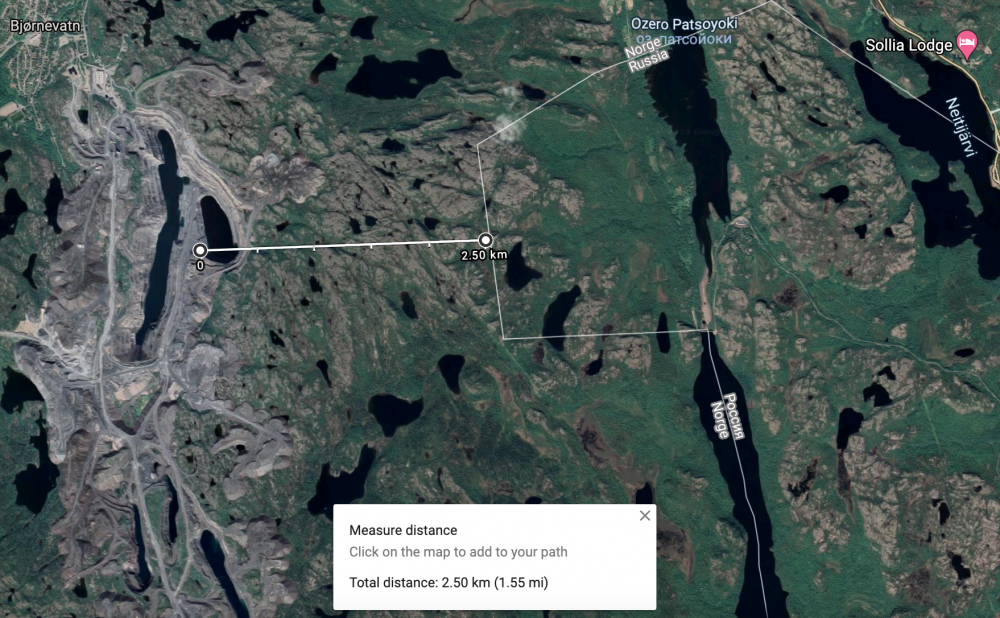 The blast took place in the open-pit mine of Sydvaranger iron-ore company at a distance of 2,5 kilometers from the border to Russia. Photo by Google maps
The blast took place in the open-pit mine of Sydvaranger iron-ore company at a distance of 2,5 kilometers from the border to Russia. Photo by Google maps
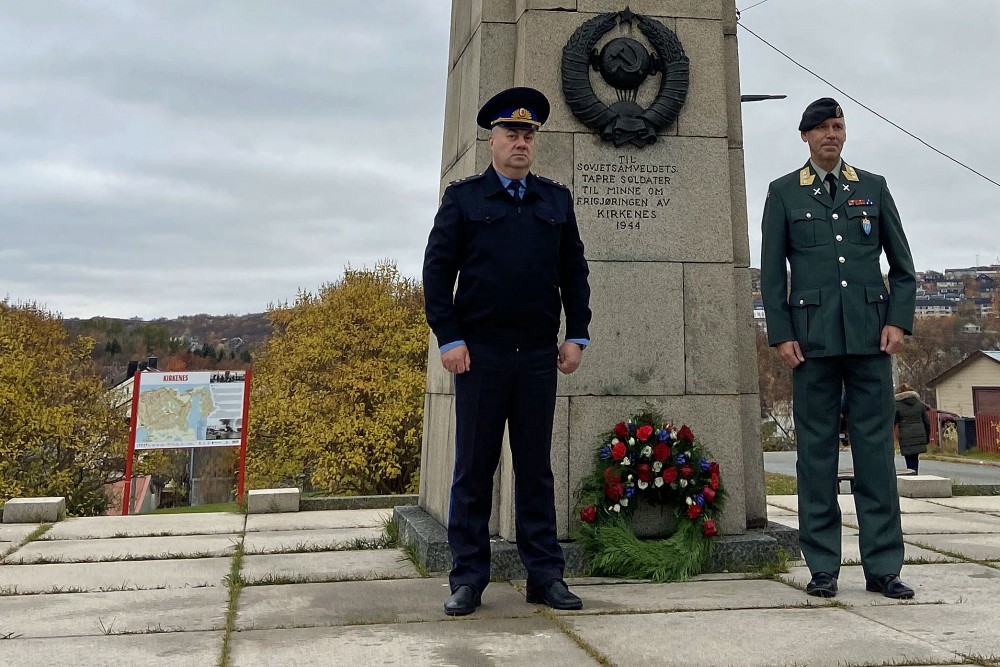 September 30, 2021: Chief FSB Border Guard Directorate, Lt.Gen. Stanislav Maslov (left) and Chief of the Norwegian Joint Head Quarters (NJHQ), Lt. Gen. Yngve Odlo, lay wreath at the monument in memory of the Red Army soldiers that liberated Kirkenes in October 1944 from Nazi-German occupation. Photo: Thomas Nilsen
September 30, 2021: Chief FSB Border Guard Directorate, Lt.Gen. Stanislav Maslov (left) and Chief of the Norwegian Joint Head Quarters (NJHQ), Lt. Gen. Yngve Odlo, lay wreath at the monument in memory of the Red Army soldiers that liberated Kirkenes in October 1944 from Nazi-German occupation. Photo: Thomas Nilsen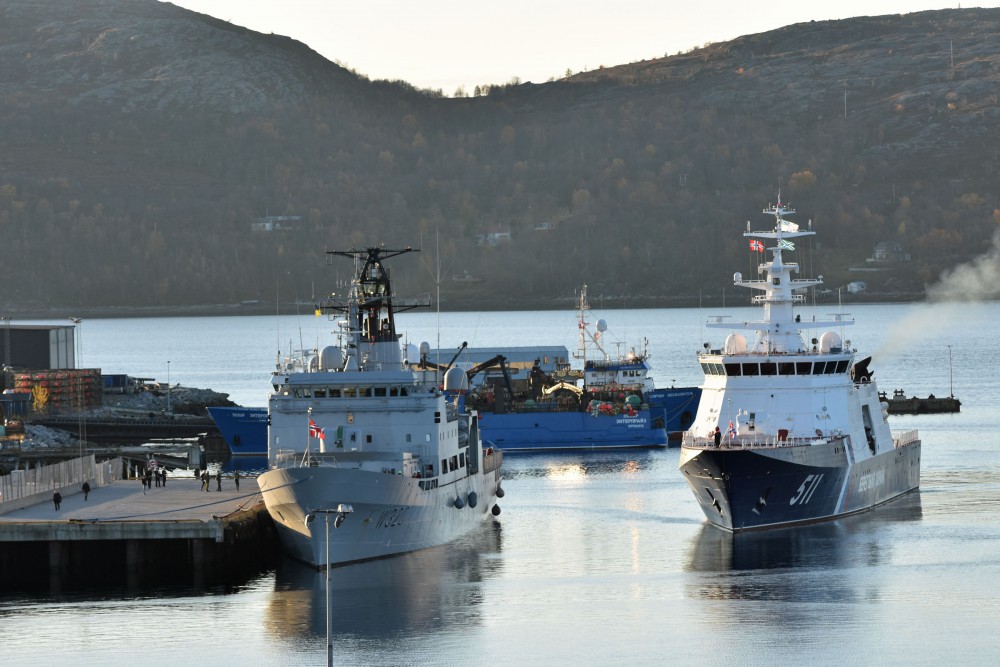 FSB Coast Guard vessel "Polyarnaya Zvezda" made port call to Kirkenes, alongside Norwegian Coast Guard vessel "KV Nordkapp" on September 29, 2021. Photo: Thomas Nilsen
FSB Coast Guard vessel "Polyarnaya Zvezda" made port call to Kirkenes, alongside Norwegian Coast Guard vessel "KV Nordkapp" on September 29, 2021. Photo: Thomas Nilsen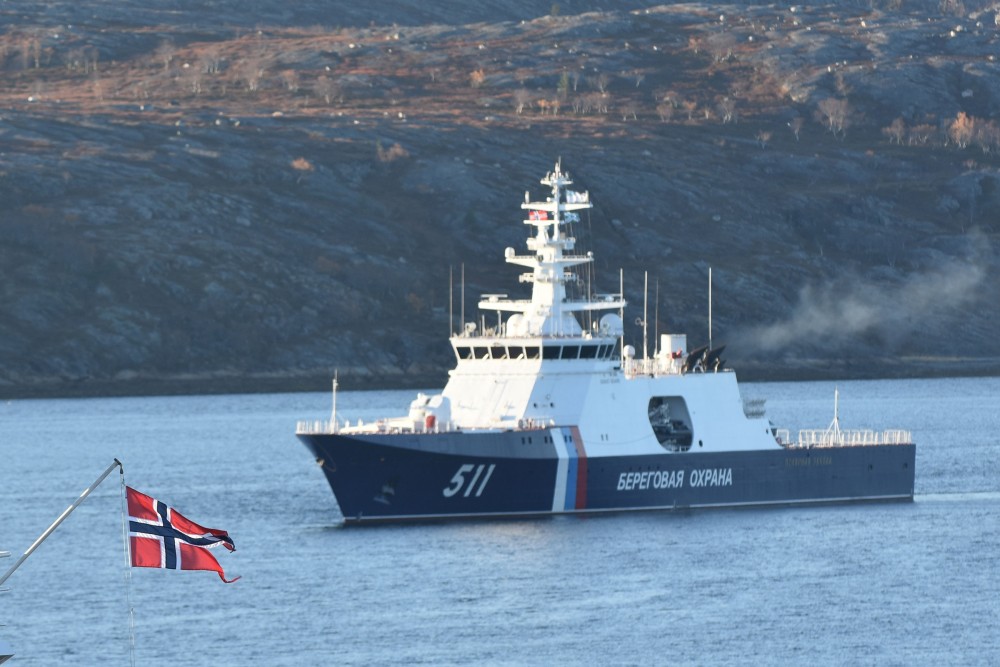 FSB Coast Guard vessel "Polyarnaya Zvezda" sailing Bøkfjorden, Kirkenes. Photo: Thomas Nilsen
FSB Coast Guard vessel "Polyarnaya Zvezda" sailing Bøkfjorden, Kirkenes. Photo: Thomas Nilsen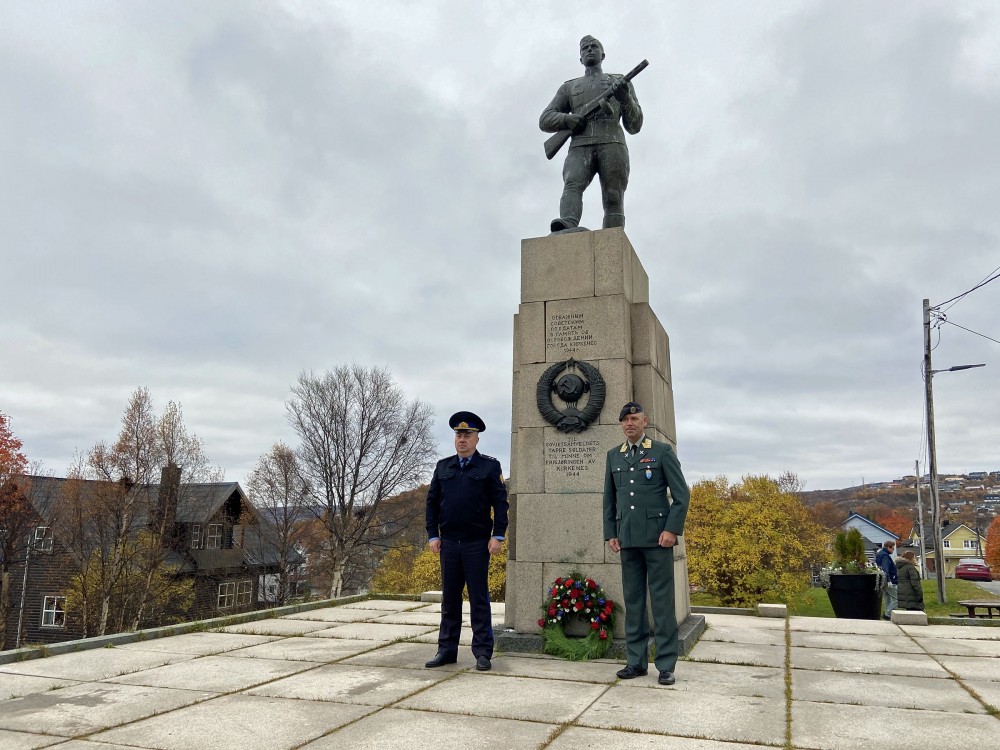 Chief FSB Border Guard Directorate, Lt. Gen. Stanislav Maslov (left) and Chief of the Norwegian Joint Head Quarters (NJHQ), Lt. Gen. Yngve Odlo, lay wreath at the monument in memory of the Red Army soldiers that liberated Kirkenes in October 1944 from Nazi-German occupation. Photo: Thomas Nilsen
Chief FSB Border Guard Directorate, Lt. Gen. Stanislav Maslov (left) and Chief of the Norwegian Joint Head Quarters (NJHQ), Lt. Gen. Yngve Odlo, lay wreath at the monument in memory of the Red Army soldiers that liberated Kirkenes in October 1944 from Nazi-German occupation. Photo: Thomas Nilsen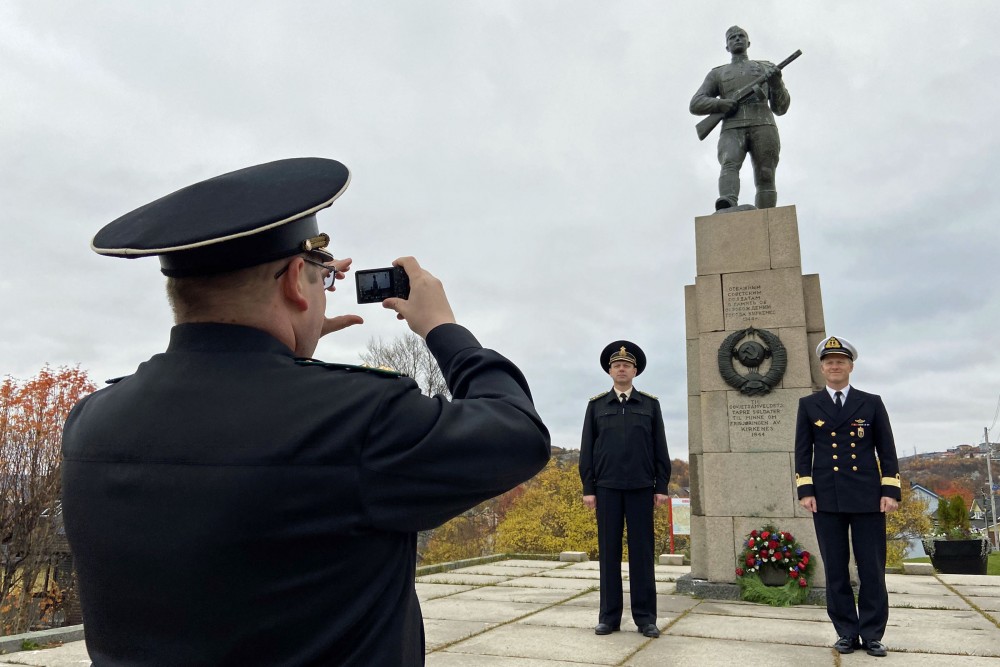 Norwegian and Russian Coast Guard Commanders, September 30, 2021. Photo: Thomas Nilsen
Norwegian and Russian Coast Guard Commanders, September 30, 2021. Photo: Thomas Nilsen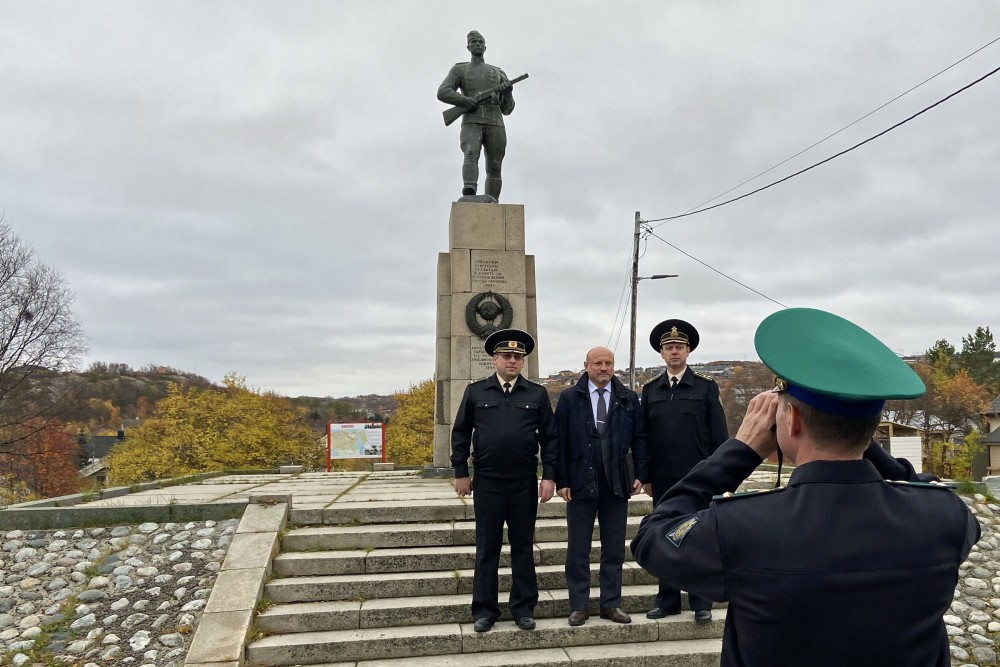 Russian FSB Border Guard officials. Photo: Thomas Nilsen
Russian FSB Border Guard officials. Photo: Thomas Nilsen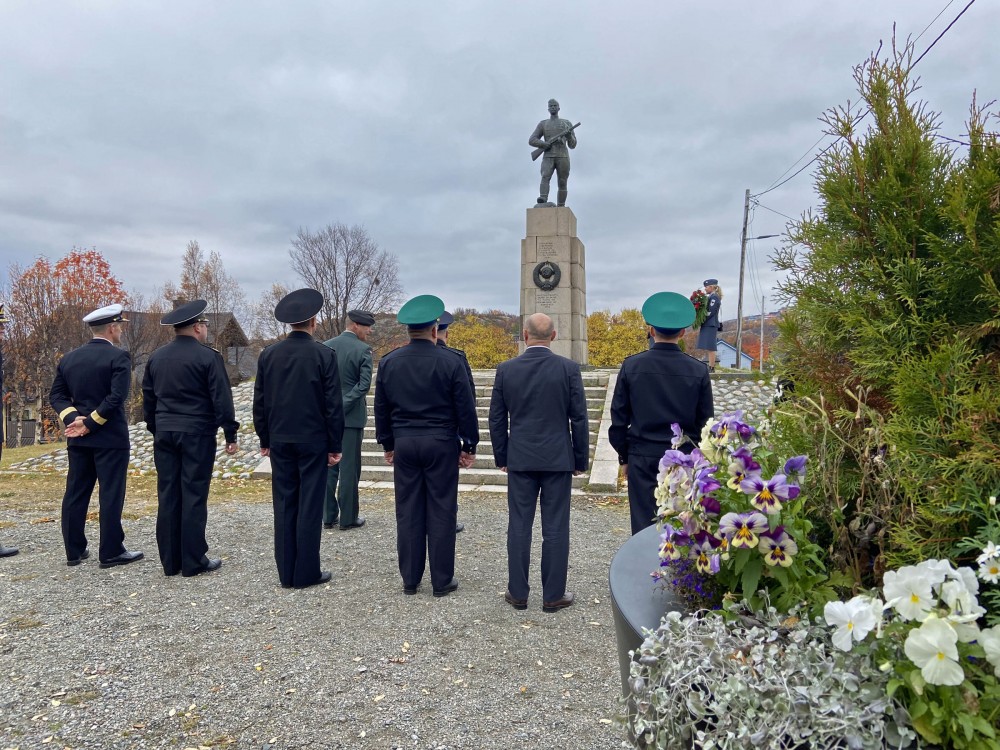 Norwegian military officers and Russian FSB officials at the monument in memory of the Red Army's liberation of Kirkenes from Nazi-German occupation, October 1944. Photo: Thomas Nilsen
Norwegian military officers and Russian FSB officials at the monument in memory of the Red Army's liberation of Kirkenes from Nazi-German occupation, October 1944. Photo: Thomas Nilsen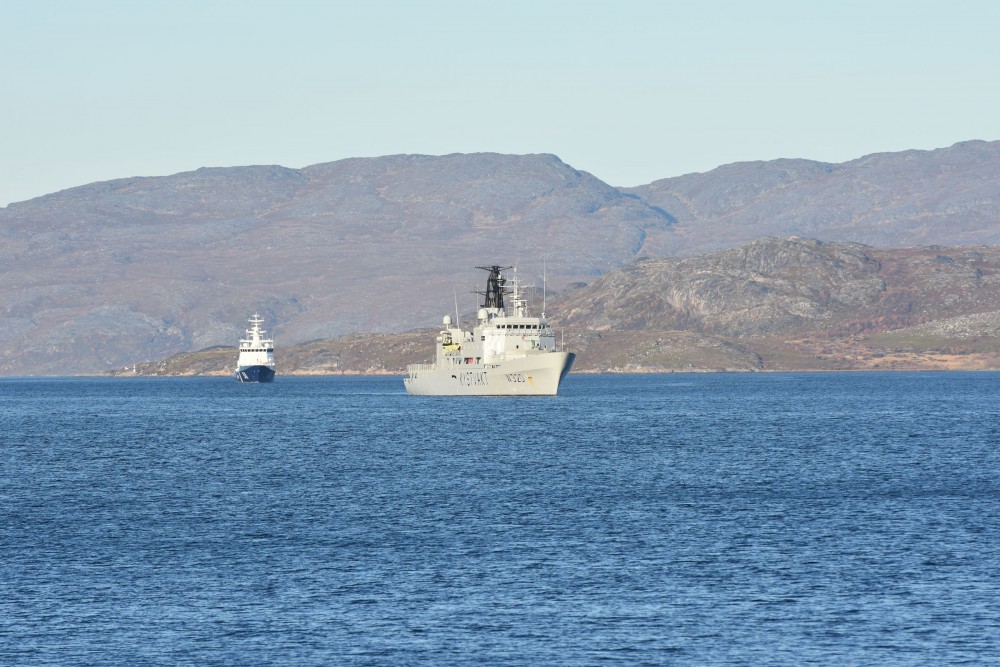 Norwegian Coast Guard vessel "KV Nordkapp" and Russian FSB Coast Guard vessel "Polyarnaya Zvezda" sailing in Bøkfjorden towards Kirkenes, Norway. Photo: Thomas Nilsen
Norwegian Coast Guard vessel "KV Nordkapp" and Russian FSB Coast Guard vessel "Polyarnaya Zvezda" sailing in Bøkfjorden towards Kirkenes, Norway. Photo: Thomas Nilsen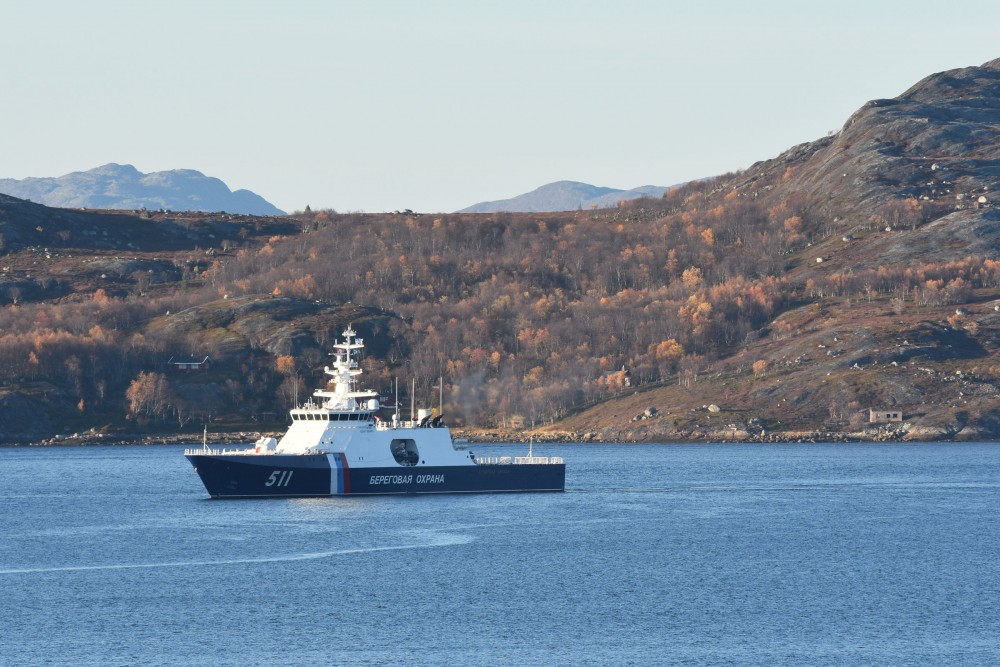 Russian FSB Coast Guard vessel "Polyarnaya Zvezda" in Norwegian waters outside Kirkenes. Photo: Thomas Nilsen
Russian FSB Coast Guard vessel "Polyarnaya Zvezda" in Norwegian waters outside Kirkenes. Photo: Thomas Nilsen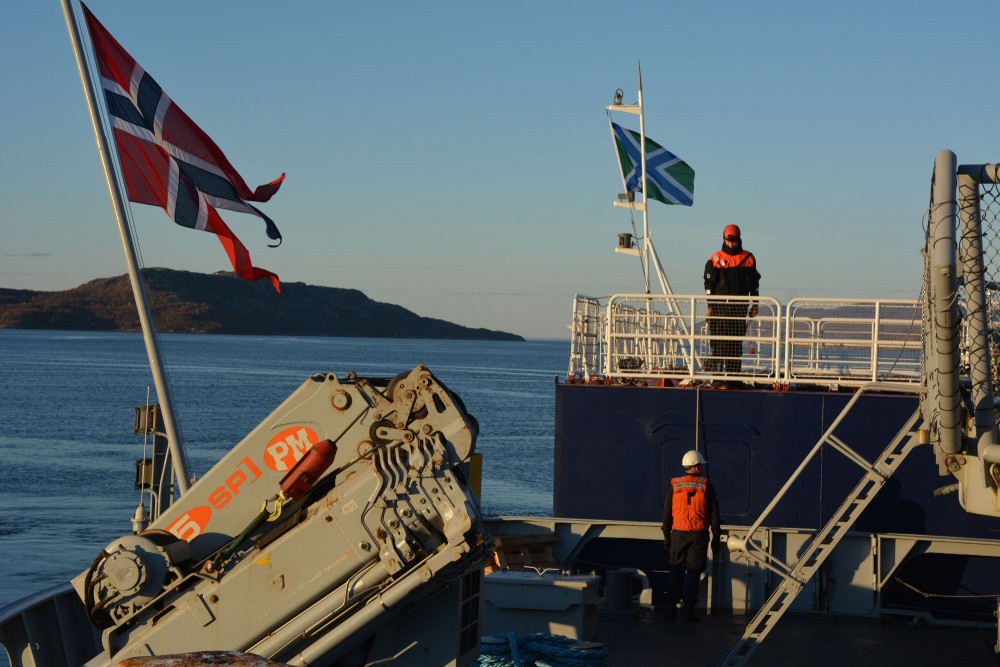 The two countries' coast guard vessels at port in Kirkenes. Photo: Atle Staalesen
The two countries' coast guard vessels at port in Kirkenes. Photo: Atle Staalesen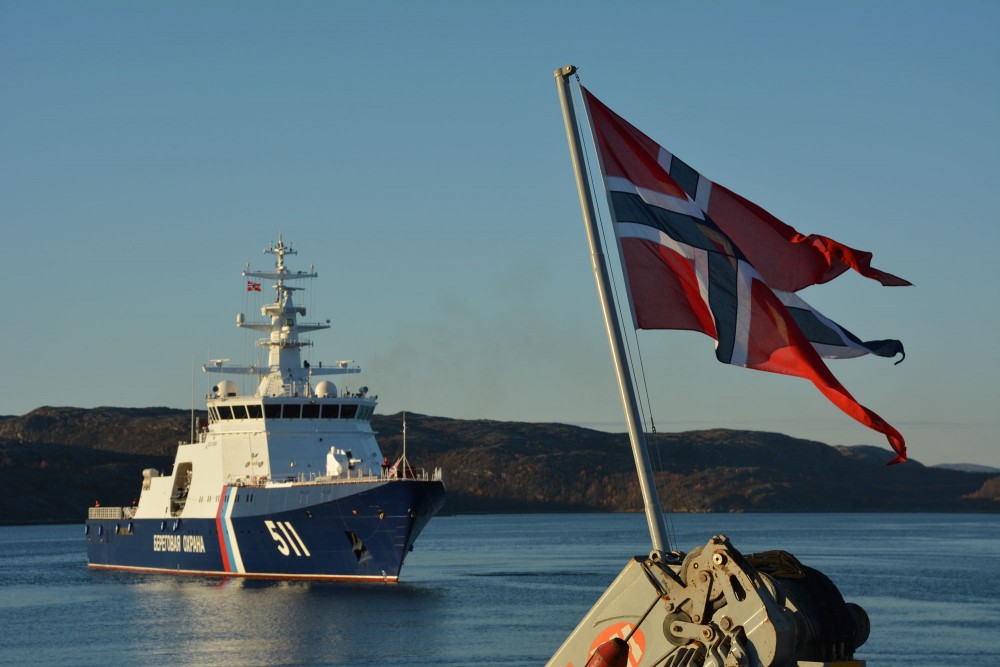 The FSB coast guard vessel "Polyarnaya Zvezda" arrives to Kirkenes. Photo: Atle Staalesen
The FSB coast guard vessel "Polyarnaya Zvezda" arrives to Kirkenes. Photo: Atle Staalesen The Russian coast guard's flag in the rear of the "Polyarnaya Zvezda" vessel. Photo: Atle Staalesen
The Russian coast guard's flag in the rear of the "Polyarnaya Zvezda" vessel. Photo: Atle Staalesen
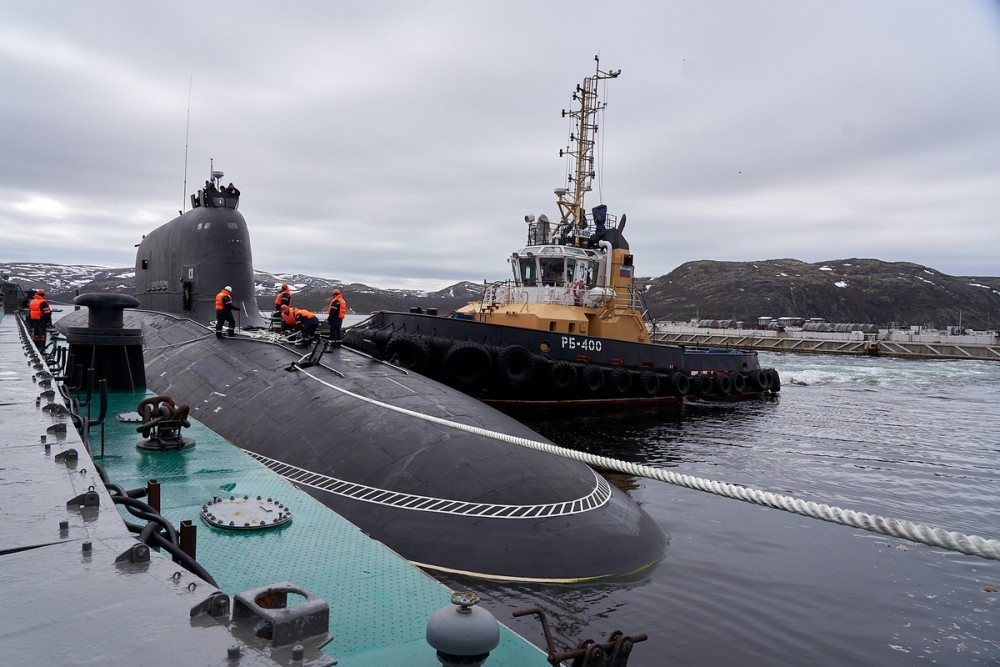 Firt time at port in Zapadnaya Litsa for the Kazan nuclear-powered cruise missile submarine. Click to see all images. Photo: Press service of the Northern Fleet
Firt time at port in Zapadnaya Litsa for the Kazan nuclear-powered cruise missile submarine. Click to see all images. Photo: Press service of the Northern Fleet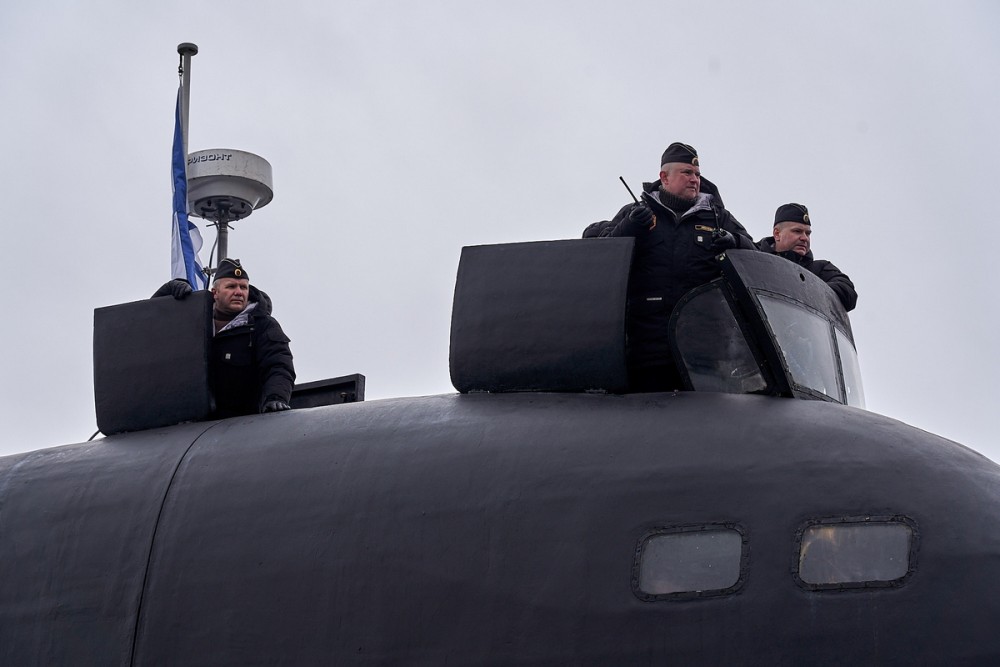 Photo: Press service of the Northern Fleet
Photo: Press service of the Northern Fleet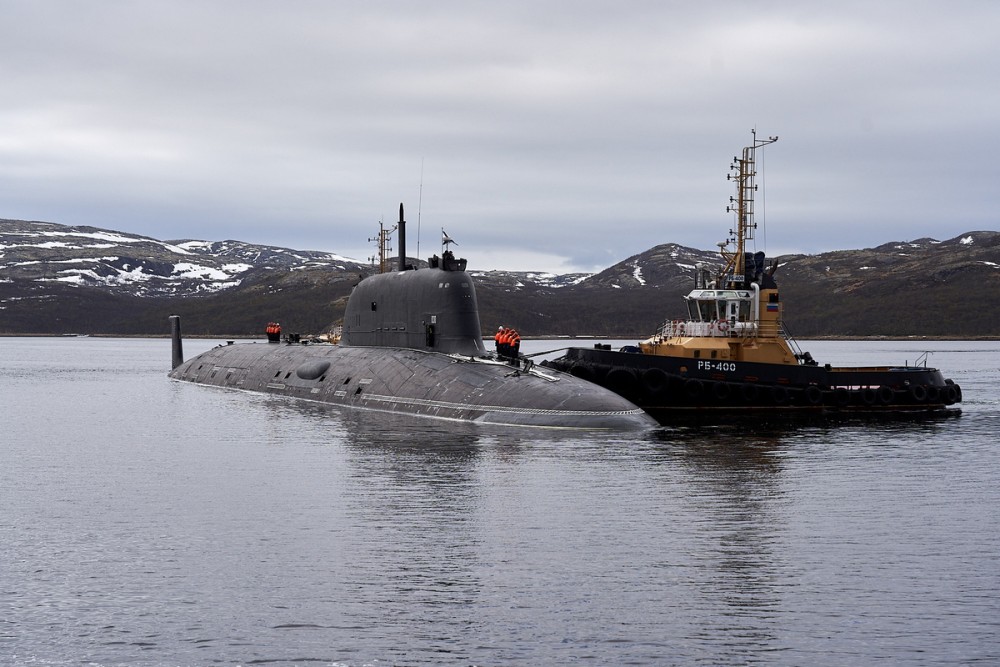 Photo: Press service of the Northern Fleet
Photo: Press service of the Northern Fleet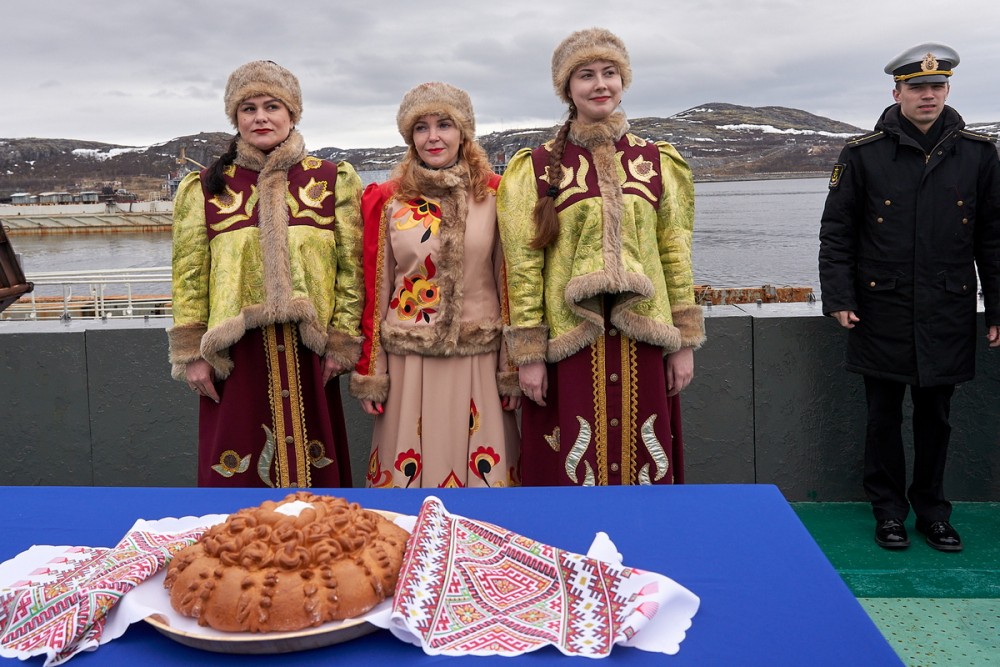 Photo: Press service of the Northern Fleet
Photo: Press service of the Northern Fleet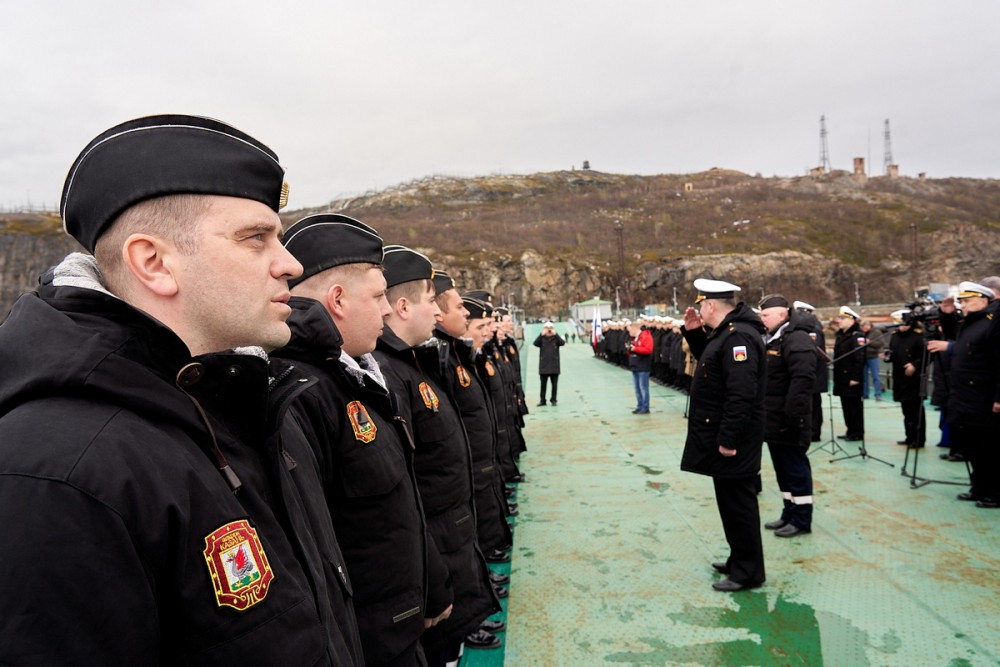 Photo: Press service of the Northern Fleet
Photo: Press service of the Northern Fleet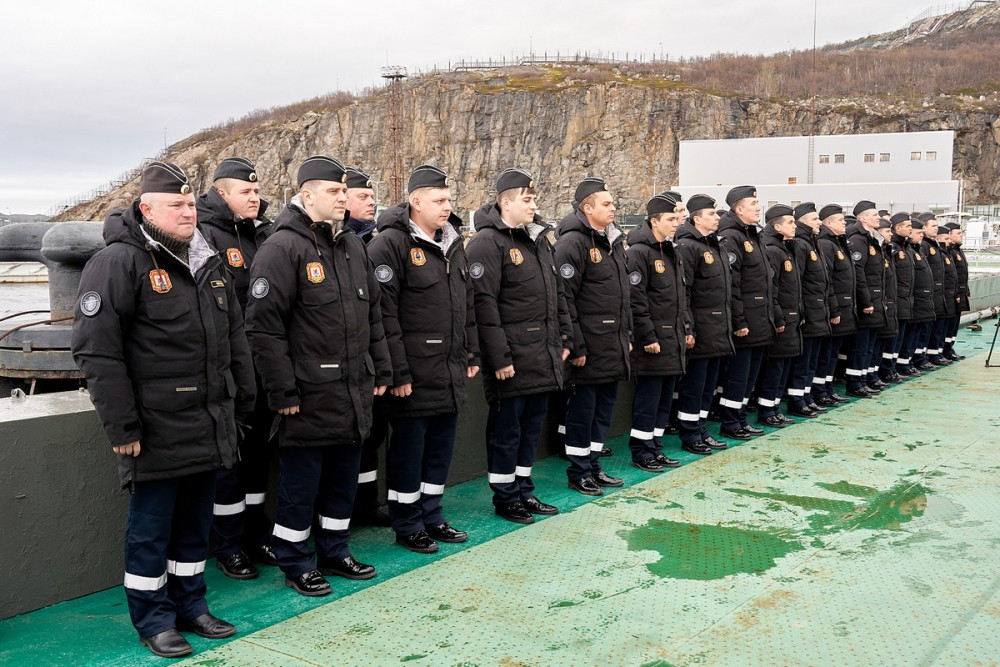 Photo: Press service of the Northern Fleet
Photo: Press service of the Northern Fleet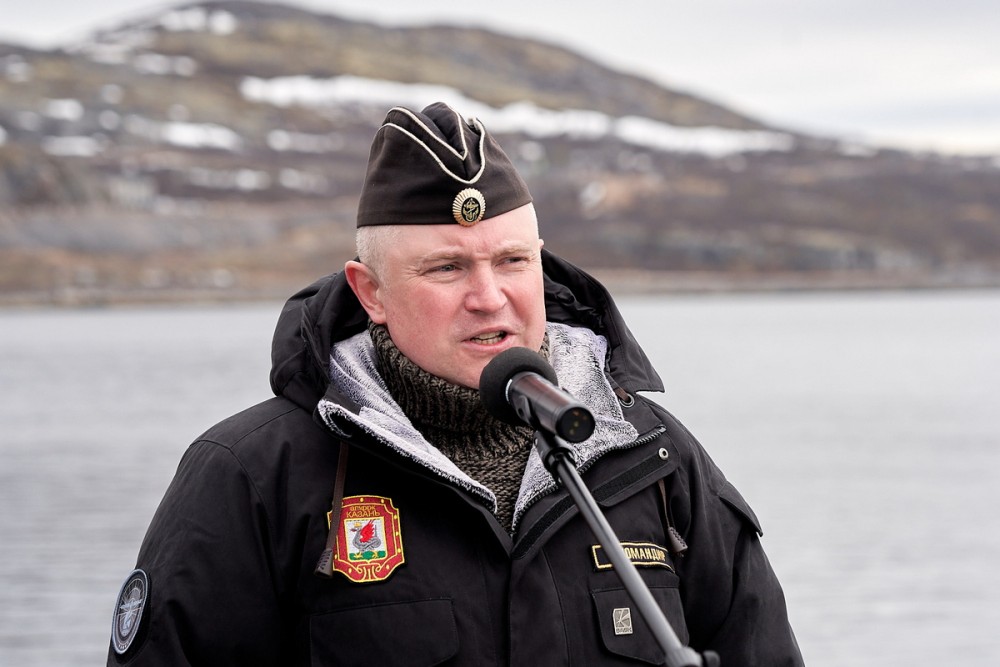 Photo: Press service of the Northern Fleet
Photo: Press service of the Northern Fleet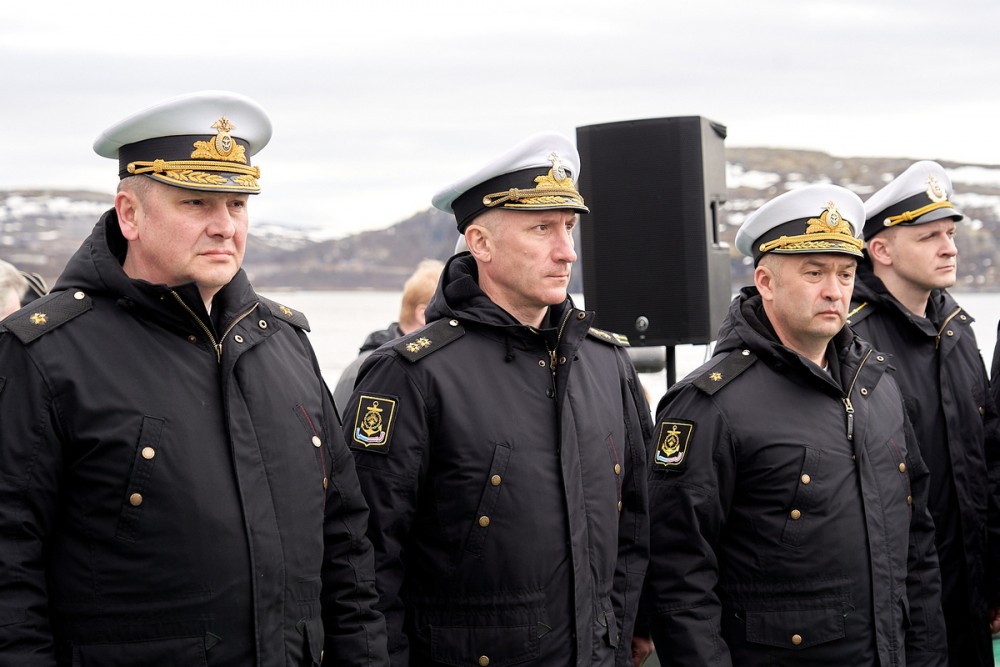 Photo: Press service of the Northern Fleet
Photo: Press service of the Northern Fleet
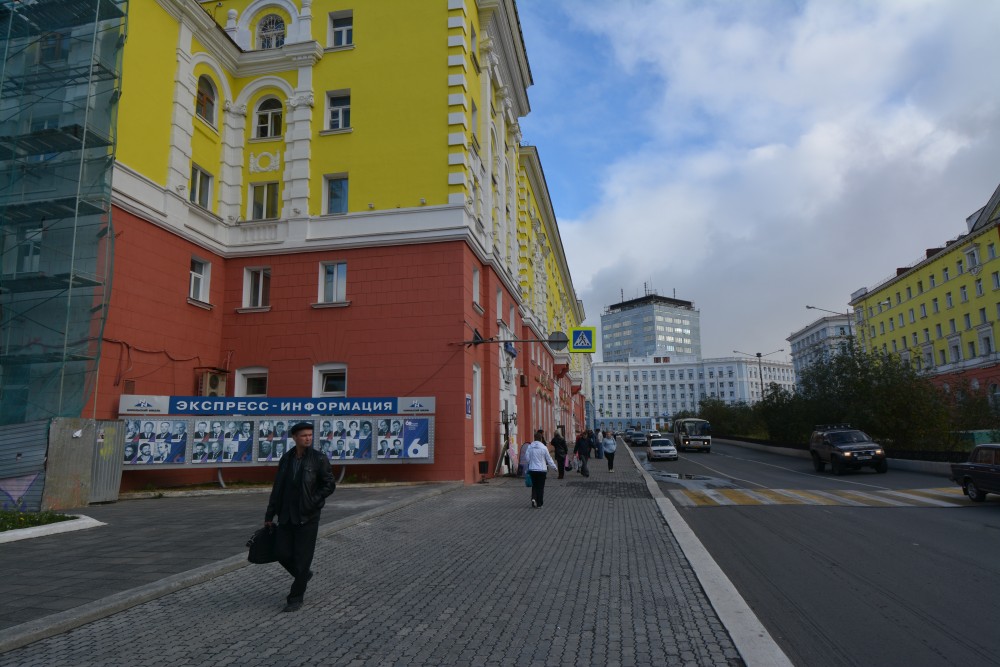 Sharp yellowish coloured architecture along Lenin Prospekt, the main avenue in Norilsk. Portraits of "Workers of the Month" are centrally displayed for everyone to see. Photo: Thomas Nilsen
Sharp yellowish coloured architecture along Lenin Prospekt, the main avenue in Norilsk. Portraits of "Workers of the Month" are centrally displayed for everyone to see. Photo: Thomas Nilsen Devastating industrial pollution from the factories of NorNickel can bee seen all around the city. Photo: Thomas Nilsen
Devastating industrial pollution from the factories of NorNickel can bee seen all around the city. Photo: Thomas Nilsen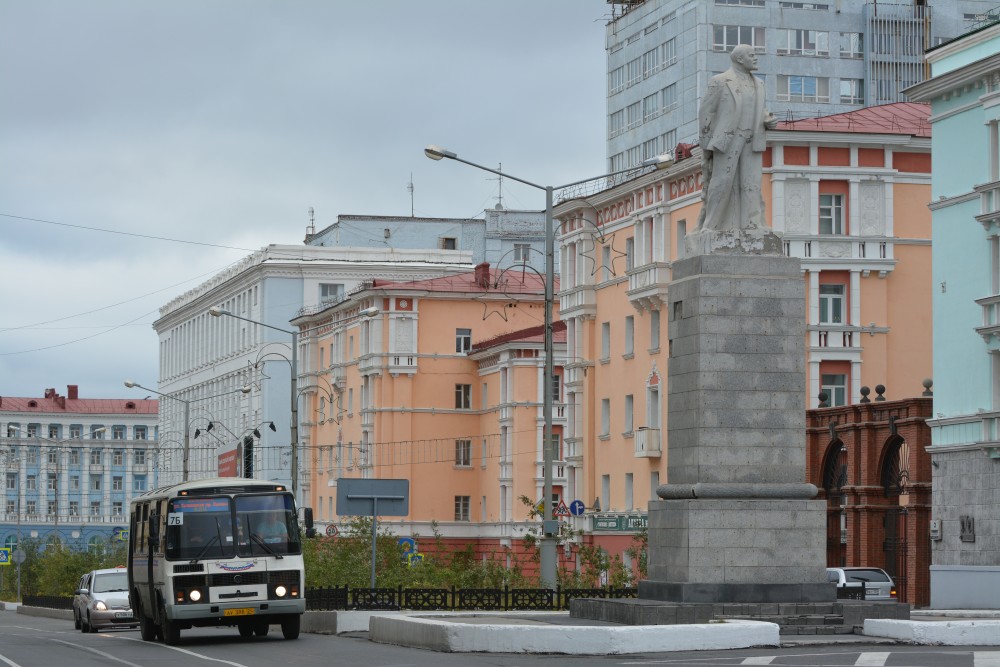 Lenin has a central view of Norilsk. Photo: Thomas Nilsen
Lenin has a central view of Norilsk. Photo: Thomas Nilsen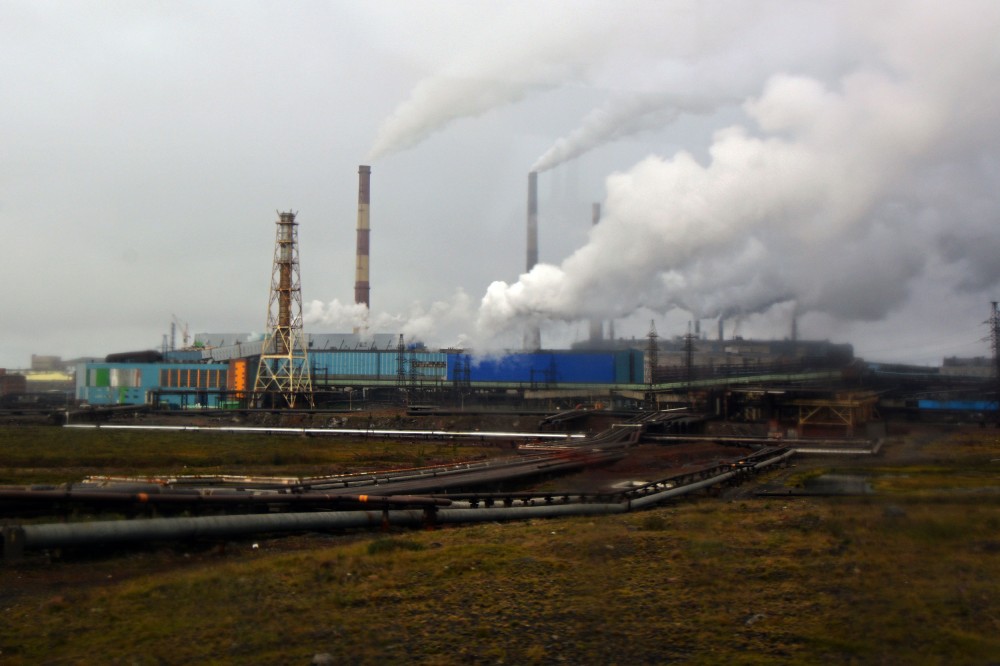 The Nadezhda plant is outside the city, but the air pollution often blows towards where people live in Norilsk. Photo: Thomas Nilsen
The Nadezhda plant is outside the city, but the air pollution often blows towards where people live in Norilsk. Photo: Thomas Nilsen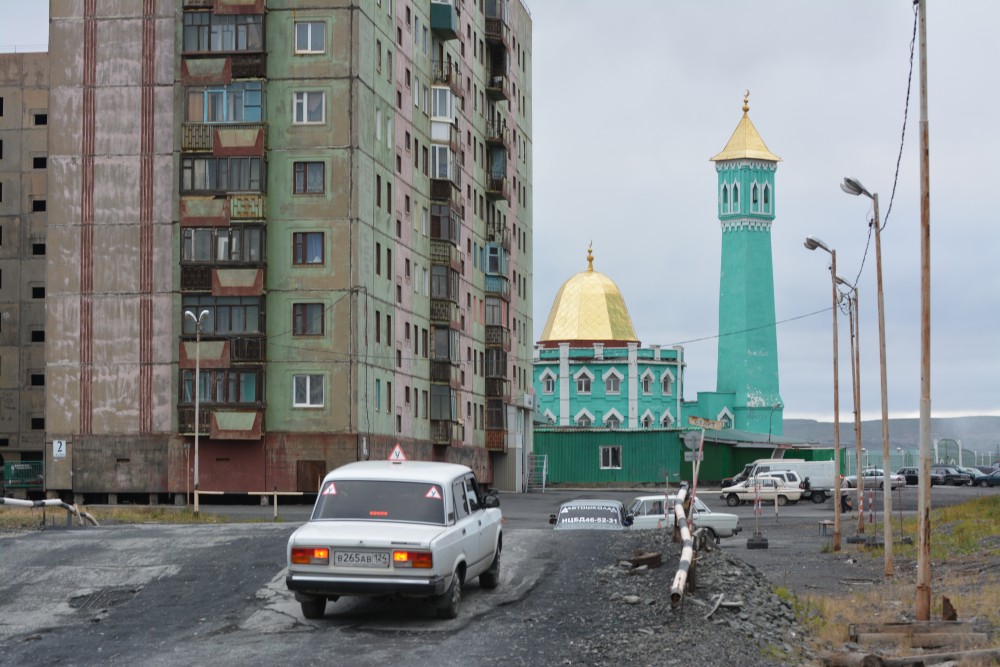 The largest mosque north of the Arctic Circle is found in Norilsk. Photo: Thomas Nilsen
The largest mosque north of the Arctic Circle is found in Norilsk. Photo: Thomas Nilsen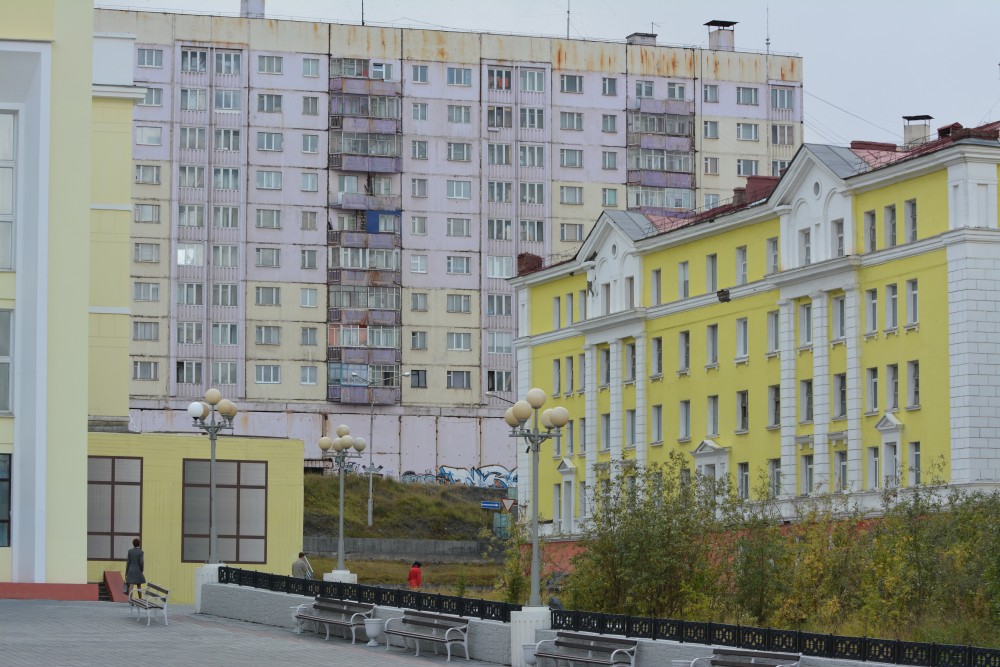 Norilsk has about 270,000 inhabitants and is Russia's second largest city inside the Arctic Circle after Murmansk which has some 295,000 people. Photo: Thomas Nilsen
Norilsk has about 270,000 inhabitants and is Russia's second largest city inside the Arctic Circle after Murmansk which has some 295,000 people. Photo: Thomas Nilsen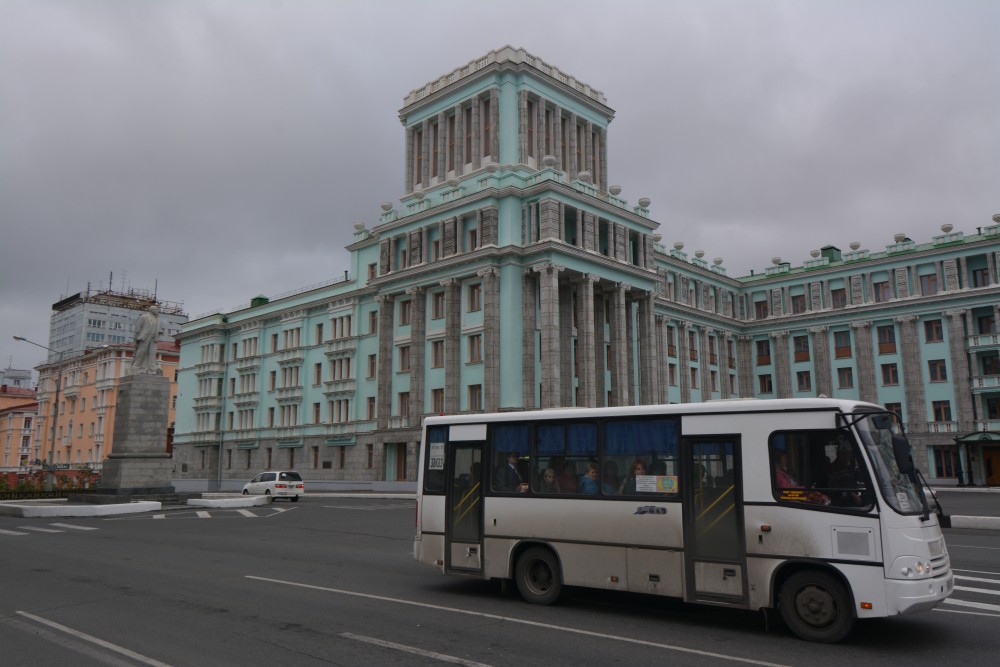 Stalinist architecture on most official buildings along the central streets of Norilsk. Photo: Thomas Nilsen
Stalinist architecture on most official buildings along the central streets of Norilsk. Photo: Thomas Nilsen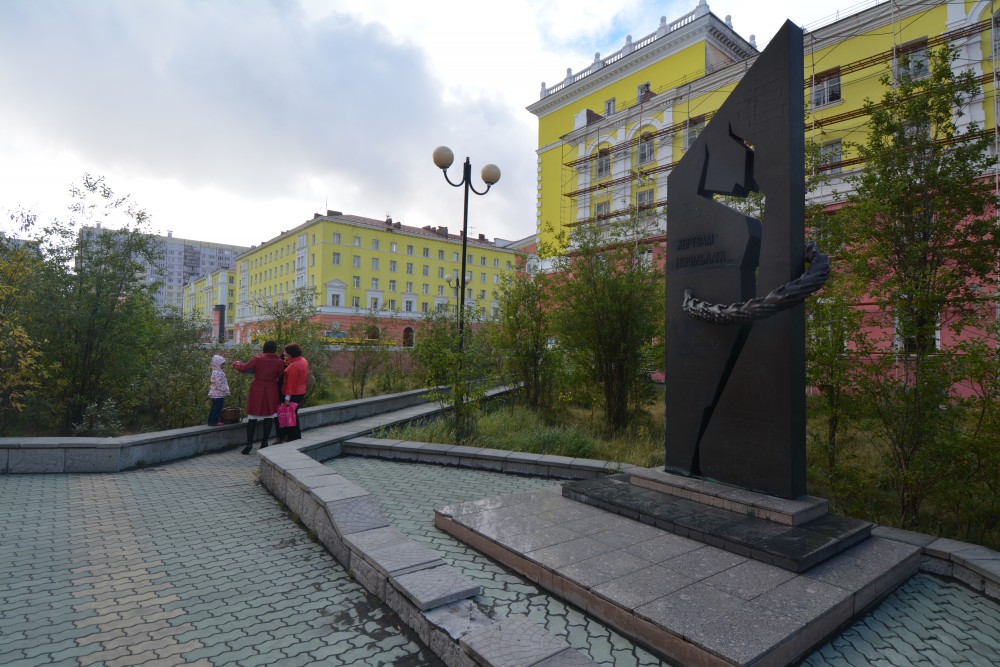 Norilsk was built by Gulag prisoners sent north by Stalin to work in the mines and factories of NorNickel. This memorial is raised near the city museum. Photo: Thomas Nilsen
Norilsk was built by Gulag prisoners sent north by Stalin to work in the mines and factories of NorNickel. This memorial is raised near the city museum. Photo: Thomas Nilsen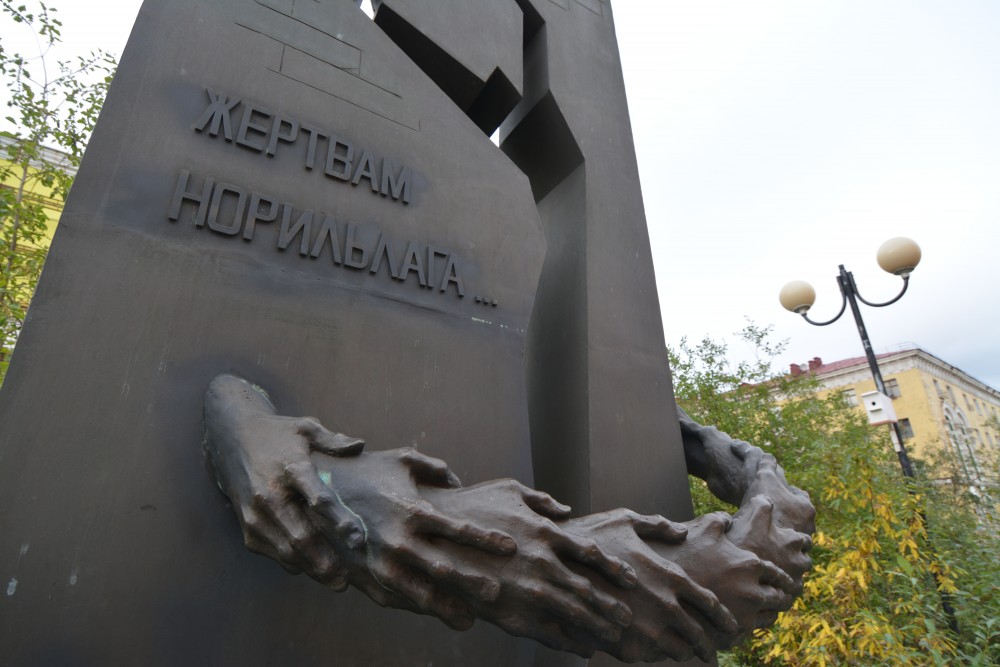 Norillag, Norilsk Corrective Labor Camp, which existed from 1935 to 1956, was responsible for the construction of the Norilsk mining-metallurgic complex and for mining copper and nickel. Photo: Thomas Nilsen
Norillag, Norilsk Corrective Labor Camp, which existed from 1935 to 1956, was responsible for the construction of the Norilsk mining-metallurgic complex and for mining copper and nickel. Photo: Thomas Nilsen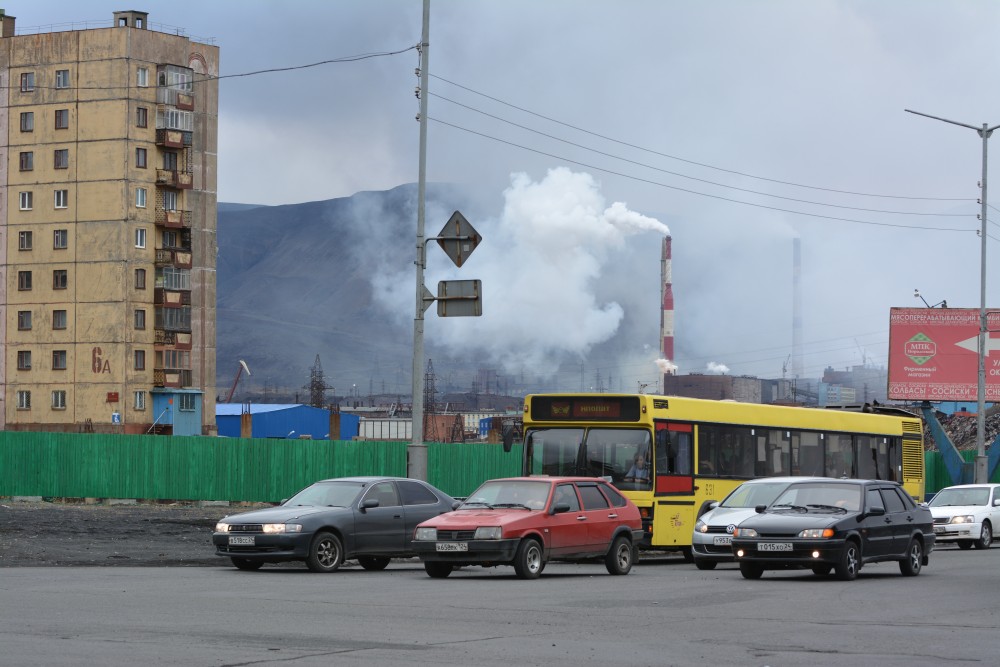 The old nickel plant in the outer edge of Norilsk was shut-down a few years ago. Photo: Thomas Nilsen
The old nickel plant in the outer edge of Norilsk was shut-down a few years ago. Photo: Thomas Nilsen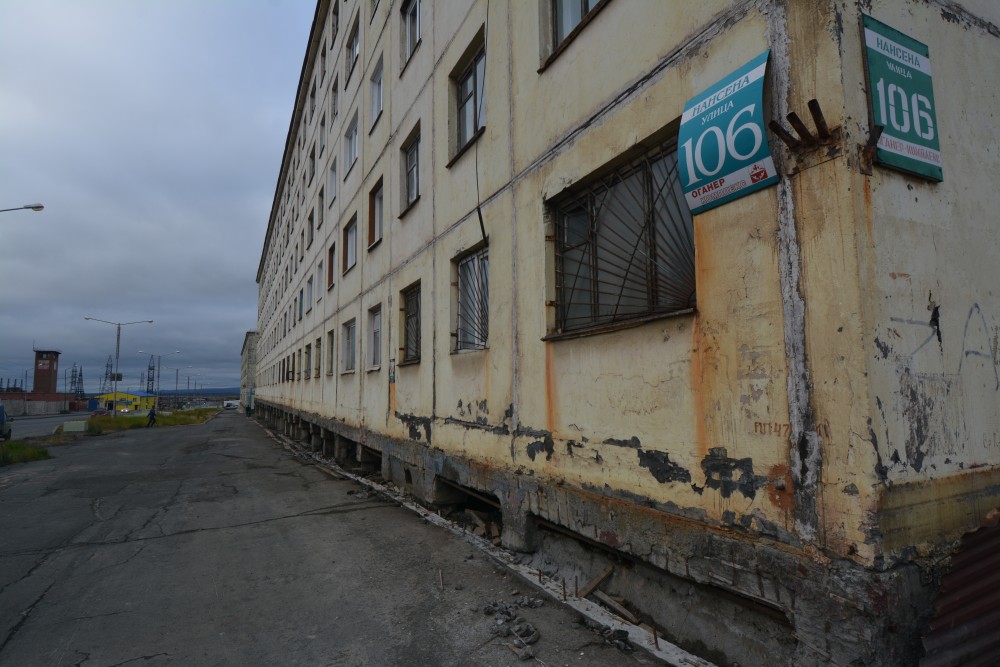 The Nansen Street in Norilsk, named after the famous Norwegian polar explorer. Photo: Thomas Nilsen
The Nansen Street in Norilsk, named after the famous Norwegian polar explorer. Photo: Thomas Nilsen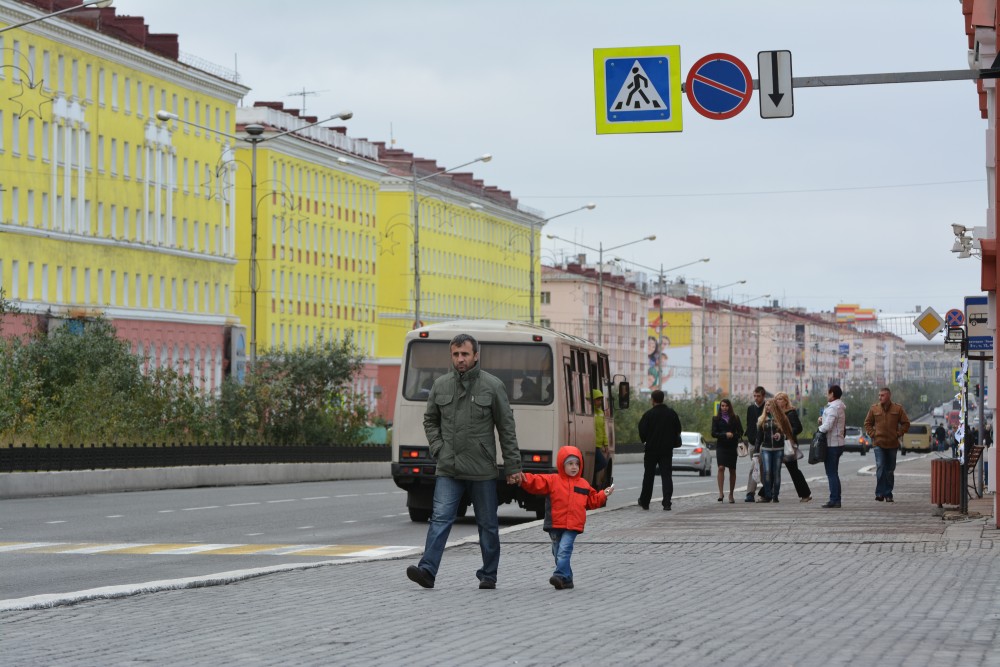 Lenin Prospekt, Norilsk. Photo: Thomas Nilsen
Lenin Prospekt, Norilsk. Photo: Thomas Nilsen
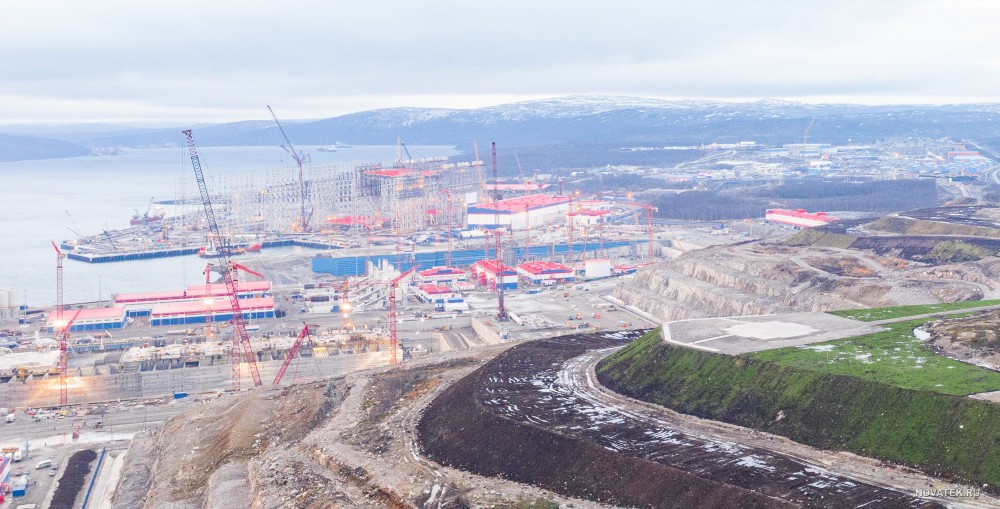 Click to see all images. Photo: Novatek
Click to see all images. Photo: Novatek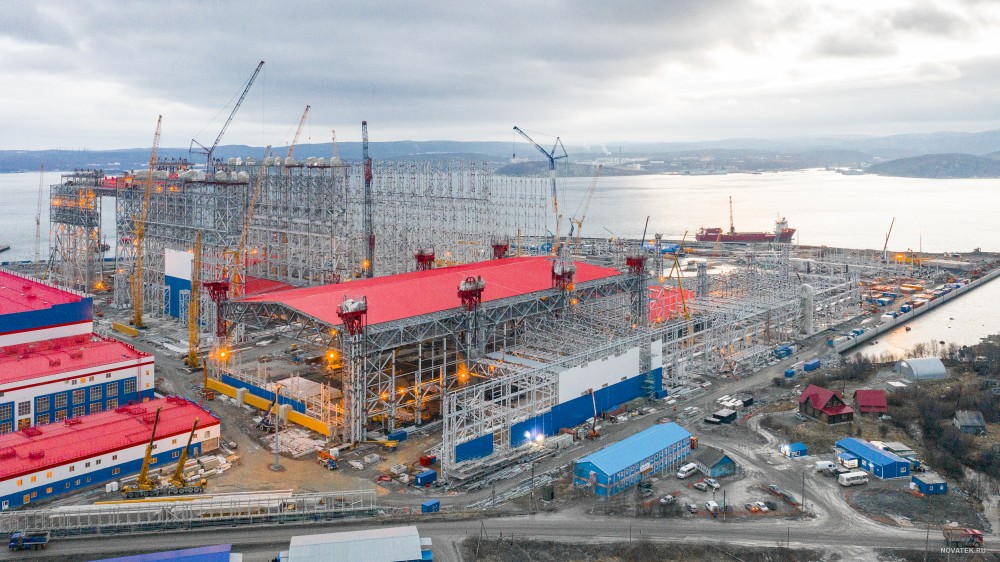 Belokamenka is currently the largest construction site in the circumpolar north. Photo: Novatek
Belokamenka is currently the largest construction site in the circumpolar north. Photo: Novatek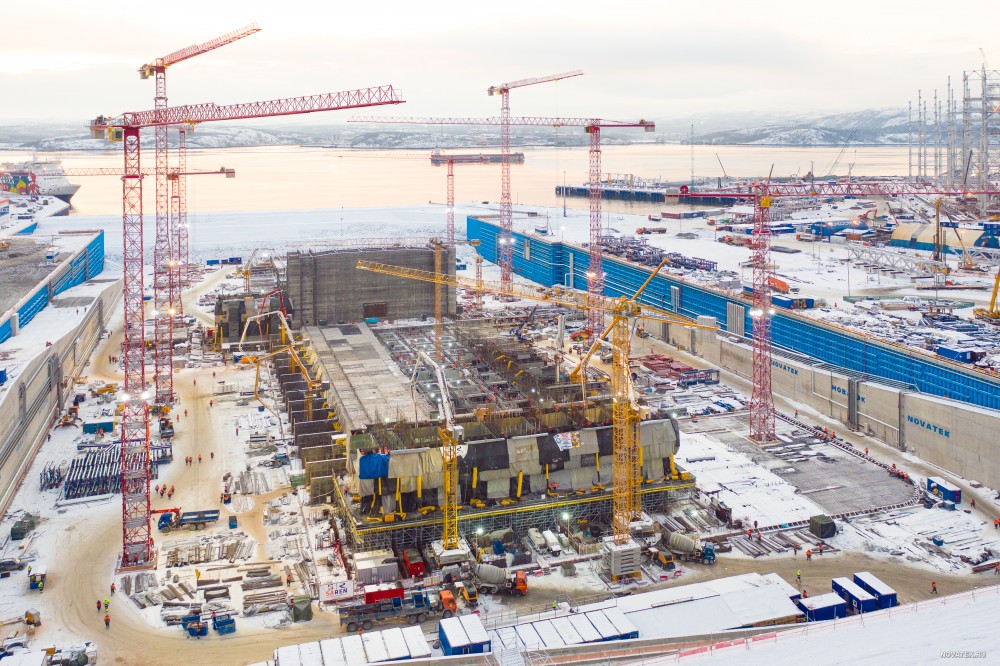 Construction of the first gravity-based structure for the liquefaction facility for Train 1 at Arctic LNG 2 has already started. Photo: Novatek
Construction of the first gravity-based structure for the liquefaction facility for Train 1 at Arctic LNG 2 has already started. Photo: Novatek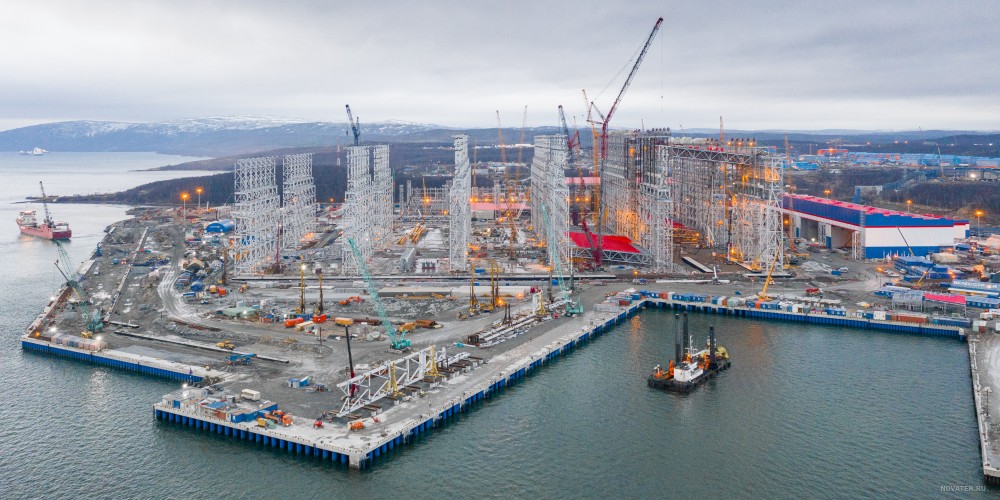 The total length of the waterfront in Belokamenka is 2,7 kilometers. Photo: Novatek
The total length of the waterfront in Belokamenka is 2,7 kilometers. Photo: Novatek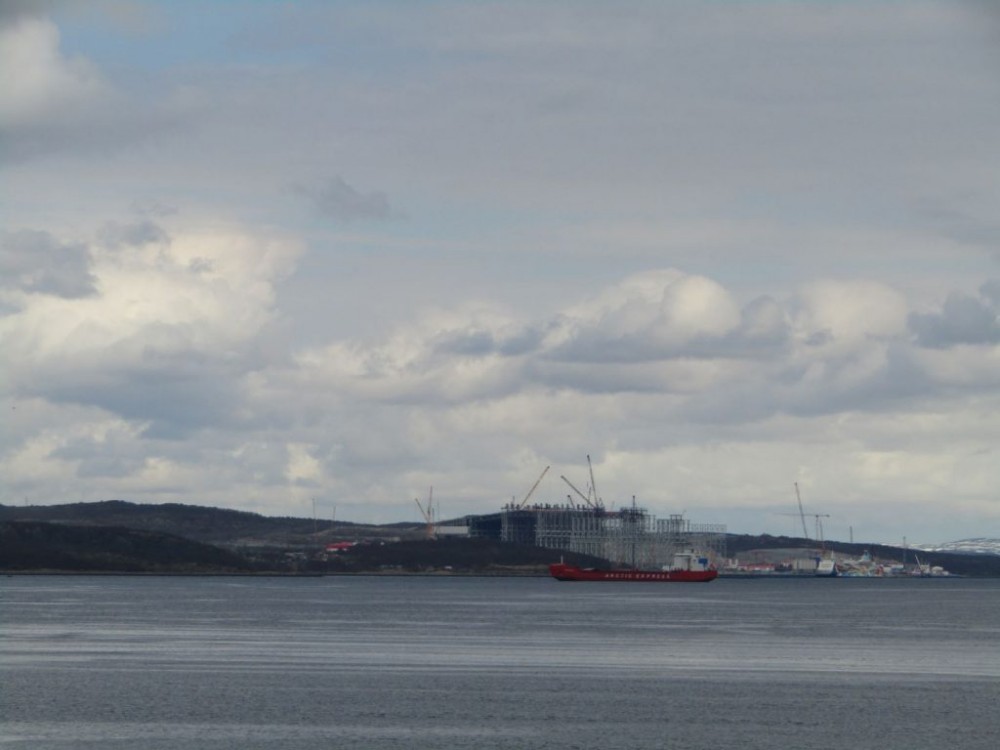 Belokamenka seen from the east side of the Kola Bay. Photo: mmk.news
Belokamenka seen from the east side of the Kola Bay. Photo: mmk.news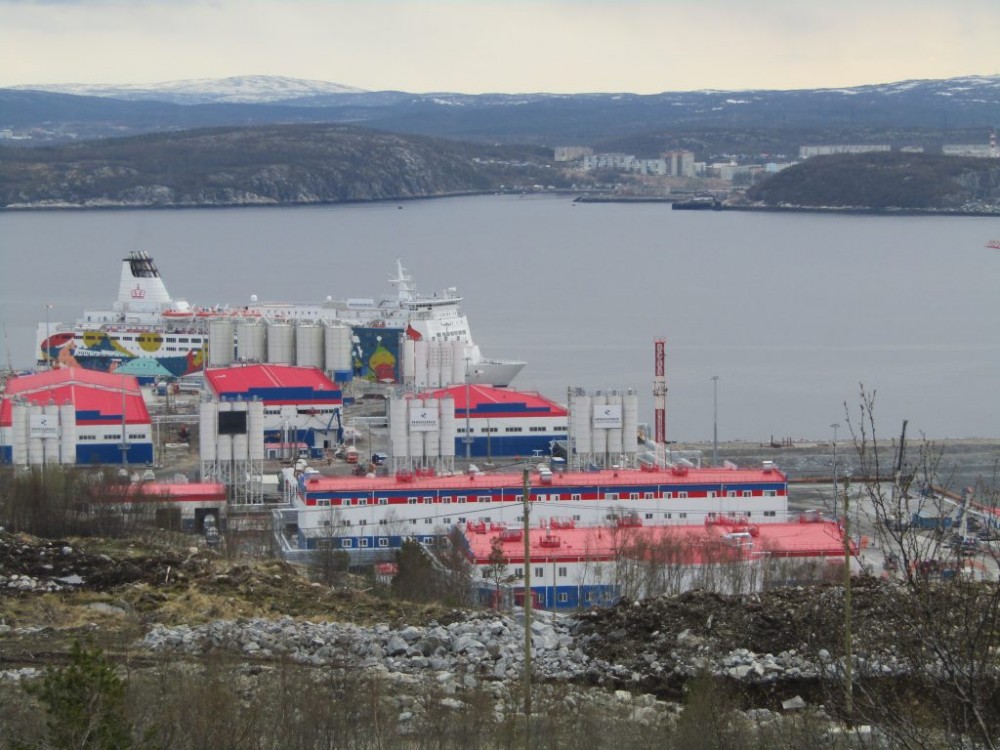 A cruise vessel serves as accommodation for staff working at Belokamenka. Photo: mmk.news
A cruise vessel serves as accommodation for staff working at Belokamenka. Photo: mmk.news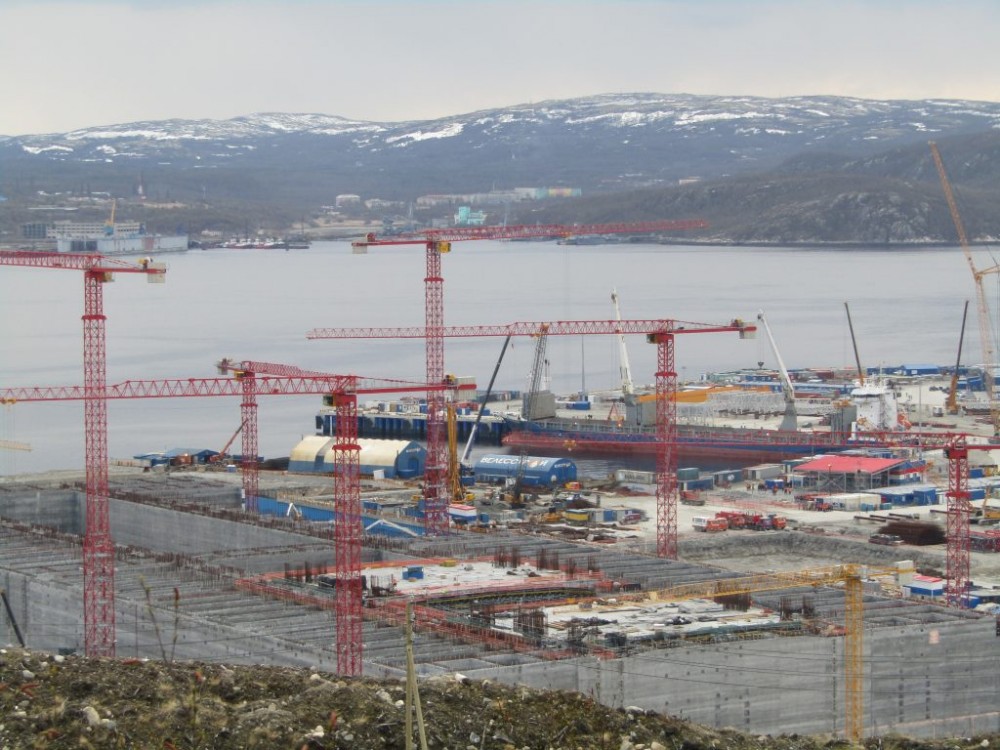 The town of Roslyakovo, serving the navy ships of the Northern Fleet, can be seen across the Kola Bay from Belokamenka. Photo: mmk.news
The town of Roslyakovo, serving the navy ships of the Northern Fleet, can be seen across the Kola Bay from Belokamenka. Photo: mmk.news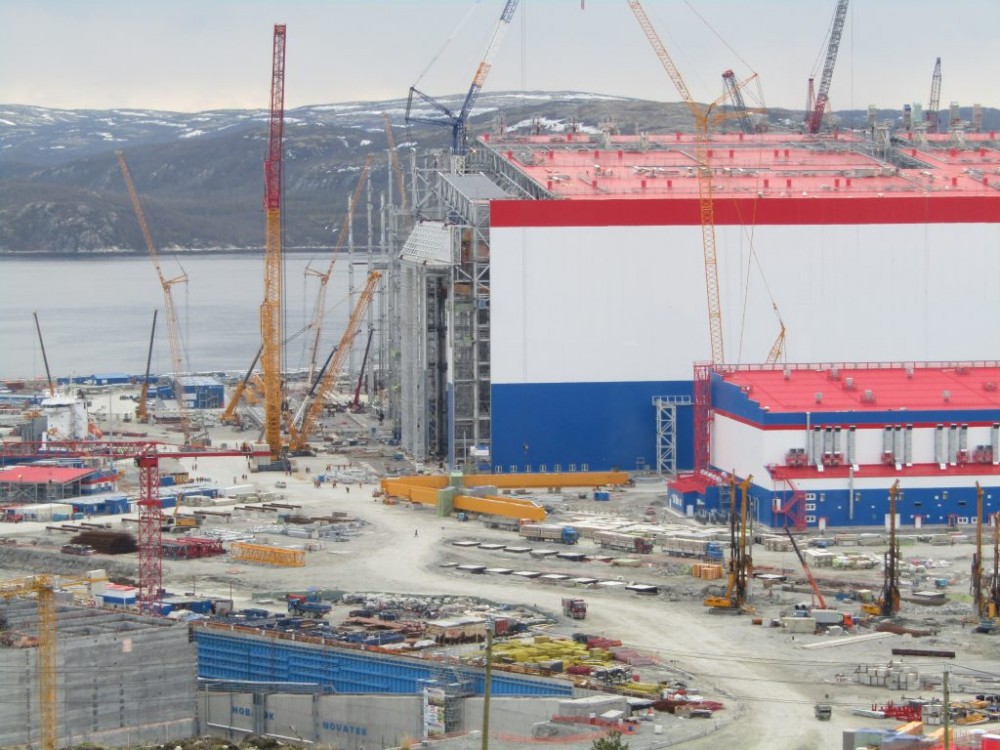 This ship hall is the tallest building in the Murmansk region, 88 meters high. That is 16 meters taller than the 19-floors Hotel Arktika in Murmansk. Photo: mmk.news
This ship hall is the tallest building in the Murmansk region, 88 meters high. That is 16 meters taller than the 19-floors Hotel Arktika in Murmansk. Photo: mmk.news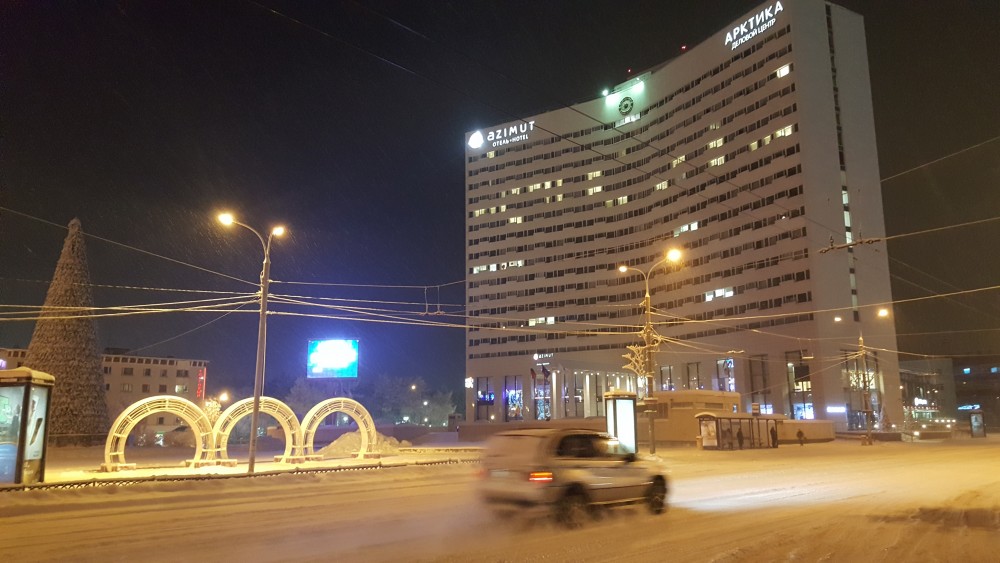 the 19-floors, 72 meters tall, Hotel Arktika in Murmansk. Photo: Thomas Nilsen
the 19-floors, 72 meters tall, Hotel Arktika in Murmansk. Photo: Thomas Nilsen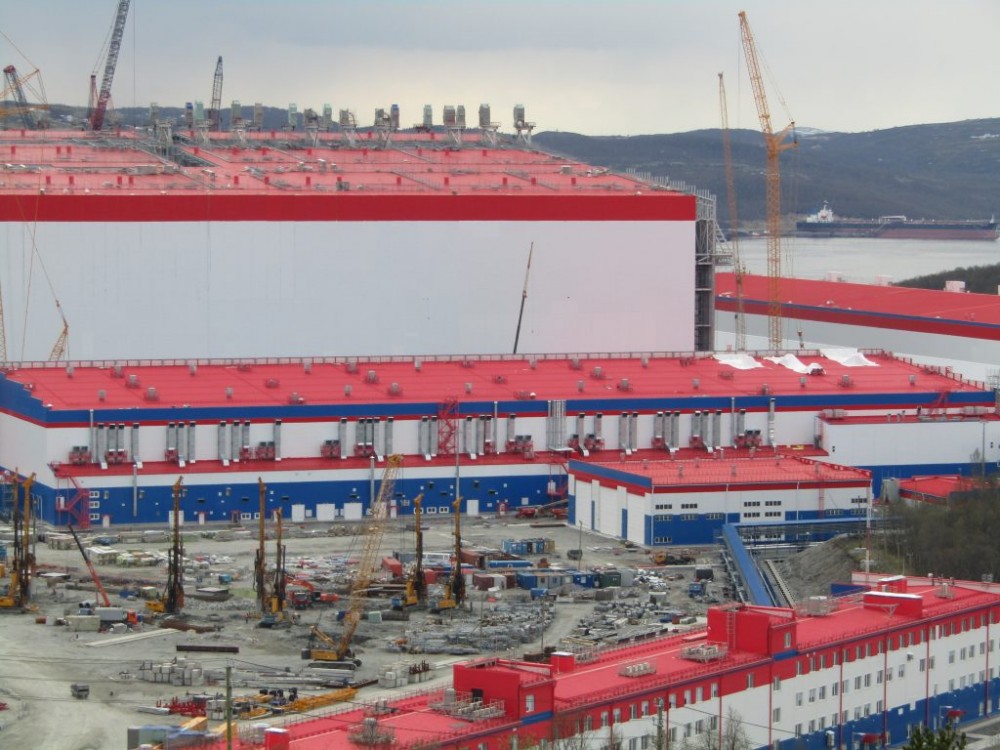 Buildings in Belokamenka is painted like the Russian tricolour flag. Photo: mmk.news
Buildings in Belokamenka is painted like the Russian tricolour flag. Photo: mmk.news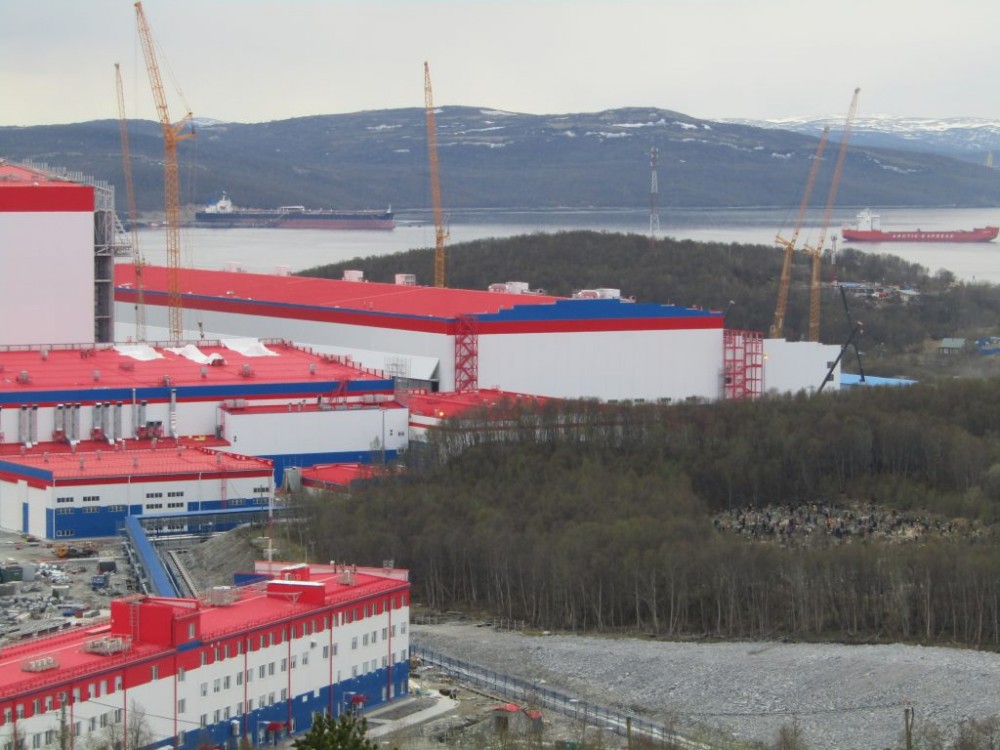 Giant halls for construction of the high-tech fabrication facilities for Arctic LNG 2. Photo: mmk.news
Giant halls for construction of the high-tech fabrication facilities for Arctic LNG 2. Photo: mmk.news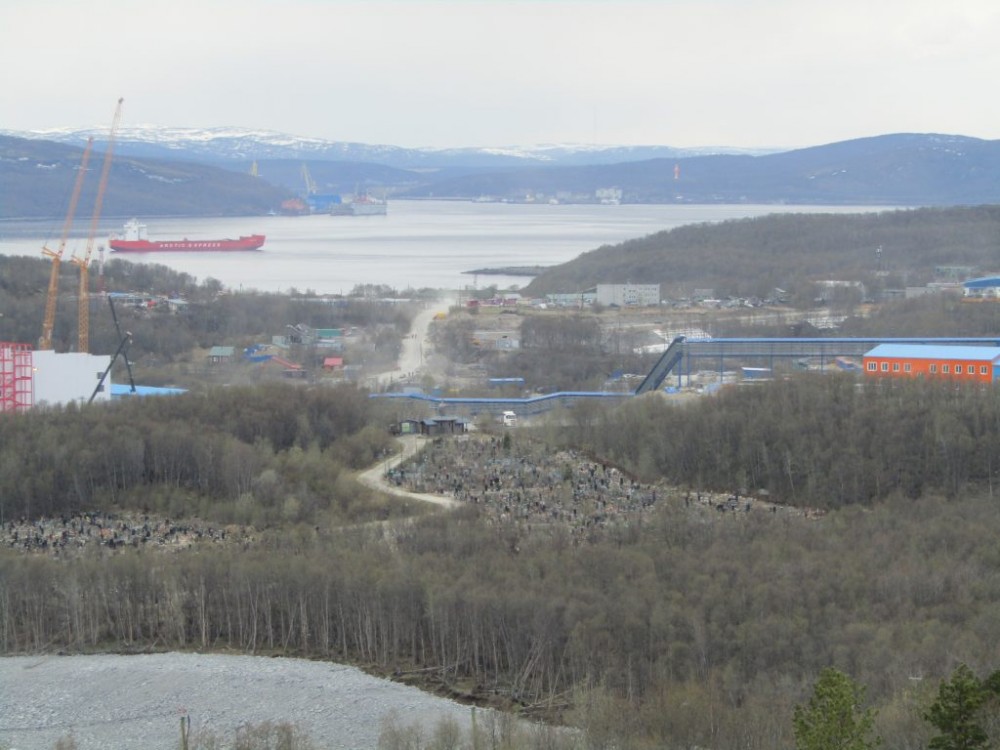 Rosatomflot's base for the fleet of civilian nuclear-powered icebreakers can be seen on the horizon to the left. Belokamenka is 7 km north of Murmansk. Photo: mmk.news
Rosatomflot's base for the fleet of civilian nuclear-powered icebreakers can be seen on the horizon to the left. Belokamenka is 7 km north of Murmansk. Photo: mmk.news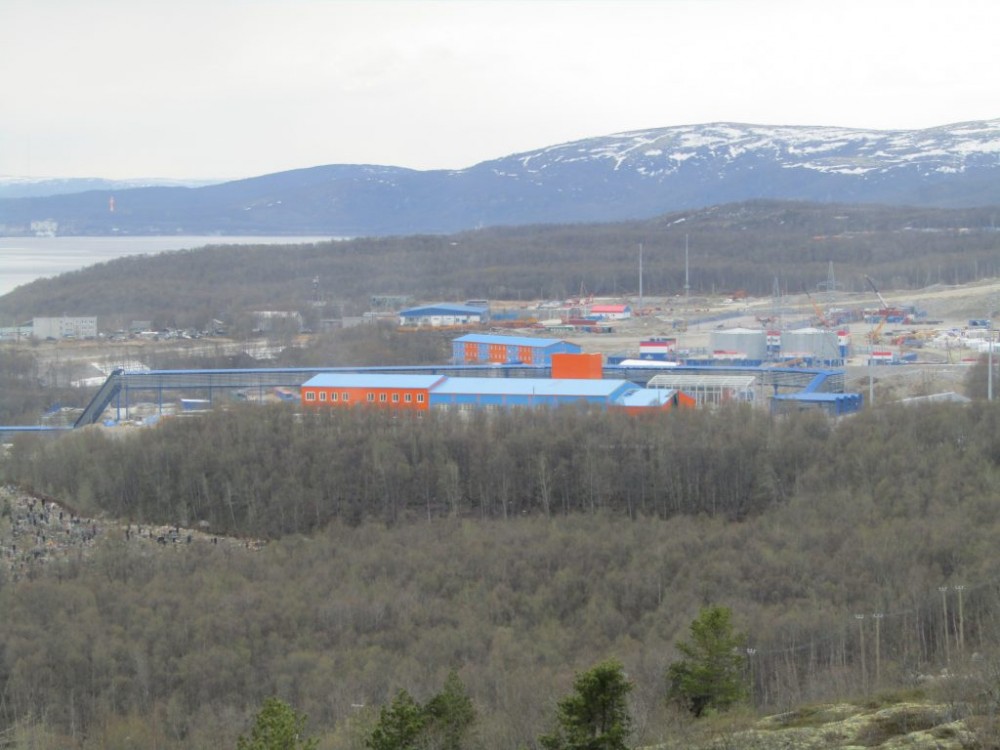 Photo: mmk.news
Photo: mmk.news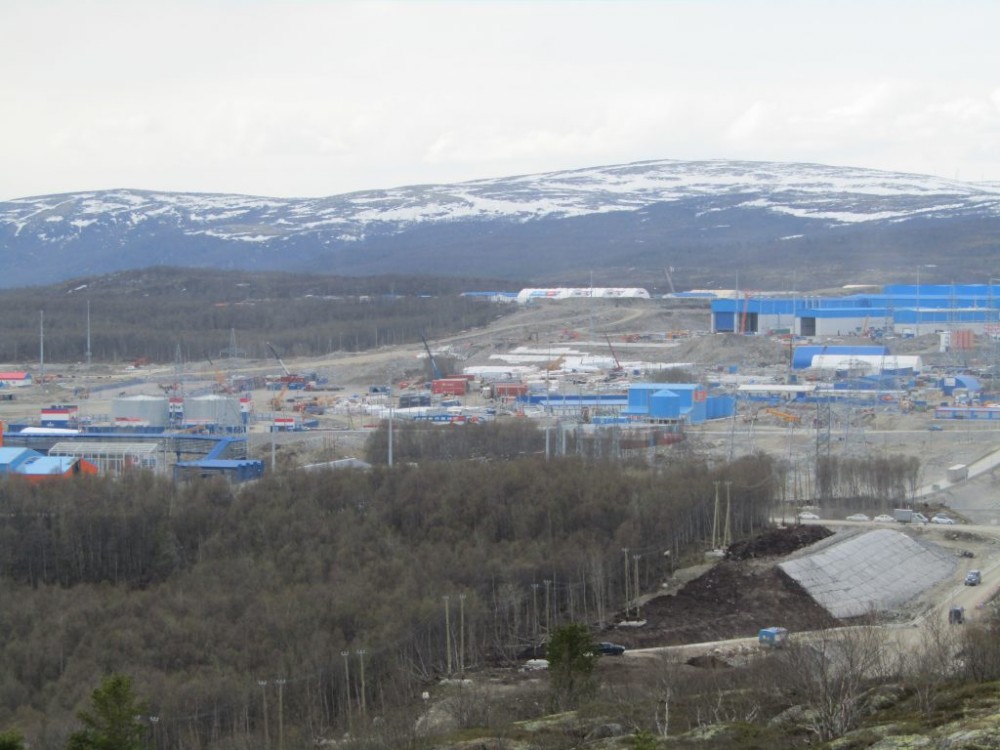 Photo: mmk.news
Photo: mmk.news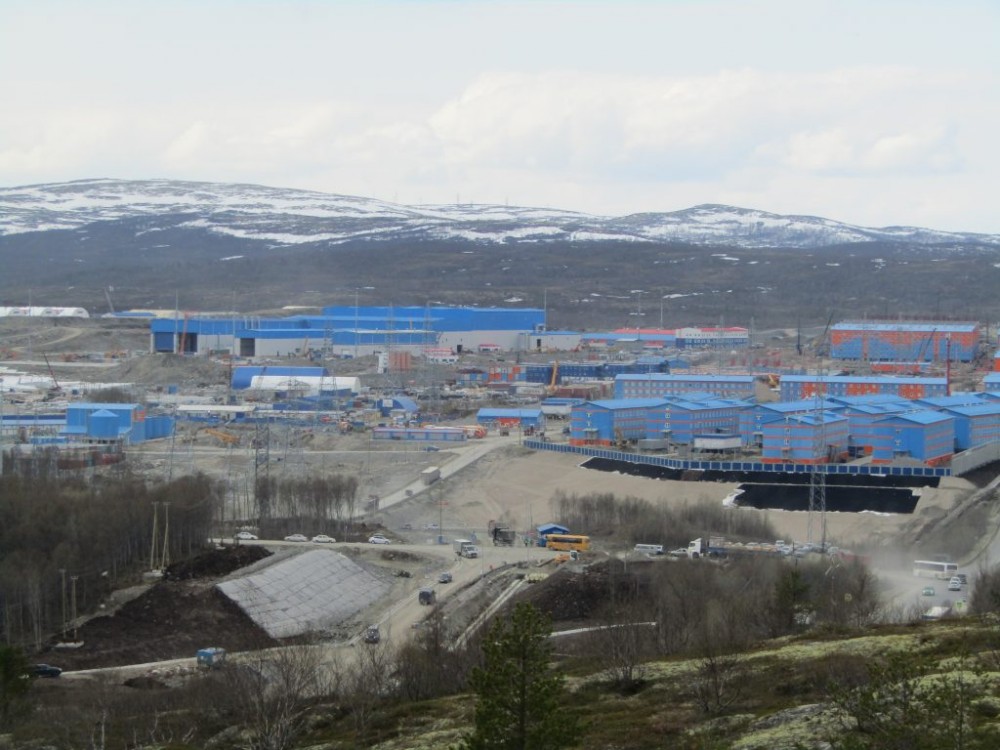 Photo: mmk.news
Photo: mmk.news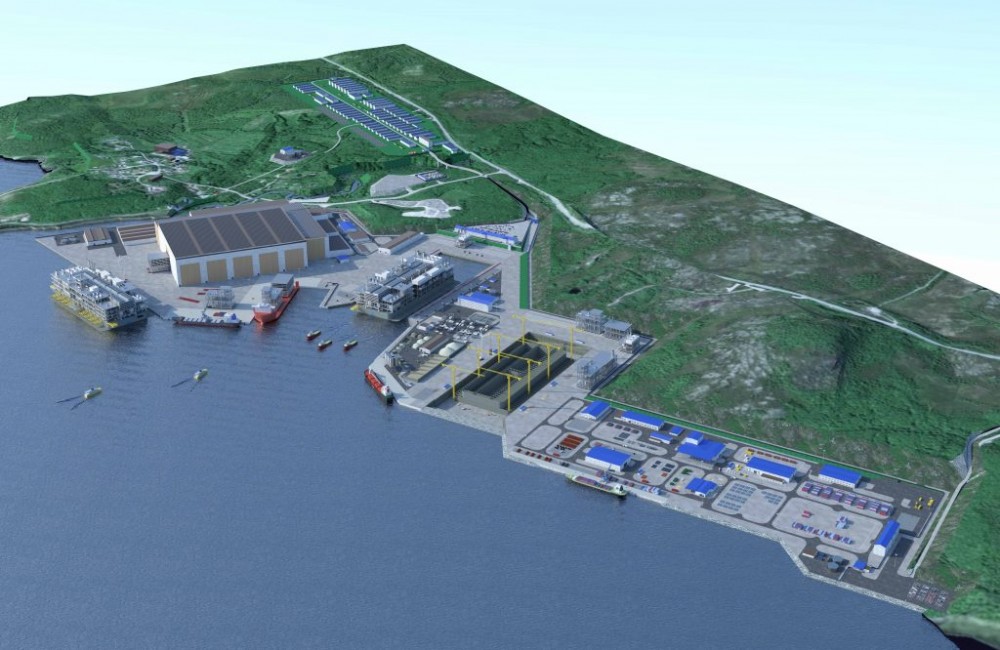 Illustration: Novatek
Illustration: Novatek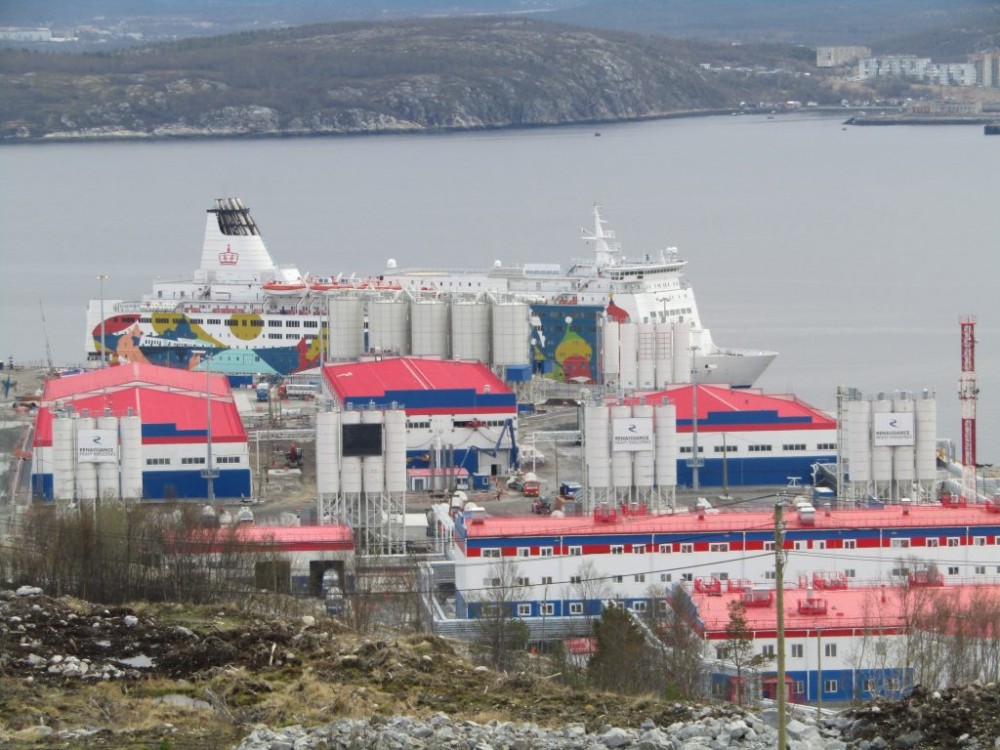 Photo: mmk.news
Photo: mmk.news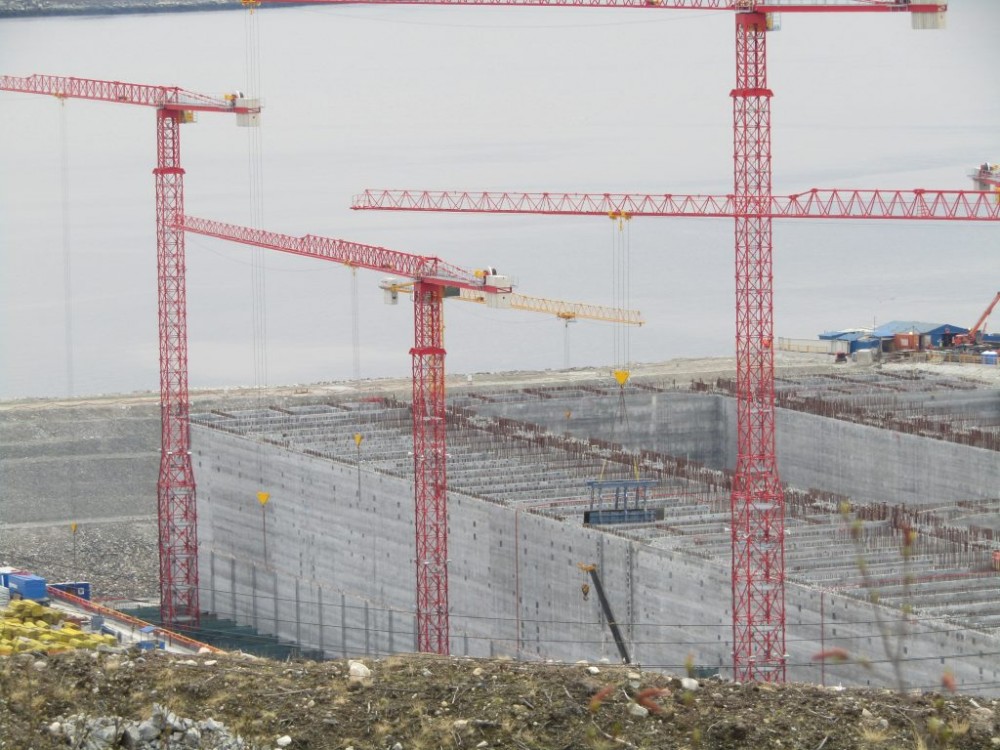 Photo: mmk.news
Photo: mmk.news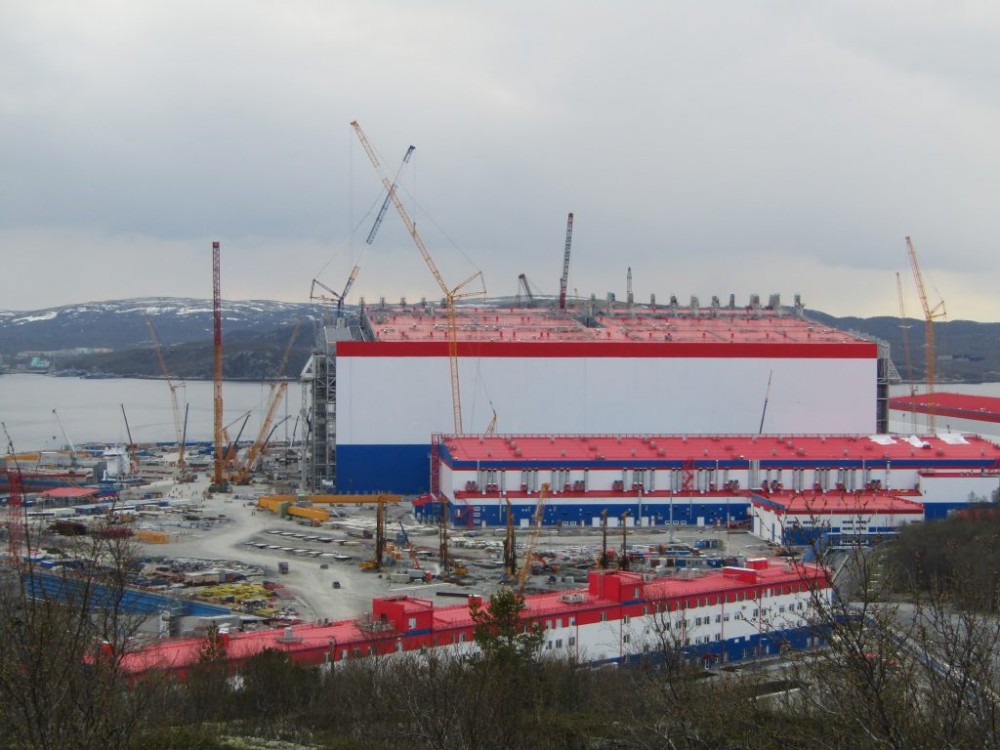 Photo: mmk.news
Photo: mmk.news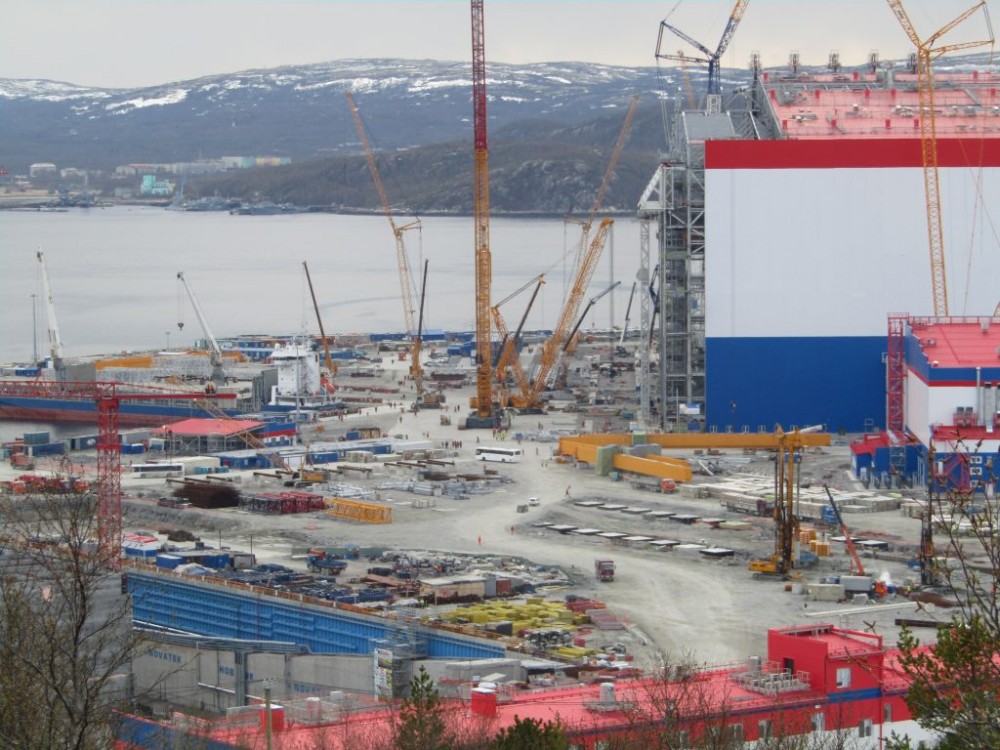 Photo: mmk.news
Photo: mmk.news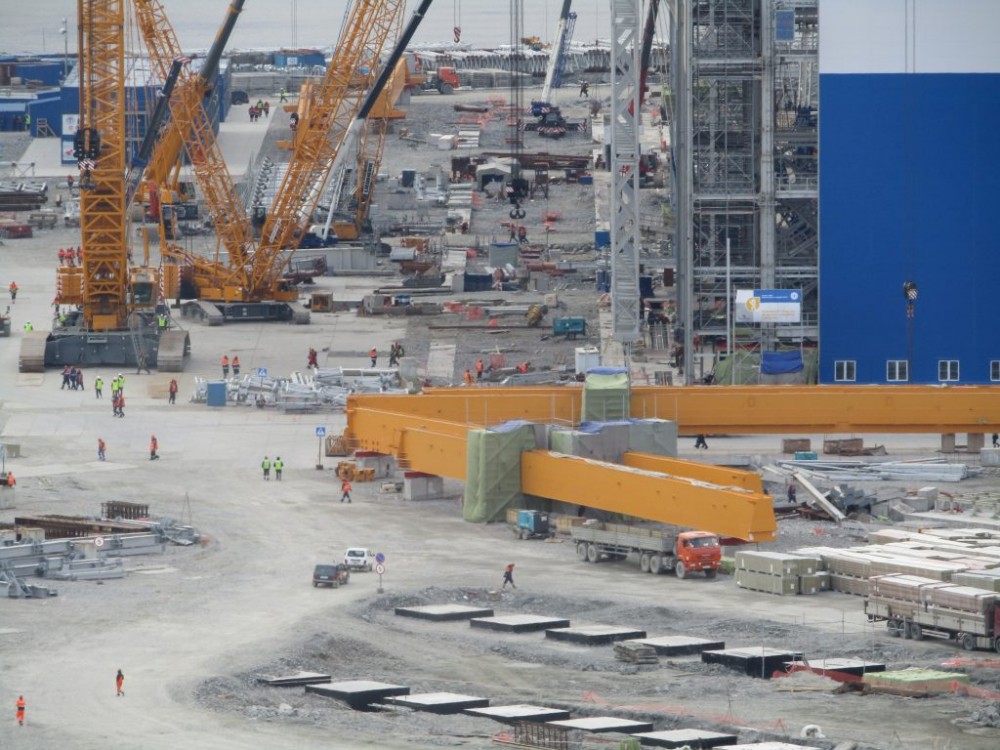 Photo: mmk.news
Photo: mmk.news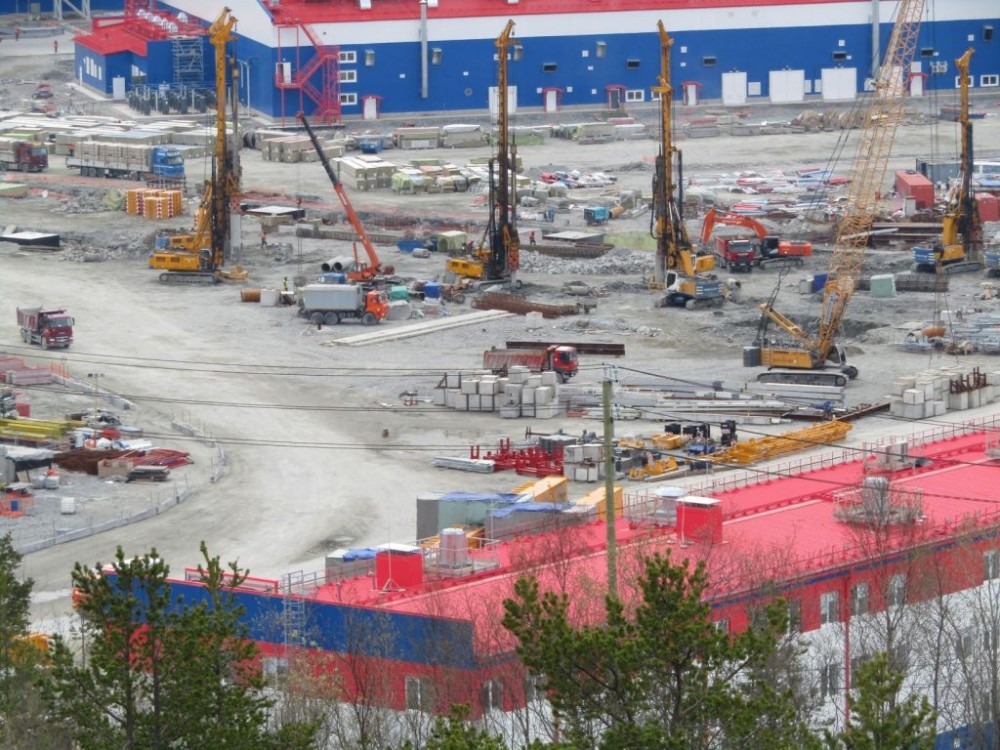 Photo: mmk.news
Photo: mmk.news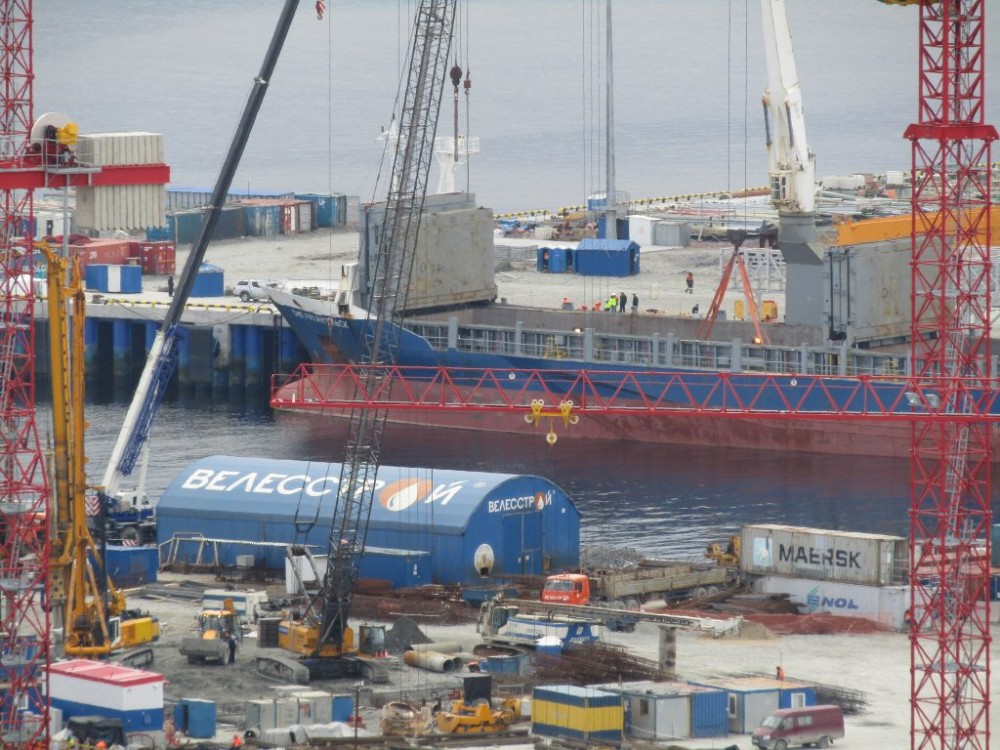 Photo: mmk.news
Photo: mmk.news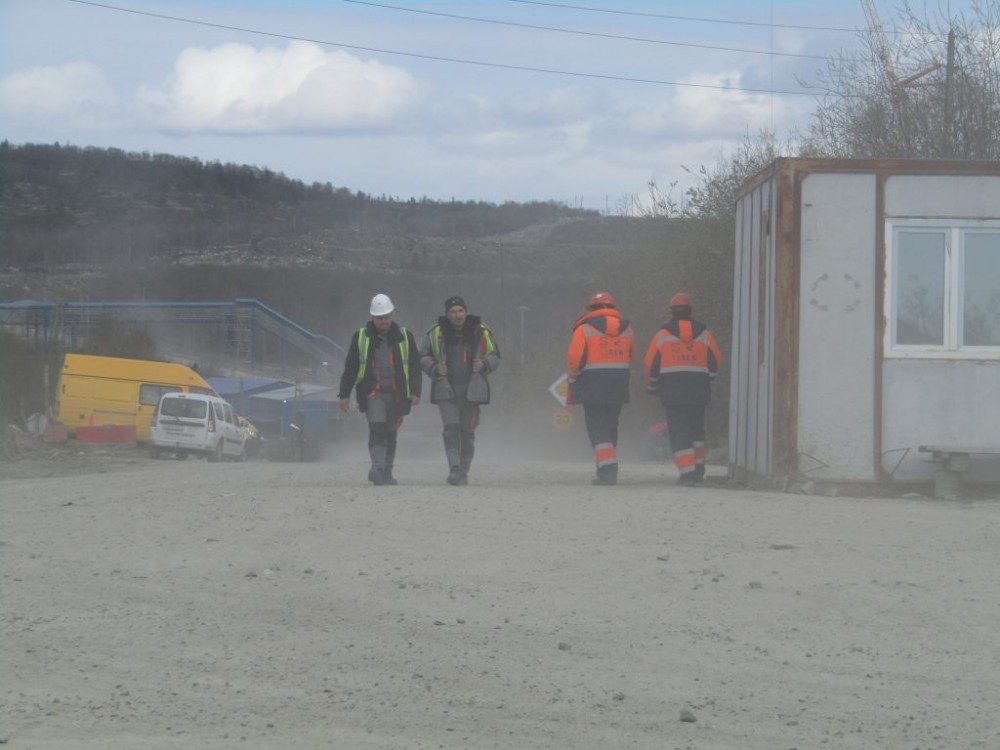 Photo: mmk.news
Photo: mmk.news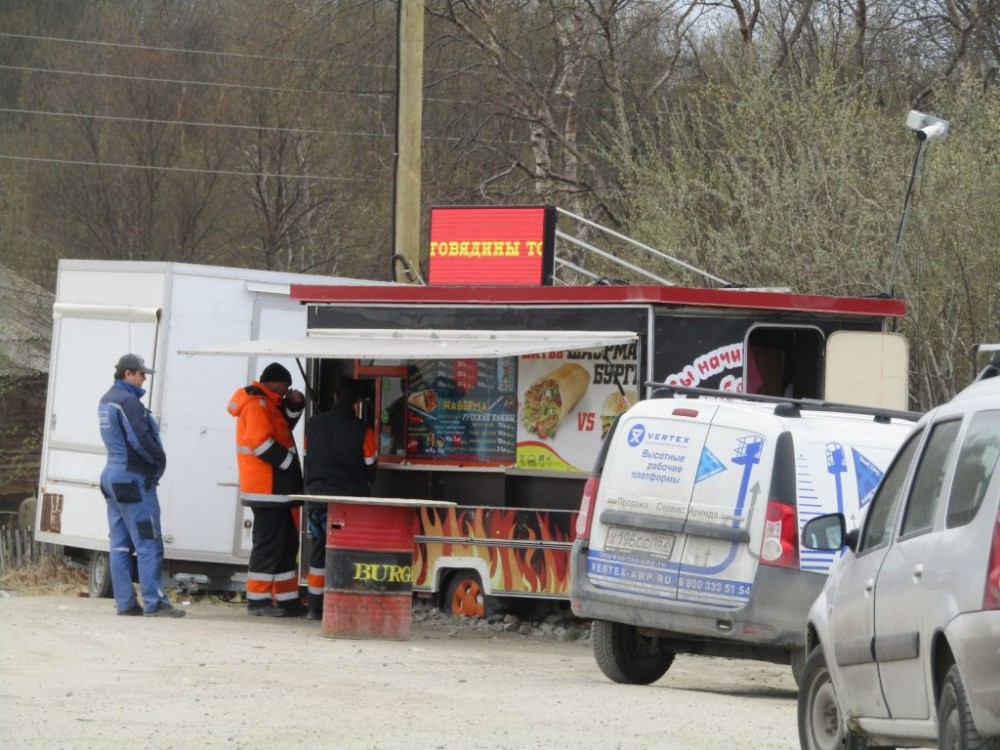 Photo: mmk.news
Photo: mmk.news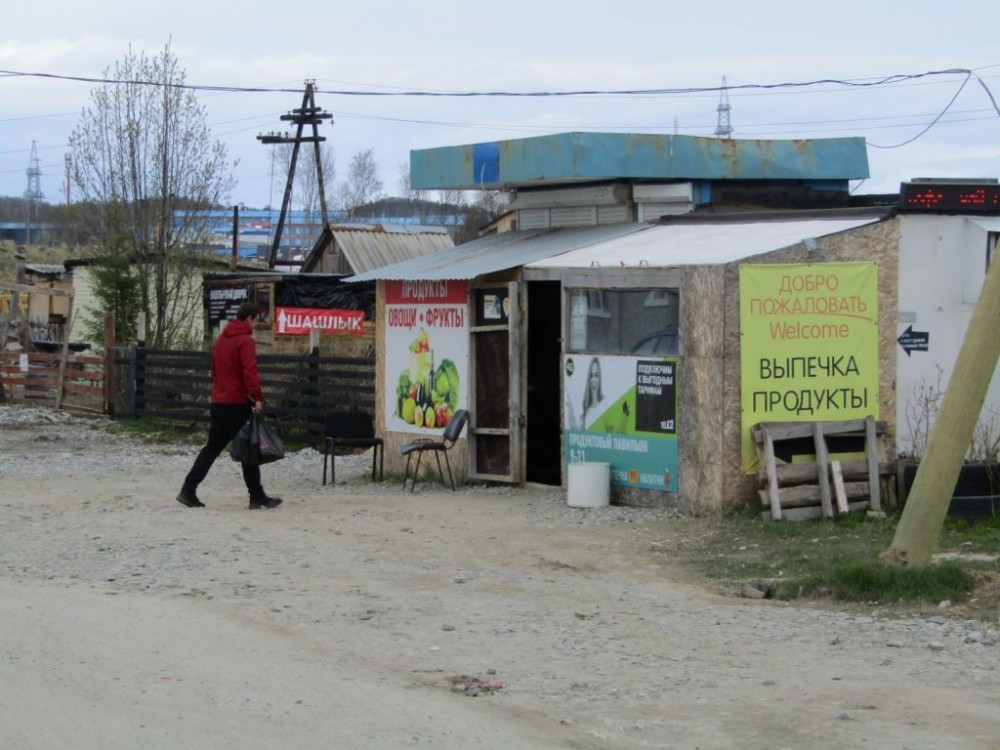 Photo: mmk.news
Photo: mmk.news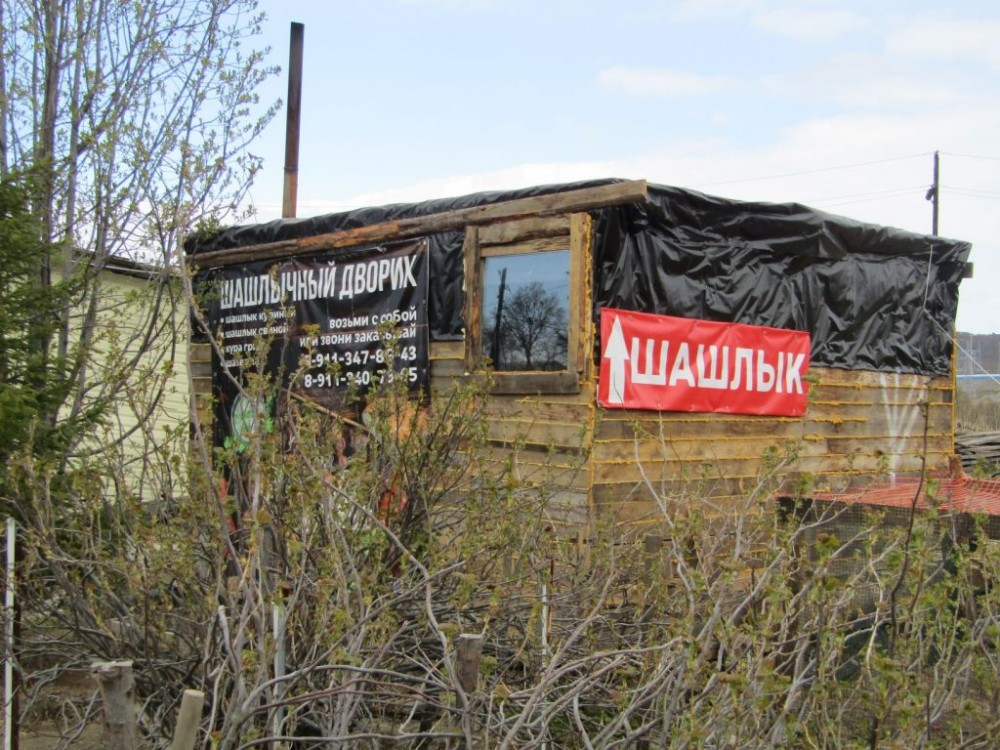 Photo: mmk.news
Photo: mmk.news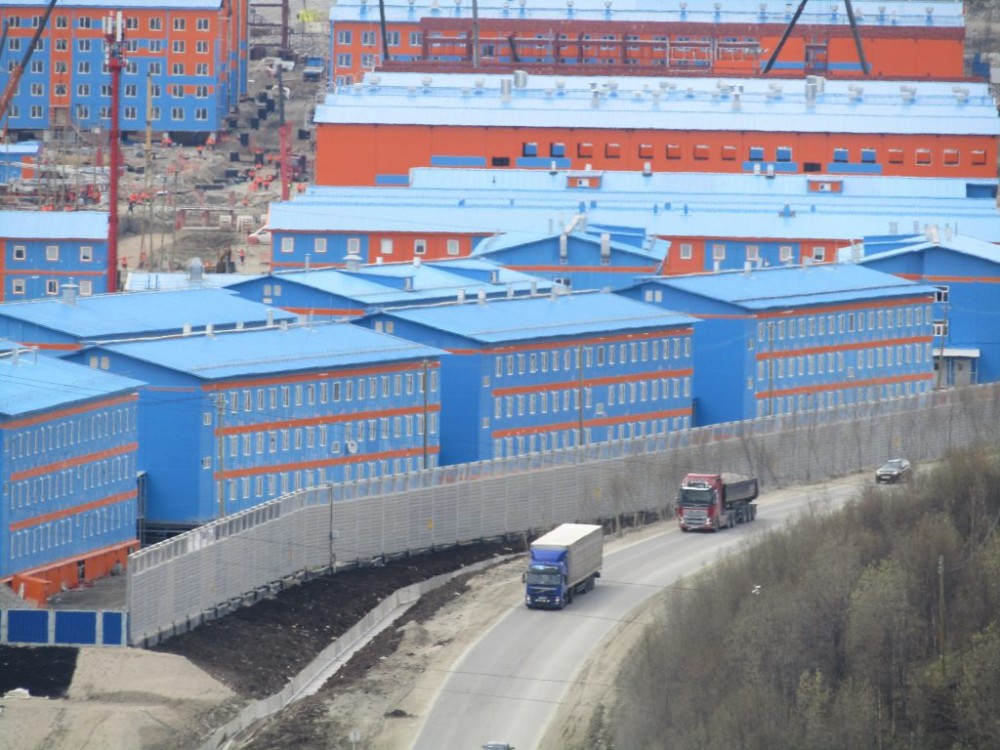 Thousands of workers are living at the construction site in Belokamenka.
Thousands of workers are living at the construction site in Belokamenka.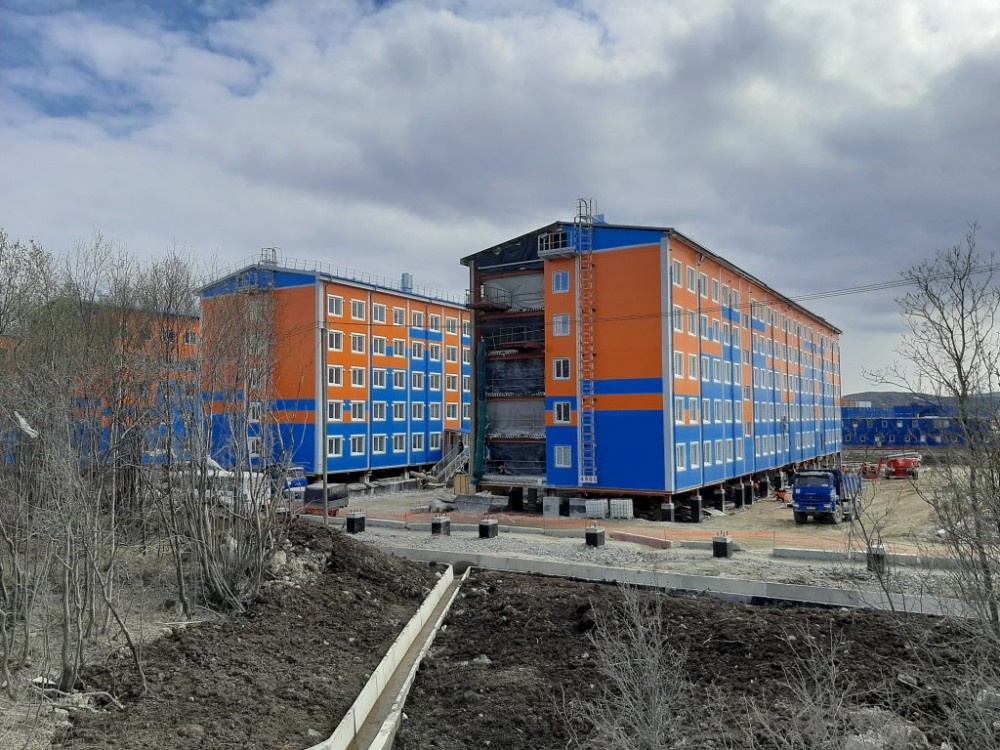 Photo: mmk.news
Photo: mmk.news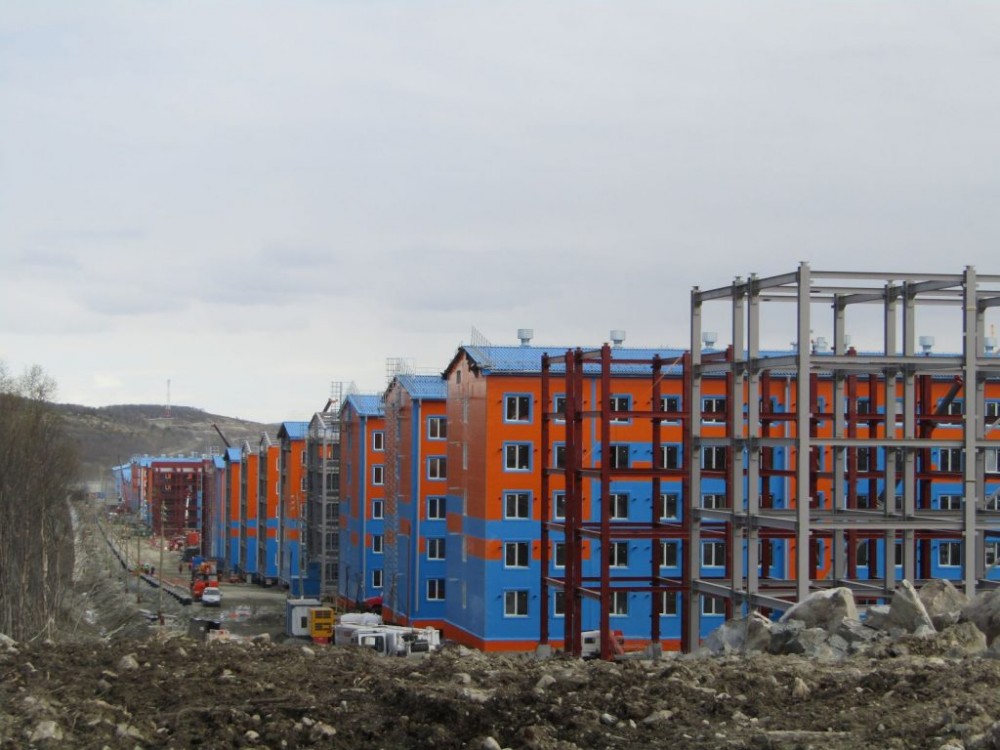 Photo: mmk.news
Photo: mmk.news
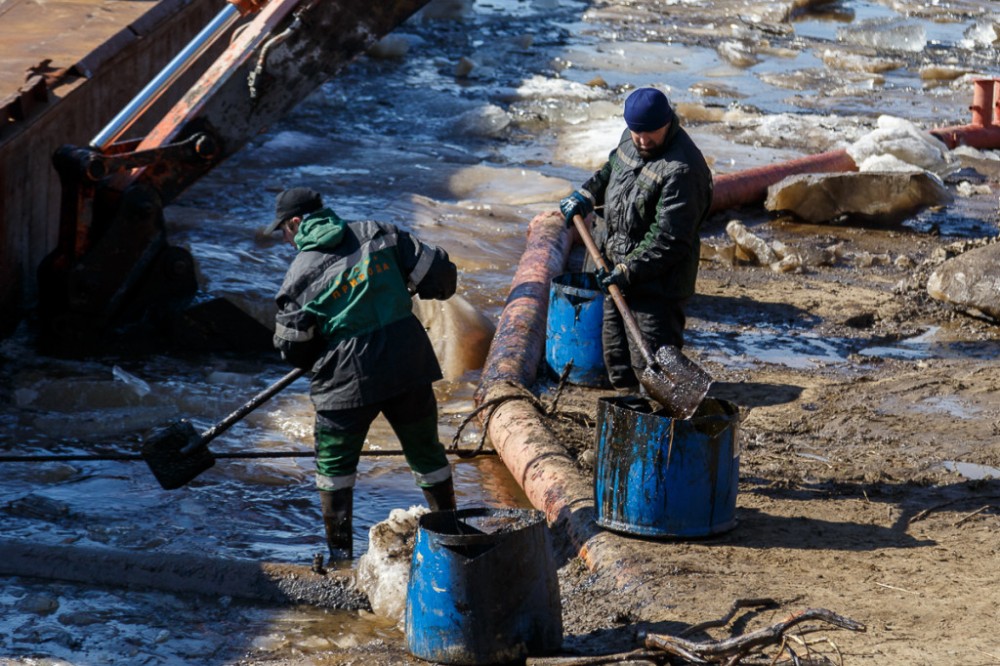 Photo: rkomi.ru
Photo: rkomi.ru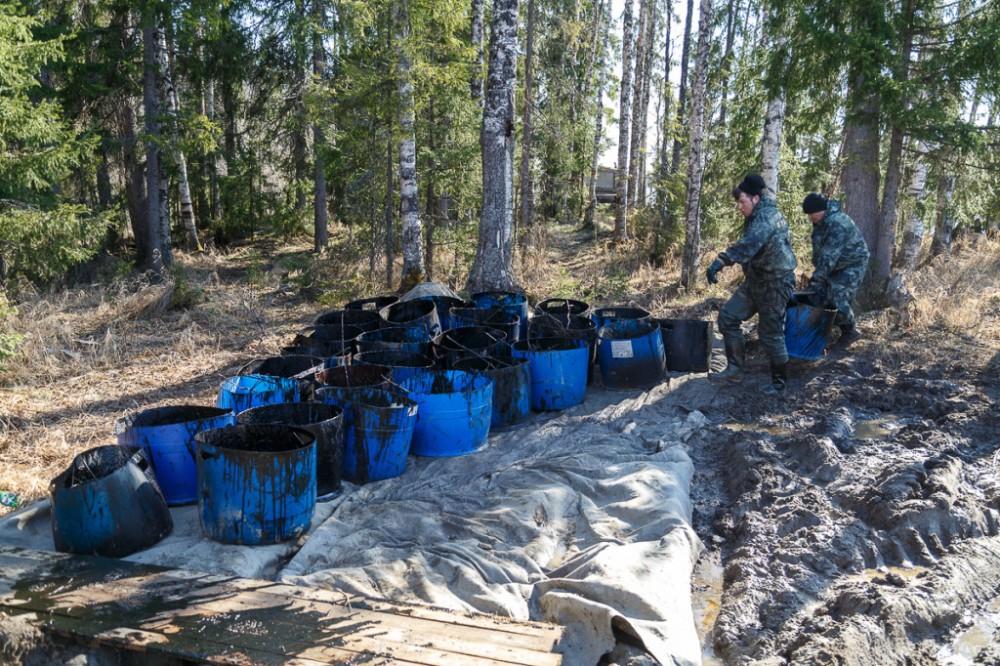 Photo: rkomi.ru
Photo: rkomi.ru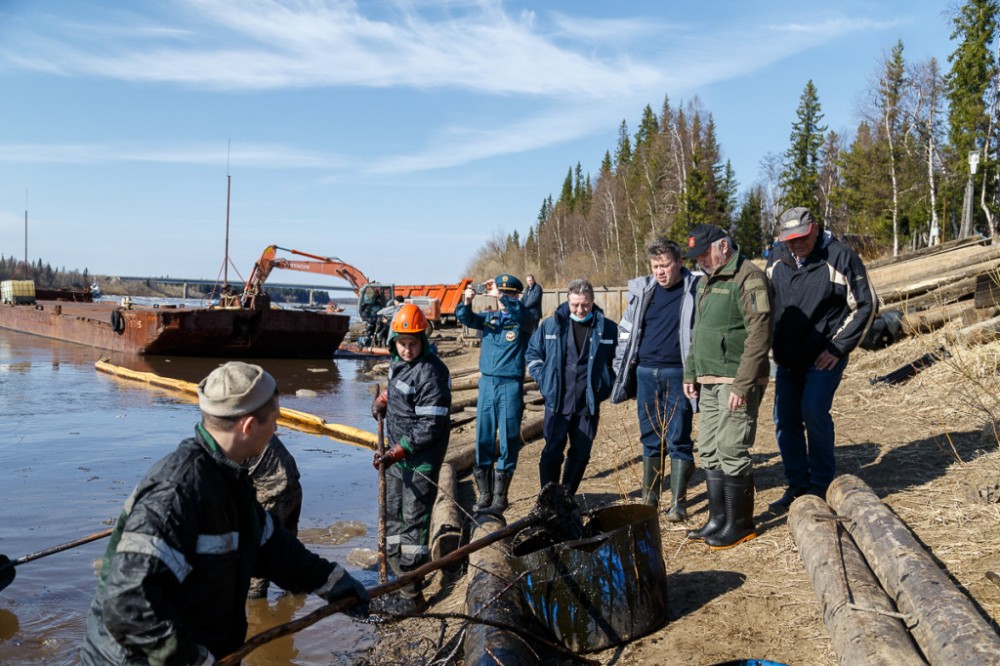 Photo: rkomi.ru
Photo: rkomi.ru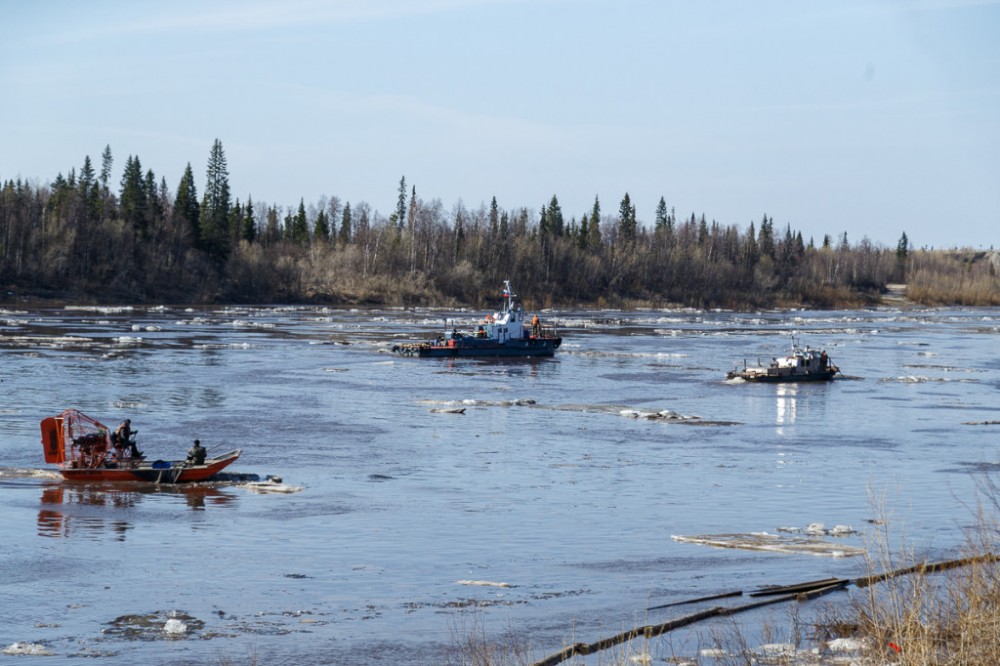 Photo: rkomi.ru
Photo: rkomi.ru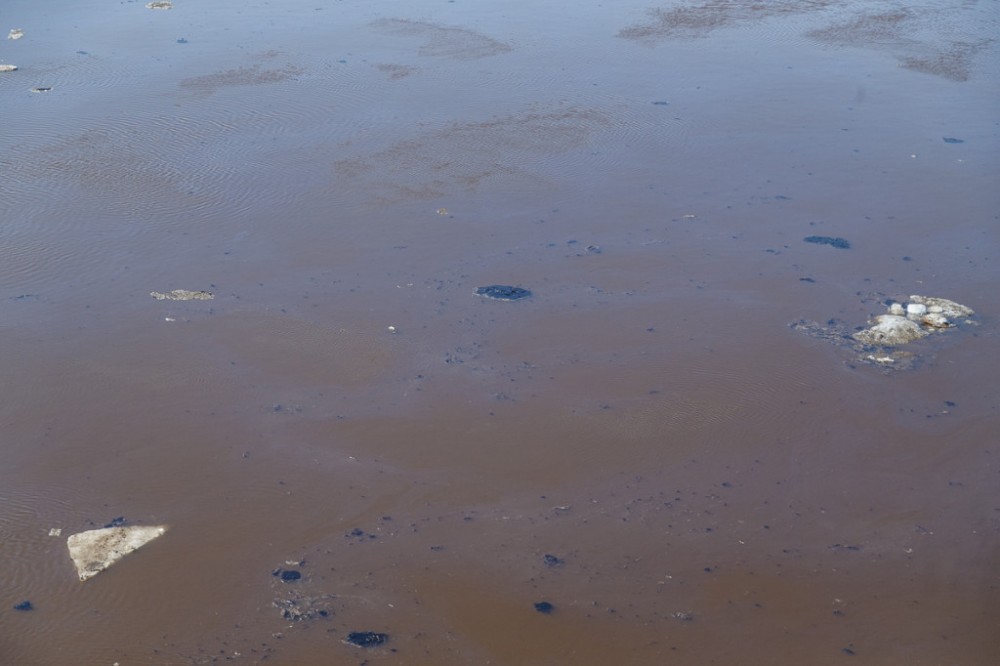 Photo: rkomi.ru
Photo: rkomi.ru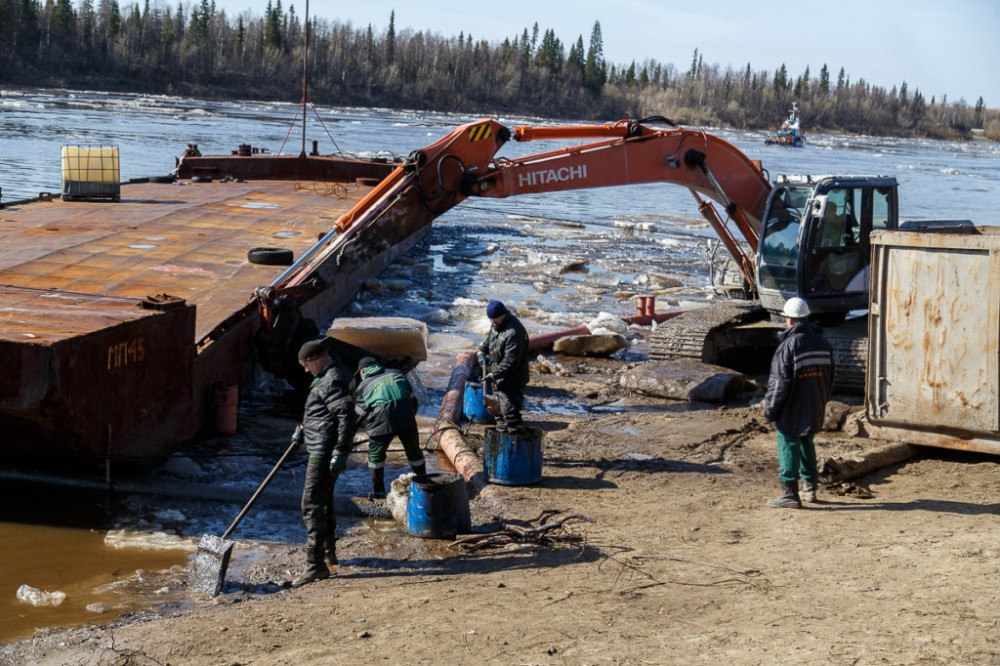 Photo: rkomi.ru
Photo: rkomi.ru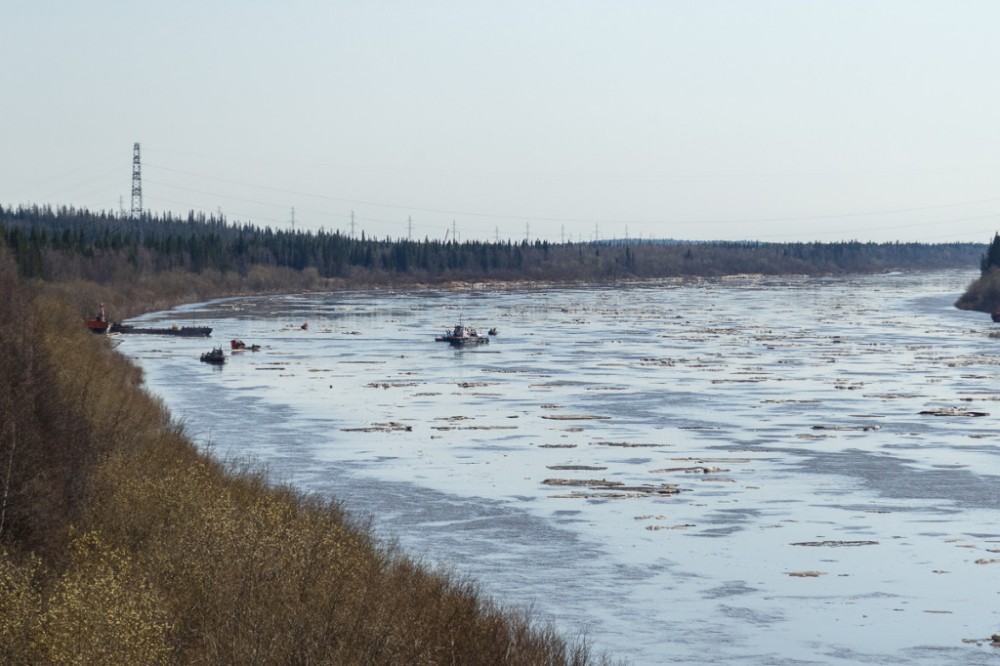 Photo: rkomi.ru
Photo: rkomi.ru Photo: rkomi.ru
Photo: rkomi.ru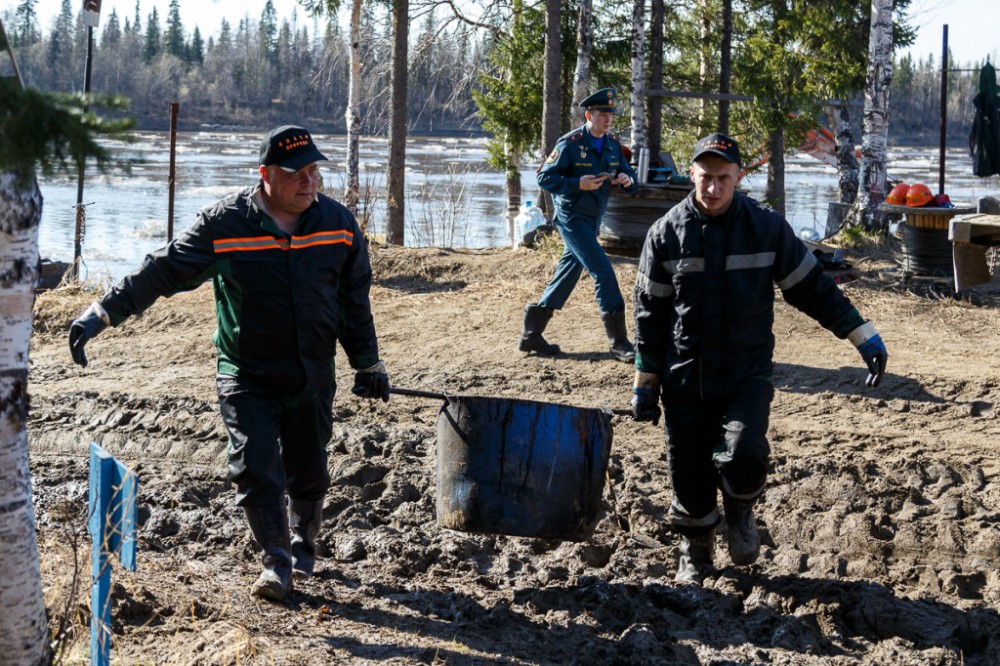 Photo: rkomi.ru
Photo: rkomi.ru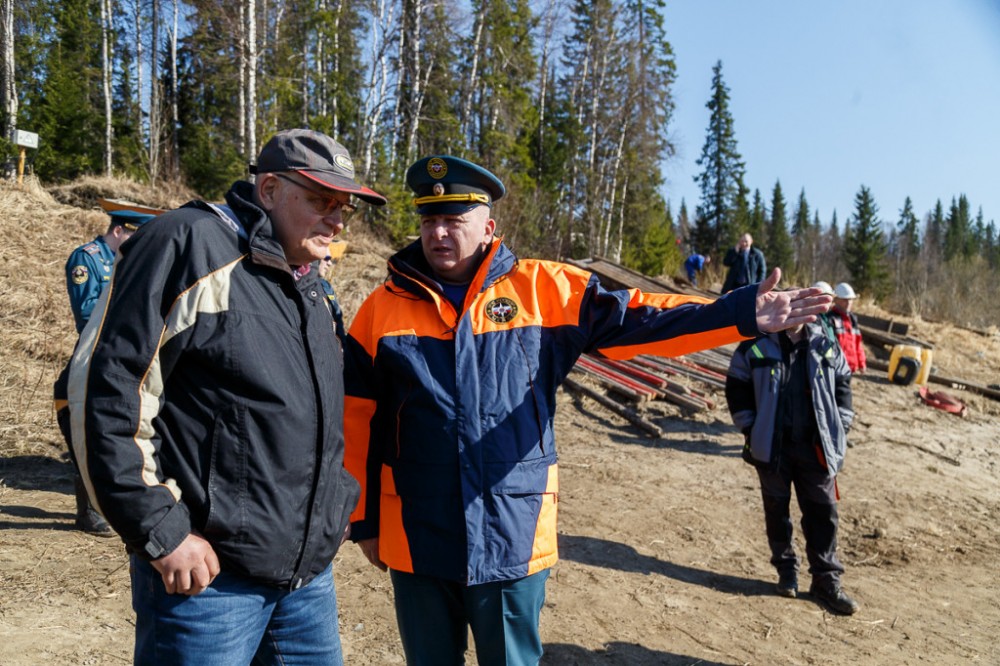 Photo: rkomi.ru
Photo: rkomi.ru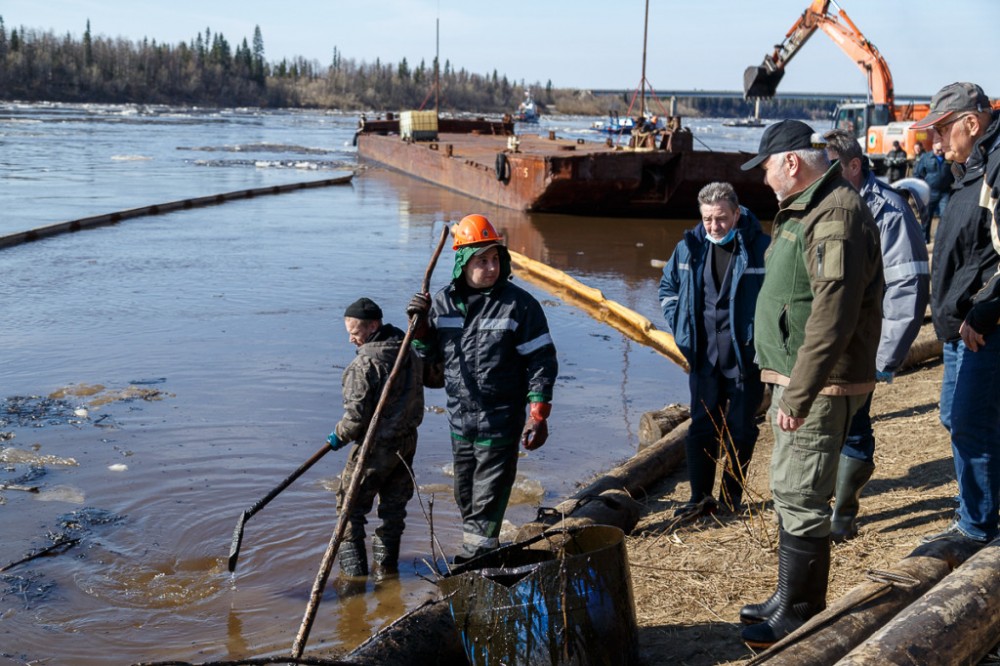 Photo: rkomi.ru
Photo: rkomi.ru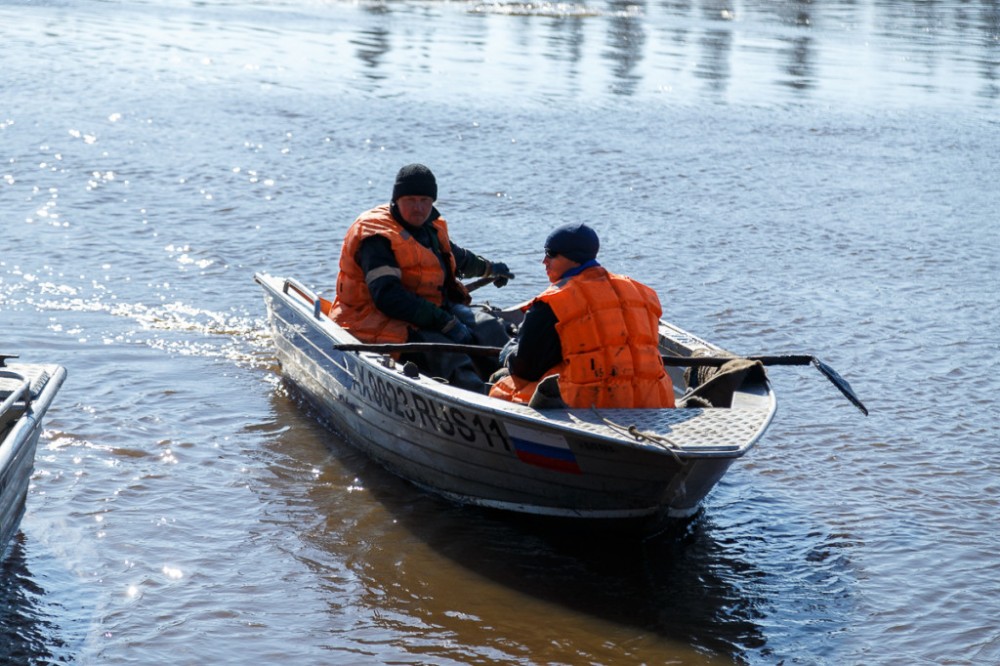 Photo: rkomi.ru
Photo: rkomi.ru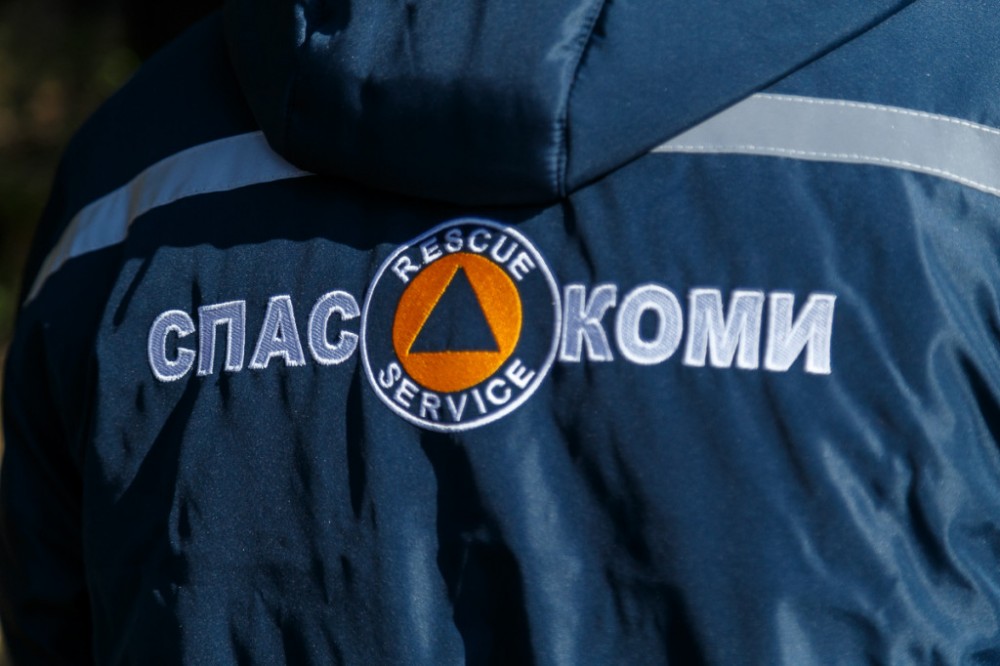 Photo: rkomi.ru
Photo: rkomi.ru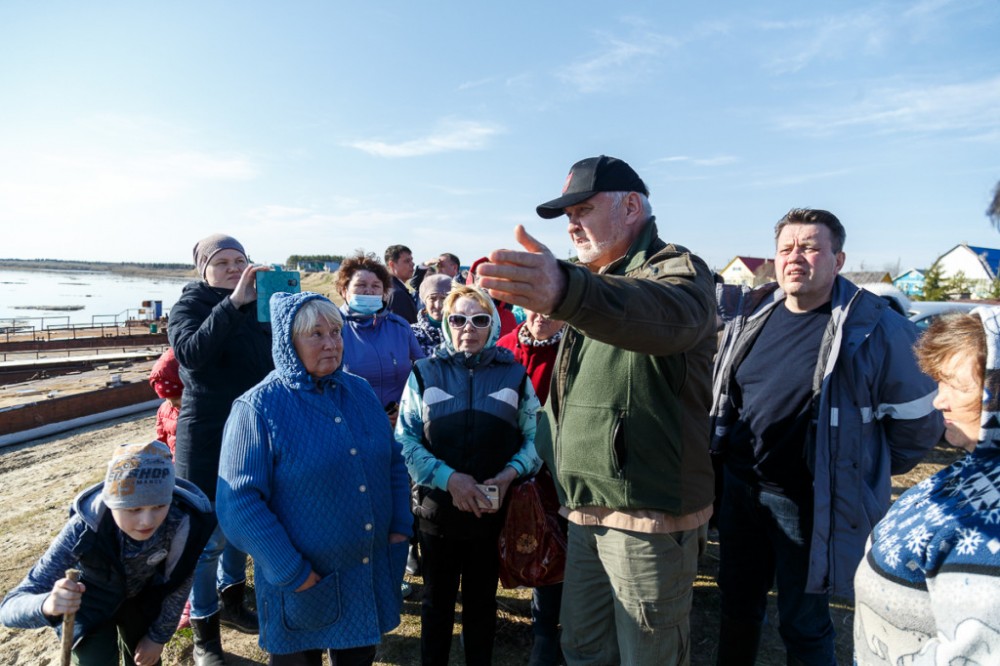 Photo: rkomi.ru
Photo: rkomi.ru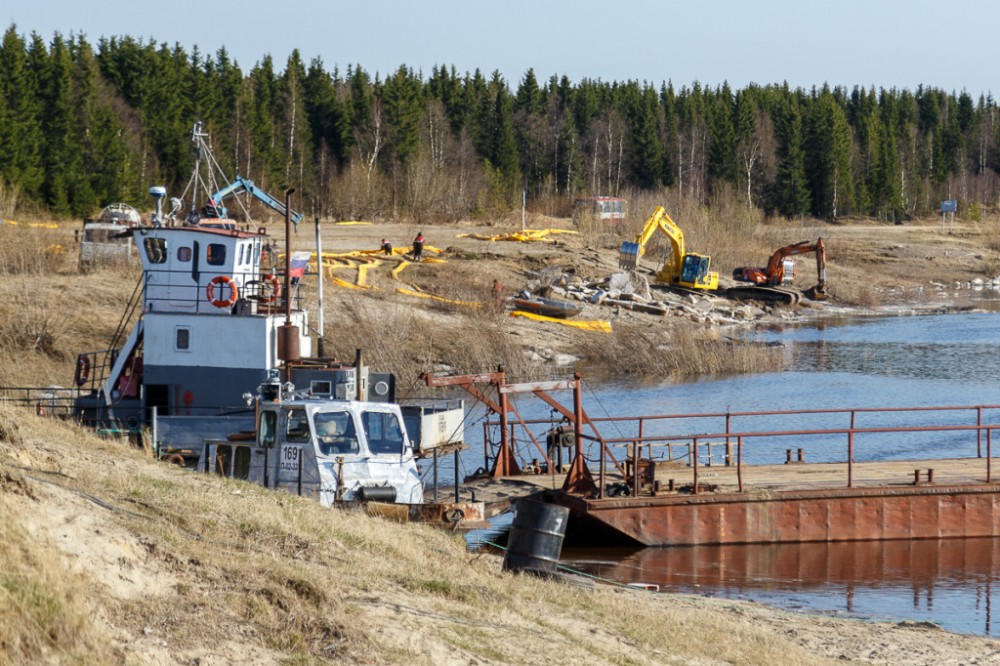 Photo: rkomi.ru
Photo: rkomi.ru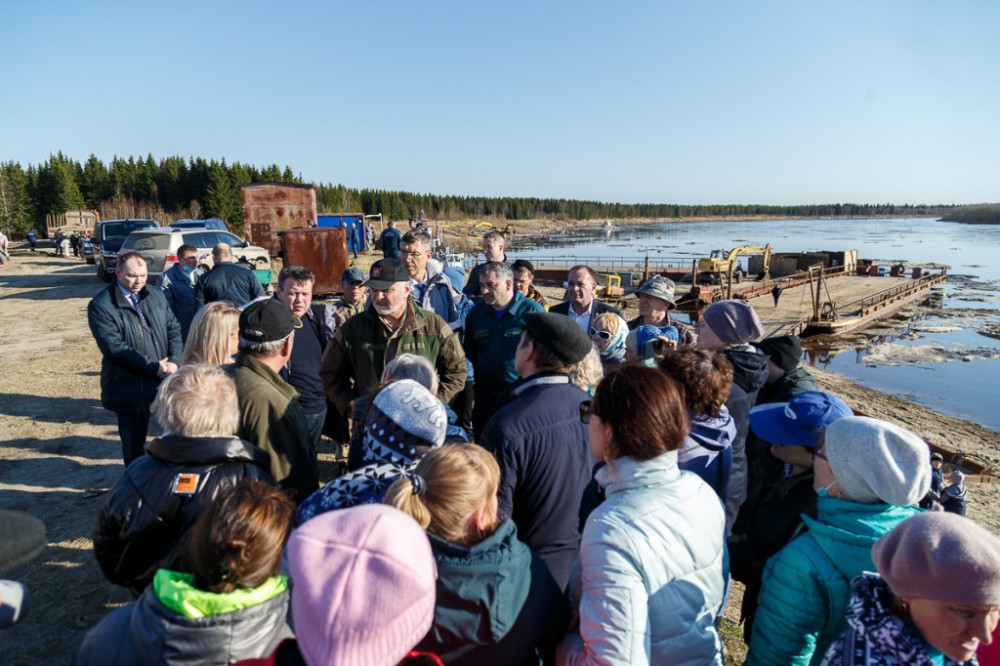 Photo: rkomi.ru
Photo: rkomi.ru
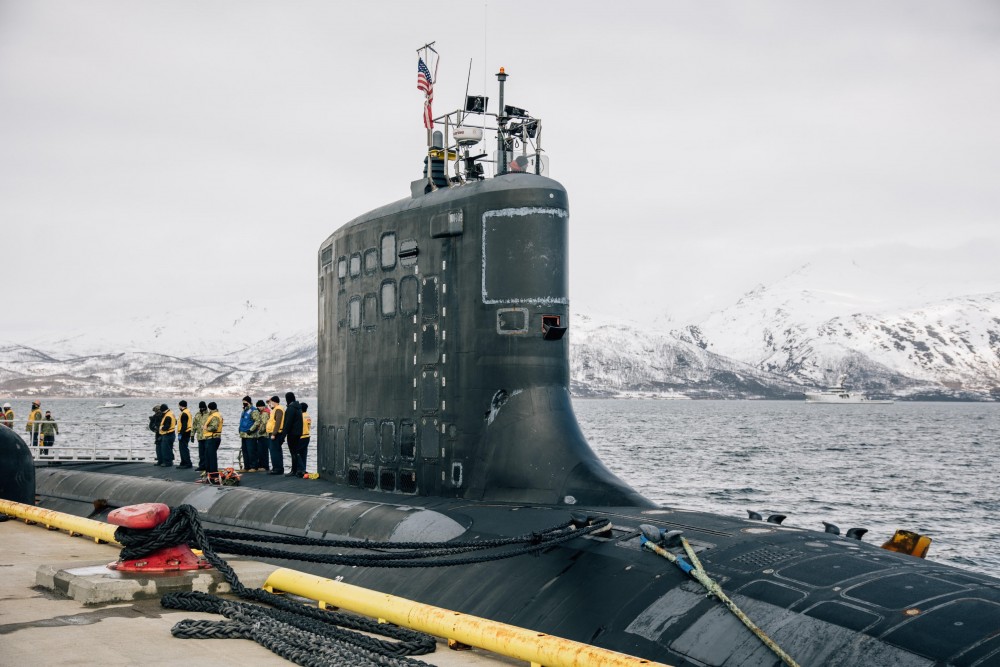 CLICK ON IMAGE FOR GALLERY OF ALL PHOTOS: The port call by USS New Mexico to this municipal harbor in Tromsø is the first of many NATO submarines to change crew and get supplies in the years to come. Photo: Helene Sofie Thorkildsen/Forsvaret
CLICK ON IMAGE FOR GALLERY OF ALL PHOTOS: The port call by USS New Mexico to this municipal harbor in Tromsø is the first of many NATO submarines to change crew and get supplies in the years to come. Photo: Helene Sofie Thorkildsen/Forsvaret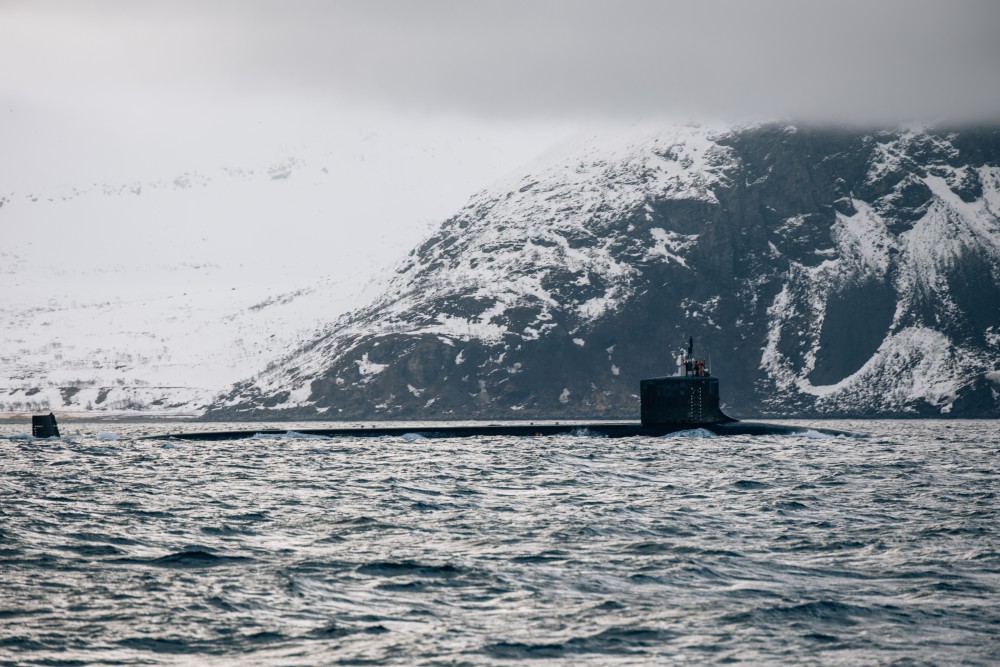 USS New Mexico surfaced early Monday morning outside Troms, northern Norway. Here sailing Lenangen en route to Tromsø. Photo: Helene Sofie Thorkildsen/Forsvaret
USS New Mexico surfaced early Monday morning outside Troms, northern Norway. Here sailing Lenangen en route to Tromsø. Photo: Helene Sofie Thorkildsen/Forsvaret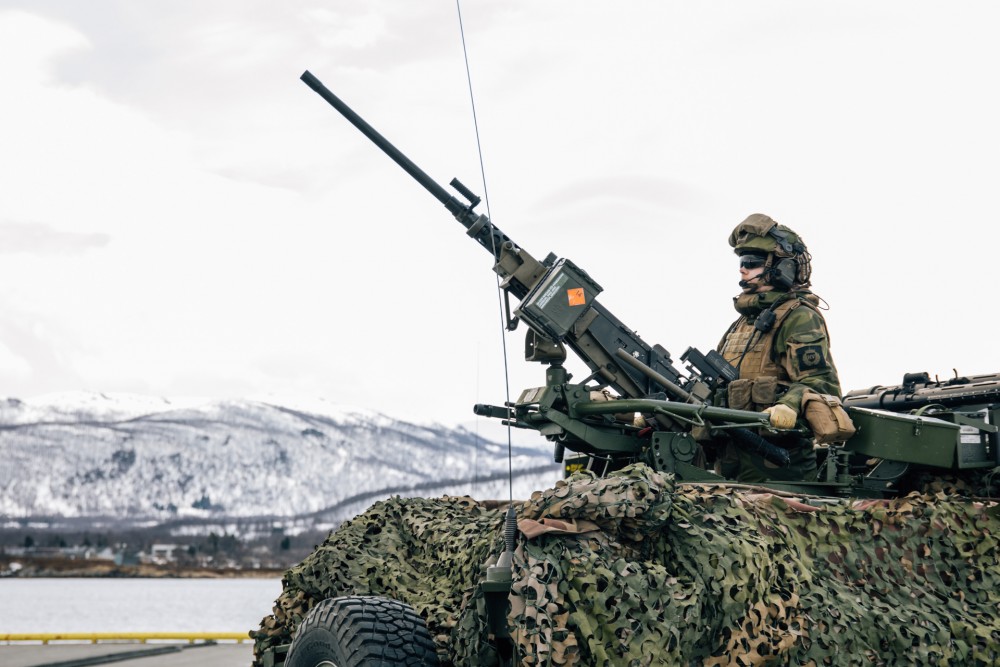 Norwegian military guards at the port of Tønsnes, some 10 kilometers north of Tromsø city center. Photo: Helene Sofie Thorkildsen/Forsvaret
Norwegian military guards at the port of Tønsnes, some 10 kilometers north of Tromsø city center. Photo: Helene Sofie Thorkildsen/Forsvaret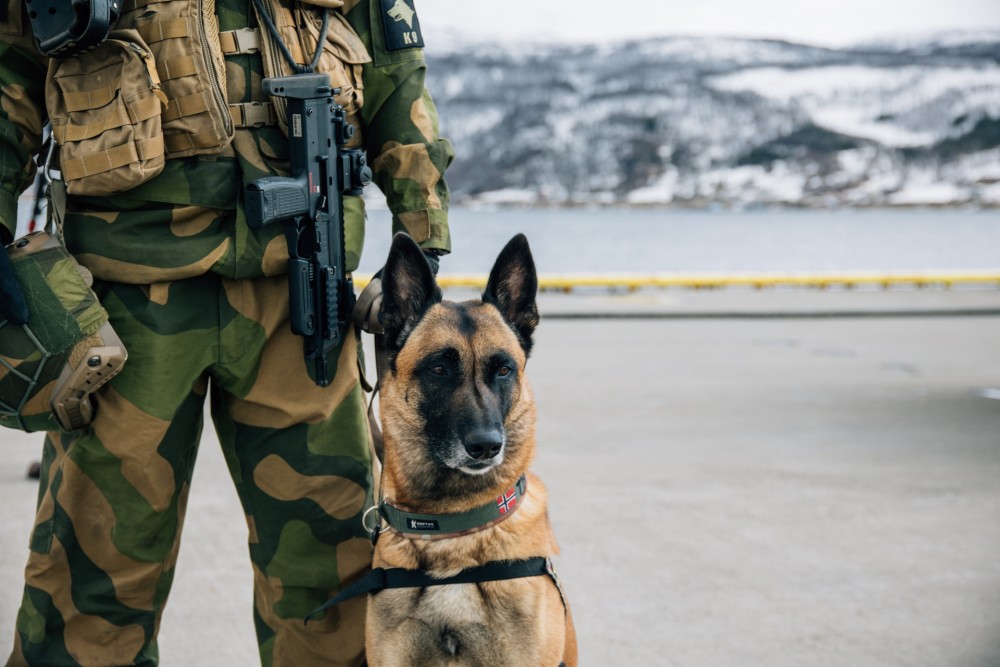 Tønsnes port is a civilian municipal port in Tromsø with military guards during the visit of the American nuclear-powered submarine. Photo: Helene Sofie Thorkildsen/Forsvaret
Tønsnes port is a civilian municipal port in Tromsø with military guards during the visit of the American nuclear-powered submarine. Photo: Helene Sofie Thorkildsen/Forsvaret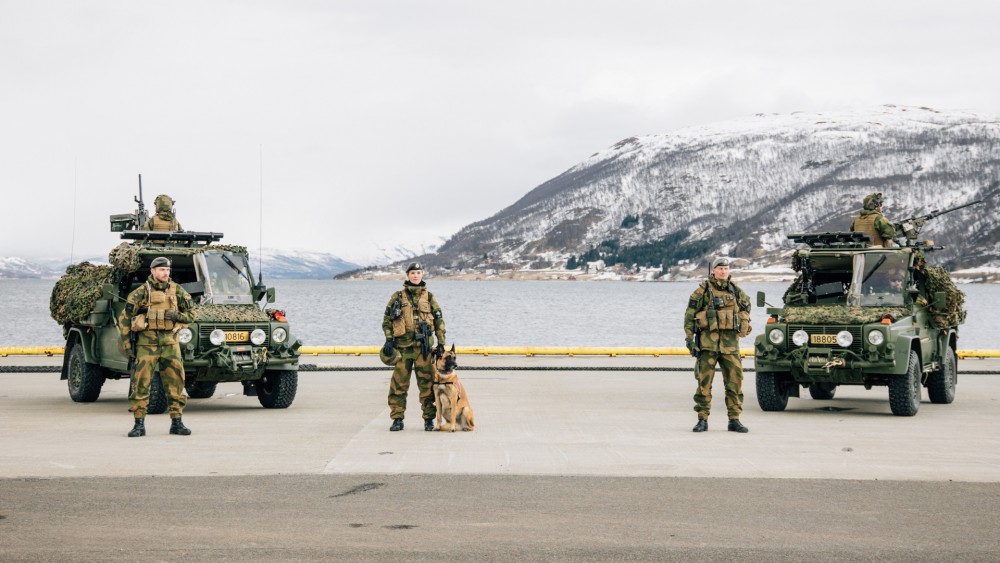 During May 10 to 12, the port of Tønsnes is heavily guarded and there is a no-fly zone in a radius of 1 nautical mile. Photo: Helene Sofie Thorkildsen/Forsvaret
During May 10 to 12, the port of Tønsnes is heavily guarded and there is a no-fly zone in a radius of 1 nautical mile. Photo: Helene Sofie Thorkildsen/Forsvaret Fresh air for the crew for first time after weeks of underwater patrol. Here north of Tromsø Monday morning. Photo: Helene Sofie Thorkildsen/Forsvaret
Fresh air for the crew for first time after weeks of underwater patrol. Here north of Tromsø Monday morning. Photo: Helene Sofie Thorkildsen/Forsvaret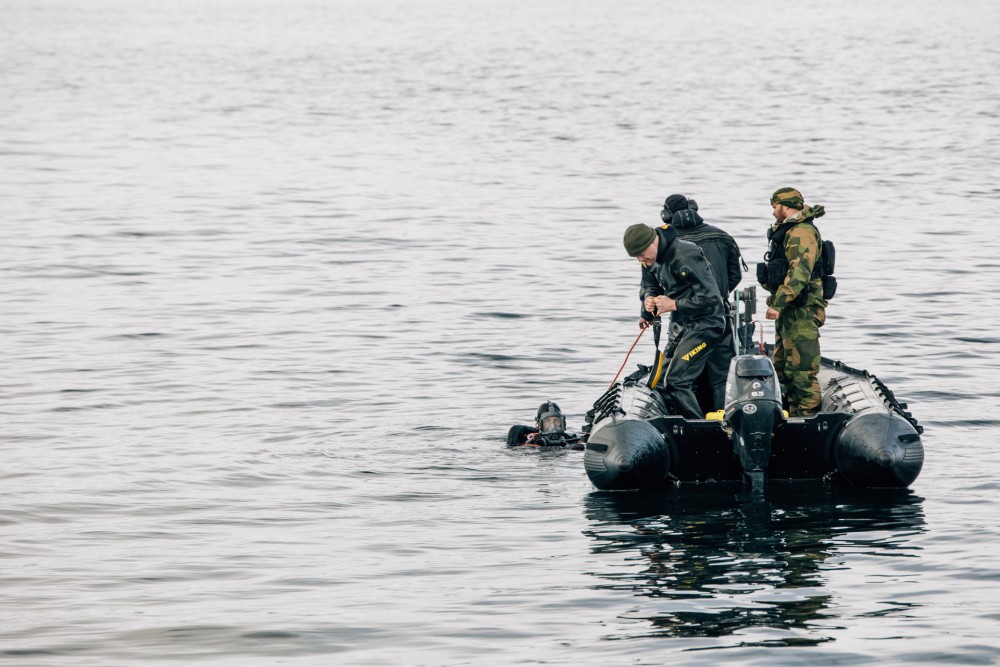 Norwegian special navy forces dive near the port of Tønsnes to secure the waters before the arrival of the American nuclear submarine. Photo: Helene Sofie Thorkildsen/Forsvaret
Norwegian special navy forces dive near the port of Tønsnes to secure the waters before the arrival of the American nuclear submarine. Photo: Helene Sofie Thorkildsen/Forsvaret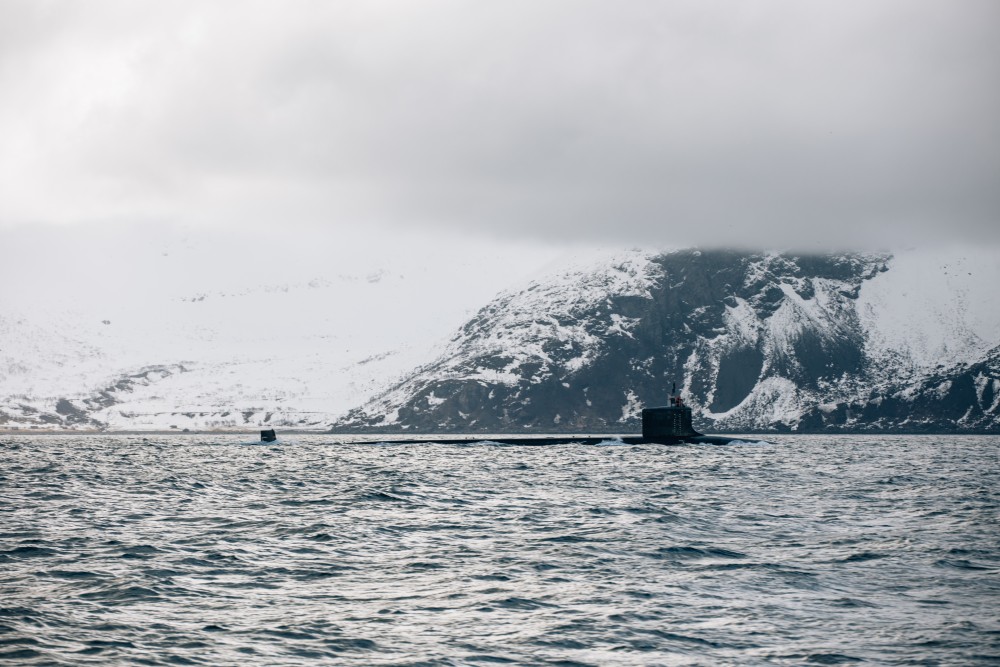 The USS New Mexico (SSN 779) is of the Virginia class fast attack submarines. The 115 meters long vessel has a crew of 130 and is powered by one reactor. The sub was commissioned in 2010 as the sixth in its class, which so far consists of 19 vessels. Photo: Helene Sofie Thorkildsen/Forsvaret
The USS New Mexico (SSN 779) is of the Virginia class fast attack submarines. The 115 meters long vessel has a crew of 130 and is powered by one reactor. The sub was commissioned in 2010 as the sixth in its class, which so far consists of 19 vessels. Photo: Helene Sofie Thorkildsen/Forsvaret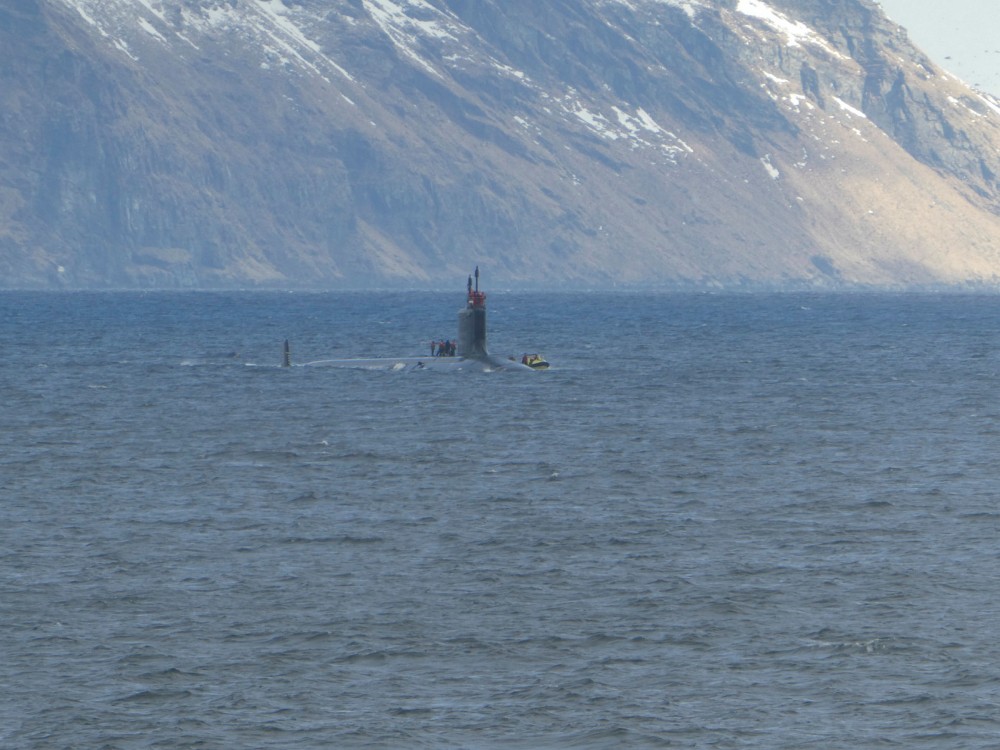 The US submarine is escorted inshore by the Norwegian Coast Guard. Photo: Kystvakten
The US submarine is escorted inshore by the Norwegian Coast Guard. Photo: Kystvakten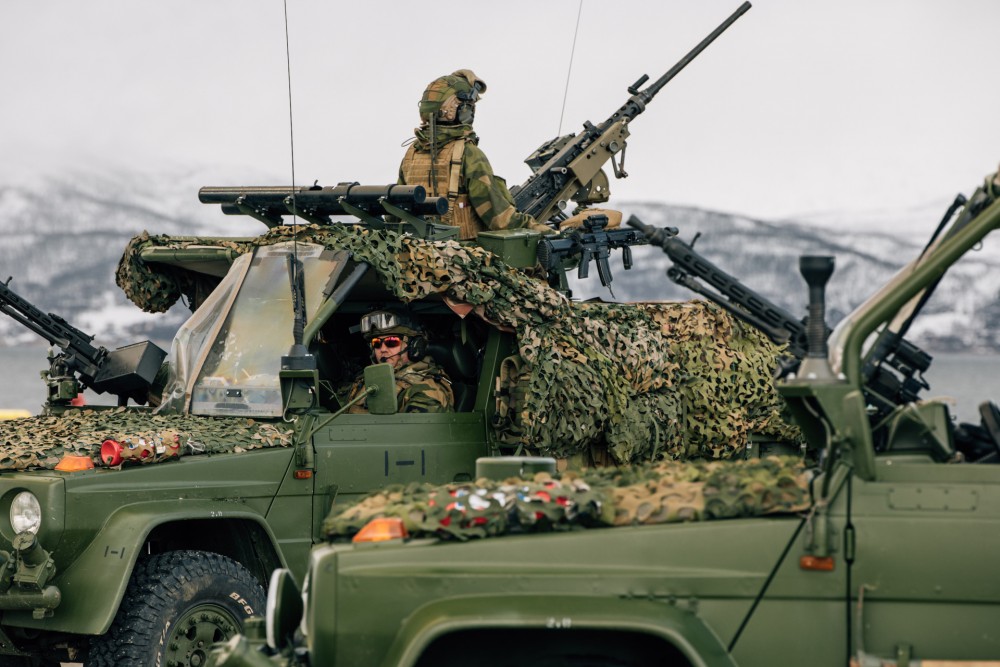 This is the first time an NATO nuclear-powered submarine makes port call to a civilian harbor in northern Norway. The guarding and security is comprehensive. In the future, Tønsnes port near Tromsø will have some 3 to 4 port calls by nuclear subs annually, the Norwegian Defense officials inform. Photo: Helene Sofie Thorkildsen/Forsvaret
This is the first time an NATO nuclear-powered submarine makes port call to a civilian harbor in northern Norway. The guarding and security is comprehensive. In the future, Tønsnes port near Tromsø will have some 3 to 4 port calls by nuclear subs annually, the Norwegian Defense officials inform. Photo: Helene Sofie Thorkildsen/Forsvaret The Virginia-class USS New Mexico. Photo: Helene Sofie Thorkildsen/Forsvaret
The Virginia-class USS New Mexico. Photo: Helene Sofie Thorkildsen/Forsvaret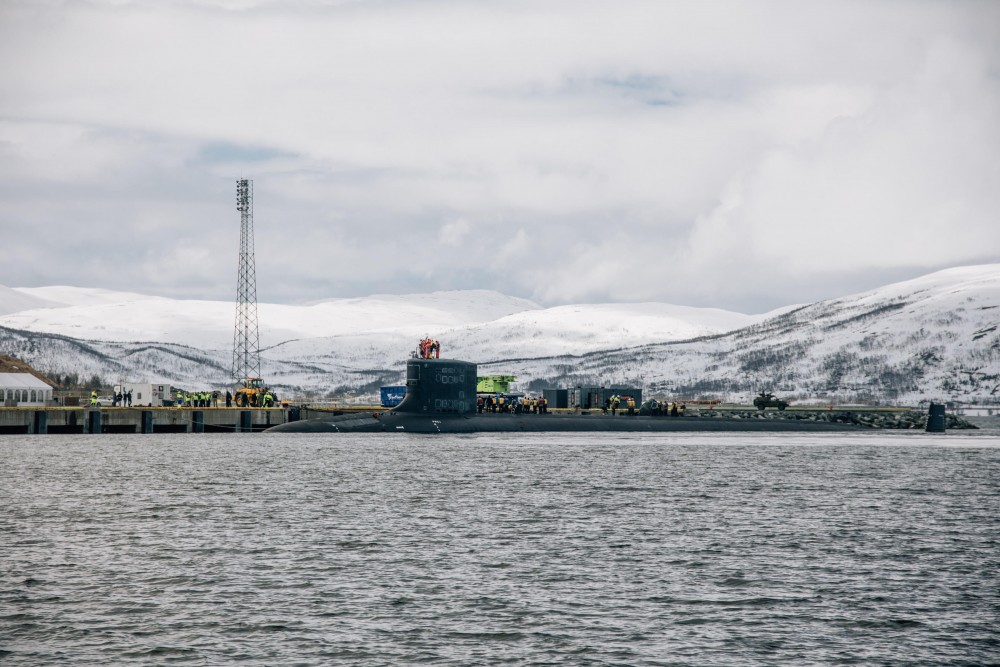 Tønsnes harbor just north of Tromsø is a civilian municipal harbor where Norway has given green light for NATO submarines to dock. Photo: Helene Sofie Thorkildsen/Forsvaret
Tønsnes harbor just north of Tromsø is a civilian municipal harbor where Norway has given green light for NATO submarines to dock. Photo: Helene Sofie Thorkildsen/Forsvaret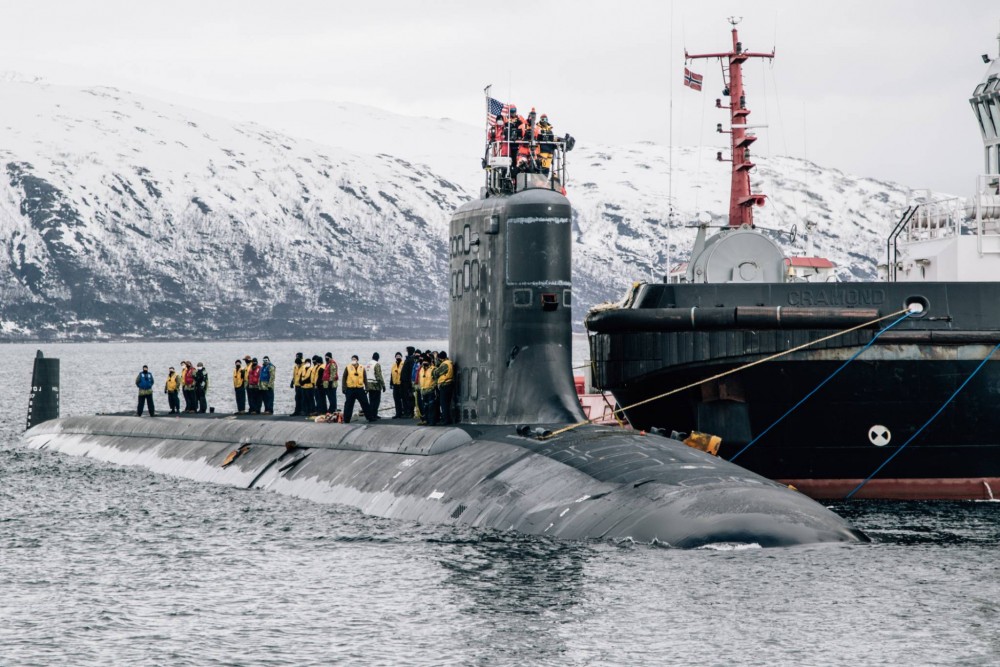 Photo: Jonny Karlsen / Forsvaret
Photo: Jonny Karlsen / Forsvaret
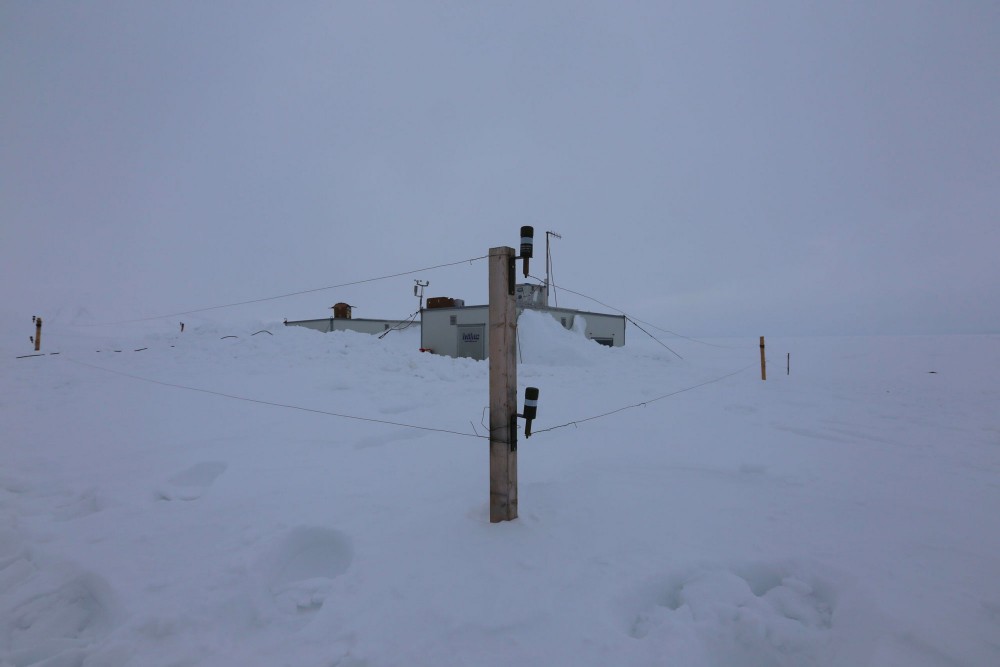 Securing a cabin against marauding polar bears requires sturdy materials. This cabin at Mushamna in Woodfjorden in Spitsbergen’s far north is well protected. Photo: Magnus Andersen / Norwegian Polar Institute.
Securing a cabin against marauding polar bears requires sturdy materials. This cabin at Mushamna in Woodfjorden in Spitsbergen’s far north is well protected. Photo: Magnus Andersen / Norwegian Polar Institute.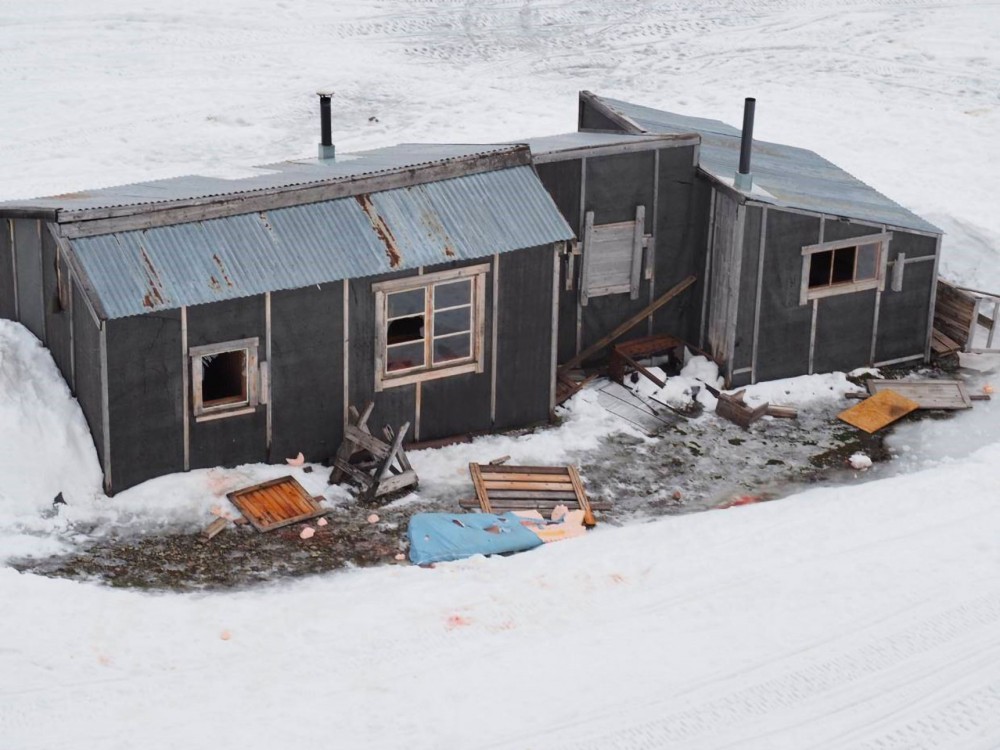 This cabin in Skansbukta about 40 kilometres from Longyearbyen was demolished by a visiting polar bear and her one-year-old cub in April 2019. The bear broke several windows, dragged out the mattresses and tore them to shreds. The same two bears visited several other cabins in the area that spring. Photo: Jon Aars / Norwegian Polar Institute
This cabin in Skansbukta about 40 kilometres from Longyearbyen was demolished by a visiting polar bear and her one-year-old cub in April 2019. The bear broke several windows, dragged out the mattresses and tore them to shreds. The same two bears visited several other cabins in the area that spring. Photo: Jon Aars / Norwegian Polar Institute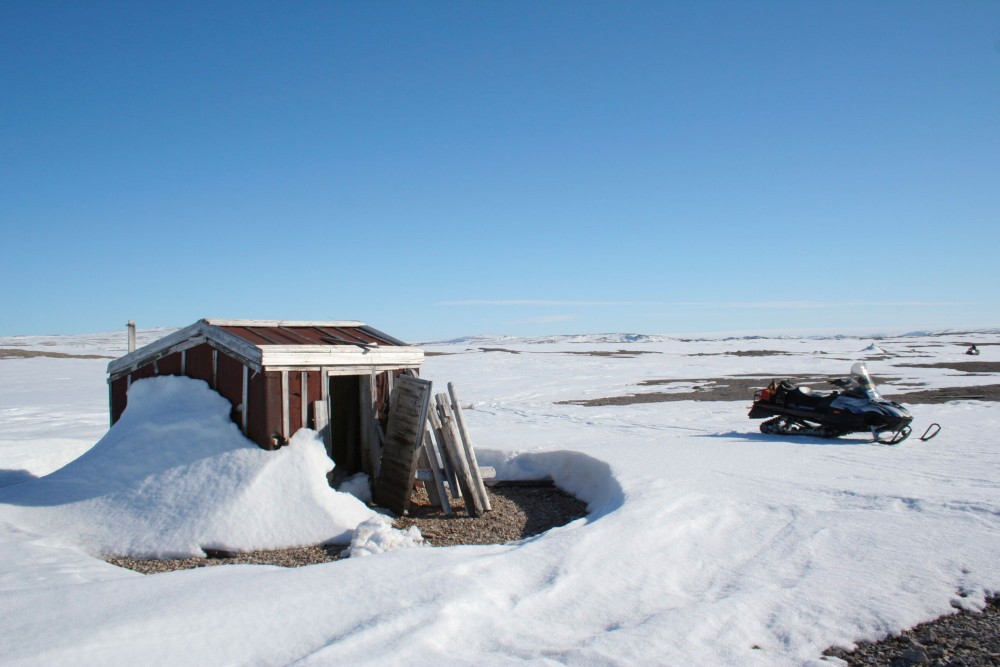 Bears often visit uninhabited cabins, where they often may destroy doors and windows, leaving the cabins exposed to the elements. Photo: Magnus Andersen / Norwegian Polar Institute
Bears often visit uninhabited cabins, where they often may destroy doors and windows, leaving the cabins exposed to the elements. Photo: Magnus Andersen / Norwegian Polar Institute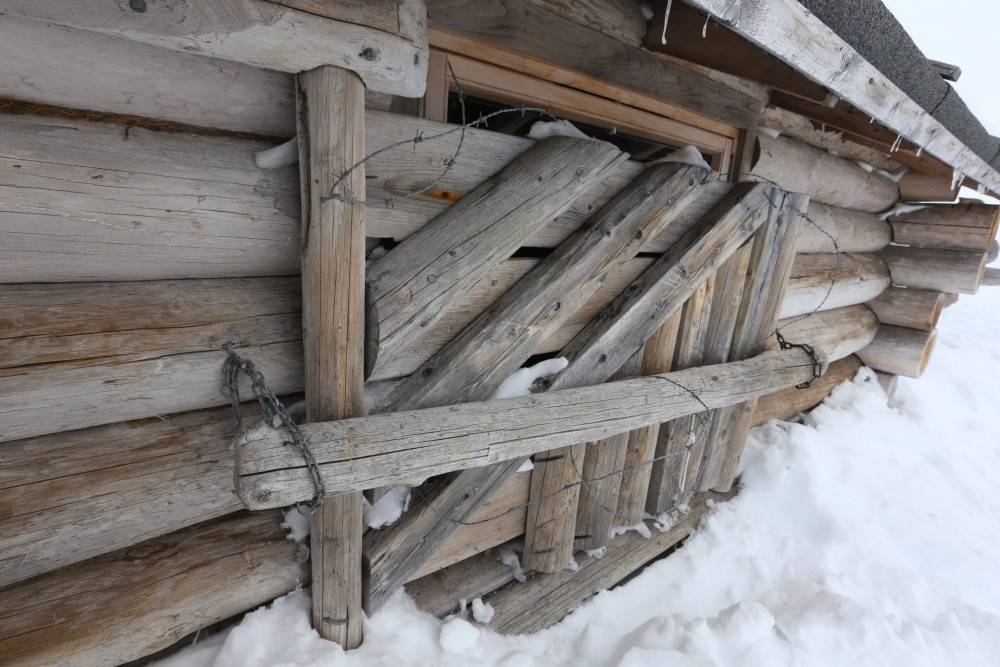 Securing a cabin against marauding polar bears requires sturdy materials. This cabin at Mushamna in Woodfjorden in Spitsbergen’s far north is well protected. Photo: Magnus Andersen / Norwegian Polar Institute.
Securing a cabin against marauding polar bears requires sturdy materials. This cabin at Mushamna in Woodfjorden in Spitsbergen’s far north is well protected. Photo: Magnus Andersen / Norwegian Polar Institute.
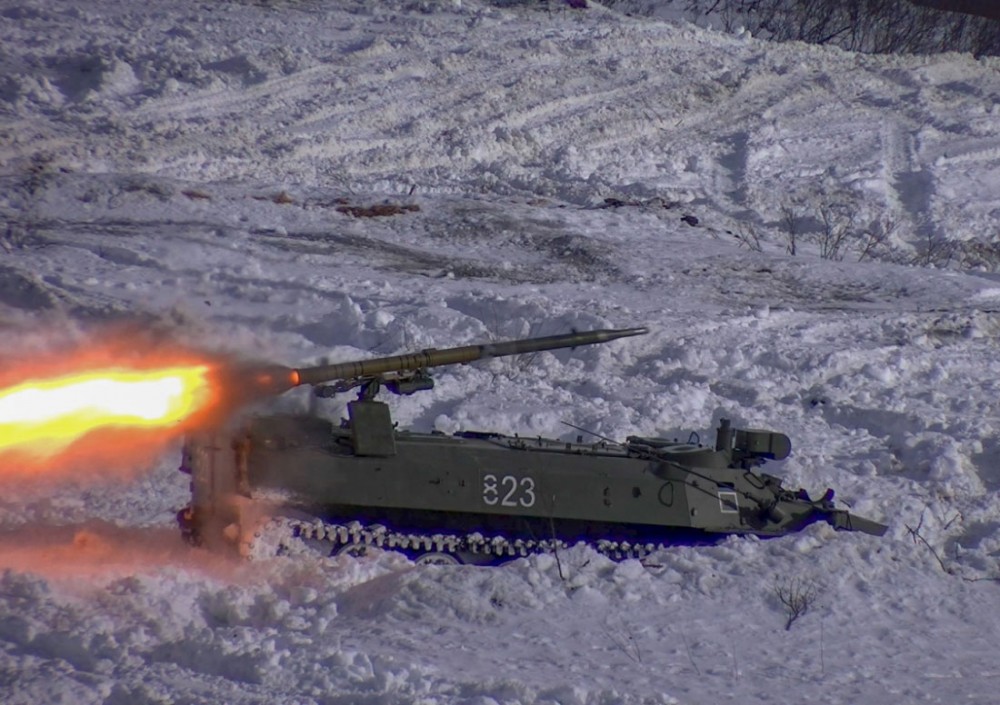 Photo: mil.ru
Photo: mil.ru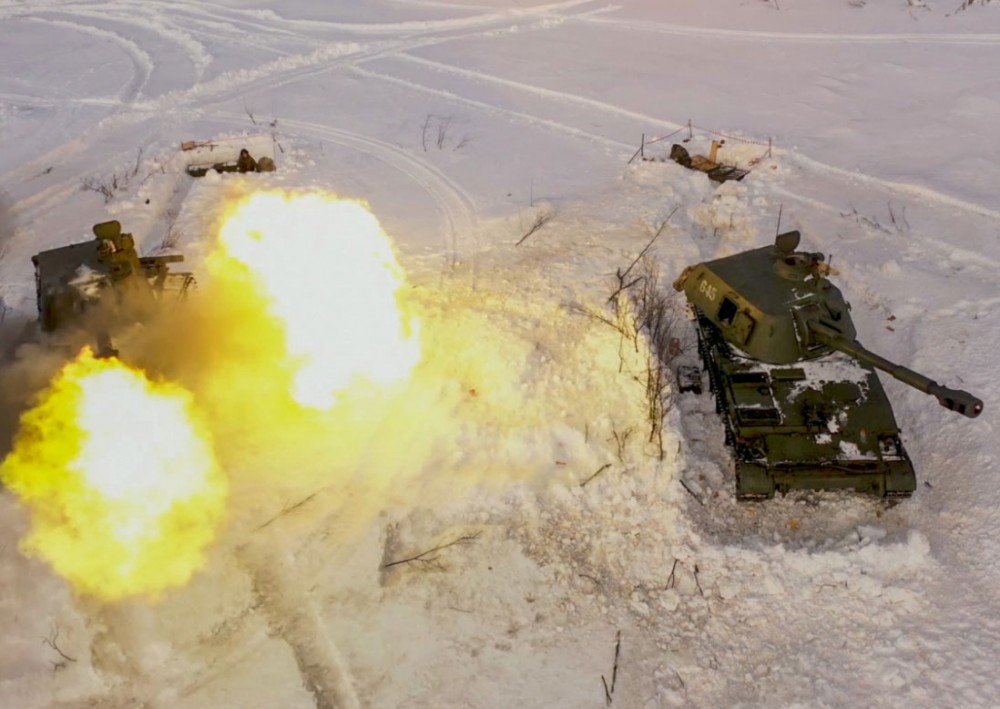 Photo: Mil.ru
Photo: Mil.ru Photo: mil.ru
Photo: mil.ru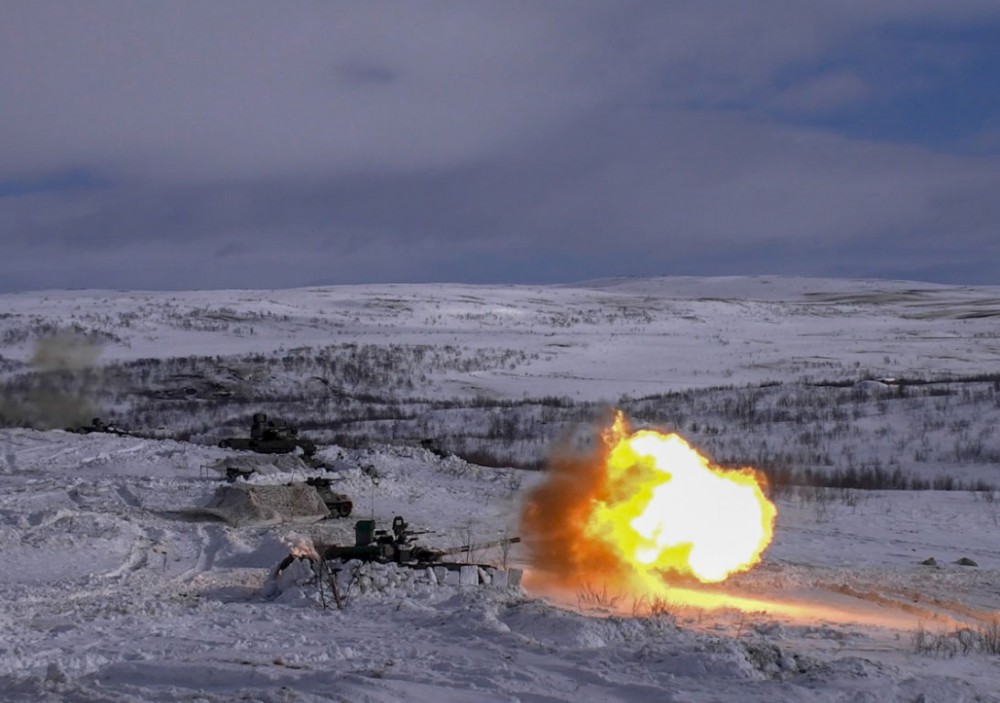 Photo: mil.ru
Photo: mil.ru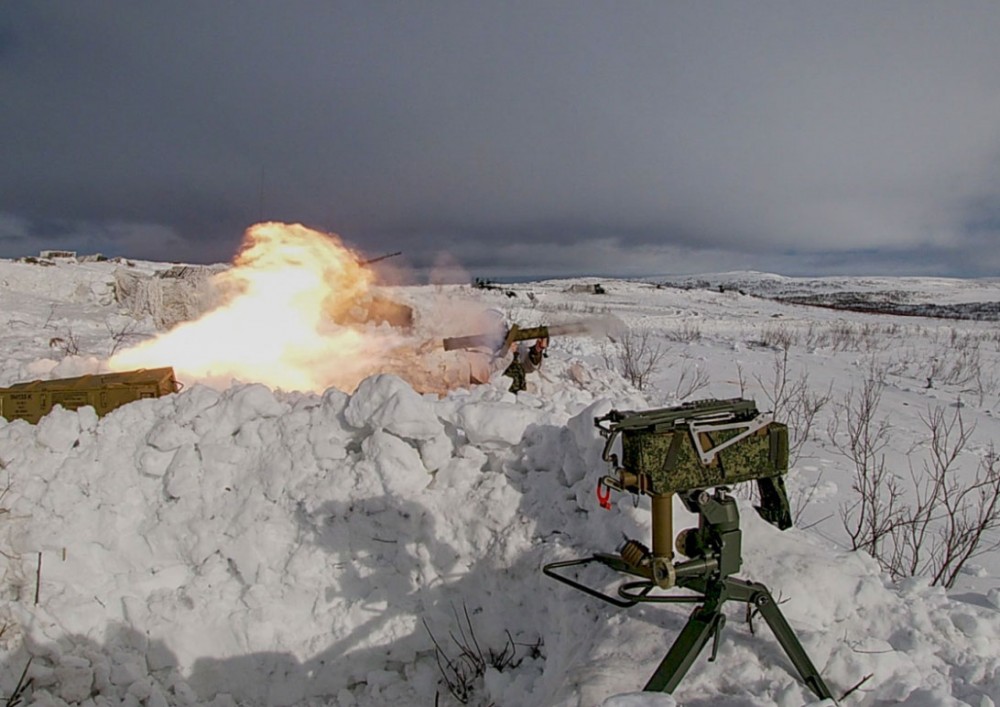 Photo: mil.ru
Photo: mil.ru

